
MANUEL UTILISATEUR
Auteurs du manuel : Willem Ferguson, Jacco van Koll, Dirk Hohndel, Reinout Hoornweg, Linus Torvalds, Miika Turkia, Amit Chaudhuri, Jan Schubert, Salvador Cuñat, Pedro Neves
Version 4.5, Octobre 2015
Bienvenue en tant qu’utilisateur de Subsurface, un programme avancé d’enregistrement de plongées (carnet de plongées) avec une bonne infrastructure pour décrire, organiser, interpréter et imprimer des plongées en scaphandre et en apnée. Subsurface offre de nombreux avantages par rapport à d’autres solutions logicielles similaires :
-
Avez-vous besoin d’une façon d’enregistrer vos plongées utilisant des équipements loisirs, même sans utiliser d’ordinateur de plongée ?
-
Utilisez-vous deux marques différentes d’ordinateurs de plongée, chacun avec son propre logiciel propriétaire pour télécharger les enregistrements des plongées ? Plongez-vous avec un recycleur ou un équipement en circuit ouvert ou de loisir ? Utilisez-vous un enregistreur de profondeur et de durée Reefnet Sensus avec un ordinateur de plongée ? Subsurface offre une interface standard pour télécharger les enregistrements des plongées à partir de tous ces équipements de plongée, en enregistrant et en analysant ces enregistrements dans un système unique.
-
Utilisez-vous plus d’un système d’exploitation ? Subsurface est intégralement compatible avec Mac, Linux et Windows, ce qui vous permet d’accéder à vos enregistrements de plongées sur chaque système d’exploitation en utilisant une application unique.
-
Utilisez-vous Linux ou Mac mais votre ordinateur de plongée n’a que des logiciels pour Windows pour télécharger les informations de plongées (par exemple Mares) ? Subsurface fournit un moyen de télécharger et d’analyser vos enregistrements de plongées sur d’autres systèmes d’exploitation.
-
Avez-vous besoin d’un planificateur de plongée graphique intuitif qui intègre et prend en compte les plongées qui ont déjà été enregistrées ? Avez-vous besoin d’un moyen d’nregistrer et de sauvegarder vos plongées sur Internet, vous permettant de les voir depuis n’importe où en utilisant un navigateur Internet ? Subsurface est disponible pour Windows (Win XP ou plus récent), les Macs basés sur processeurs Intel (OS/X) et de nombreuses distributions Linux. Subsurface peut être compilé pour bien plus de plateformes matérielles et d’environnements logiciels où Qt et libdivecomputer sont disponibles.
Ce manuel explique comment utiliser le programme Subsurface. Pour installer le logiciel, consultez la page Téléchargement sur le site web de Subsurface. En cas de problème, vous pouvez envoyer un e-mail sur notre liste de diffusion et rapportez les bogues sur notre bugtracker. Pour des instructions de compilation du logiciel et (si besoin) de ses dépendances, merci de consulter le fichier INSTALL inclus dans les sources logicielles.
Public : Plongeurs loisirs, apnéistes, plongeurs Tek et plongeurs professionnels
1. Utilisation de ce manuel
When opened from within Subsurface, this manual does not have external controls for paging or selecting previous pages. However, two facilities are provided:
The SEARCH function is activated by pressing control-F or command-F on the keyboard. A text box appears at the bottom right-hand of the window (see image below). For instance, typing the word "weights" into the search text box, searches throughout the user manual. To the right of the search text box are two arrows pointing up and down. These find the previous and the next occurrence of the search term.

PREVIOUS/NEXT LINK. Move between links (underlined words that jump to specific sections in the user manual) by right-clicking on the text of the manual. This brings up a context menu to PREVIOUS links selected. (see image below). For instance if a link has been selected, then the option to Go Back shows the text at the previous link selected (similar to the Previous Page button in a browser). Conversely the Go Forward option jumps to the text seen before selecting the Go Back option. The Reload option reloads the complete user manual into the window.

2. Le sondage utilisateur
Dans le but de développer Subsurface pour servir ses utilisateurs de la meilleur manière qu’il soit, il est important d’avoir des informations sur les utilisateurs. À l’ouverture de Subsurface après avoir utilisé le logiciel pendant une semaine environ, une fenêtre de sondage apparait. Cela est complètement optionnel et l’utilisateur contrôle quelles informations sont envoyées ou non à l'équipe de développement de Subsurface. Toutes les données que l’utilisateur envoie sont utiles et ne seront utilisées que pour les futurs développements et modifications du logiciel pour coller au mieux aux besoins des utilisateurs de Subsurface. Si vous complétez le sondage ou cliquez sur l’option pour ne plus être sondé, cela devrait être la dernière communication de ce type que vous recevrez. Cependant, si vos habitudes de plongées ou d’utilisation de Subsurface changent, vous pouvez envoyer un nouveau sondage en démarrant Subsurface avec l’option --survey sur la ligne de commande.
3. Commencer à utiliser le programme
La fenêtre Subsurface est généralement divisée en 4 panneaux avec un Menu principal (Fichier Importer Journal Vue Aide) en haut de la fenêtre (pour Windows et Linux) ou en haut de l'écran (pour Mac et Ubuntu Unity). Les quatre panneaux sont :
La liste des plongées en bas à gauche, affichant toutes les plongées du journal (carnet) de plongées de l’utilisateur. Une plongée peut être sélectionnée et mise en surbrillance dans la liste en cliquant dessus. Dans la plupart des cas, les touches haut/bas peuvent être utilisée pour passer d’une plongée à l’autre. La liste des plongées est un outil important pour manipuler un journal (carnet) de plongée.
La carte de plongée en bas à droite, affiche les sites de plongées de l’utilisateur, sur une carte mondiale et centrée sur le site de la dernière plongée sélectionnée dans la liste des plongées. L'échelle de la carte peut être augmentée ou réduite.
Les informations en haut à gauche, fournissent des informations détaillées sur la plongée sélectionnée dans la liste des plongées, dont des statistiques pour la plongée sélectionnée ou pour toutes les plongées mises en surbrillance.
Le profil de plongée en haut à droite, affiche un profil de plongée graphique de la plongée sélectionnée dans la liste des plongées. Vous pouvez zoomer sur le profil de plongée pour une vue plus détaillée.
Les séparateurs entre ces panneaux peuvent être déplacés pour modifier la taille de chaque panneau. Subsurface mémorise la position de ces séparateurs, pour qu’au prochain lancement Subsurface utilise ces positions.
Si une unique plongée est sélectionnée dans la liste des plongées, l’emplacement de la plongée, les informations détaillées et le profil de la plongée sélectionnée sont affichées dans les panneaux respectifs. Si plusieurs plongées sont sélectionnées, la dernière mise en surbrillance est la plongée sélectionnée, mais les données de toutes les plongées mises en surbrillances sont affichées dans l’onglet Stats du panneau informations (profondeur maximale, minimale et moyenne, les durées, les températures de l’eau et le SAC (air consommé); temps total et nombre de plongées sélectionnées).
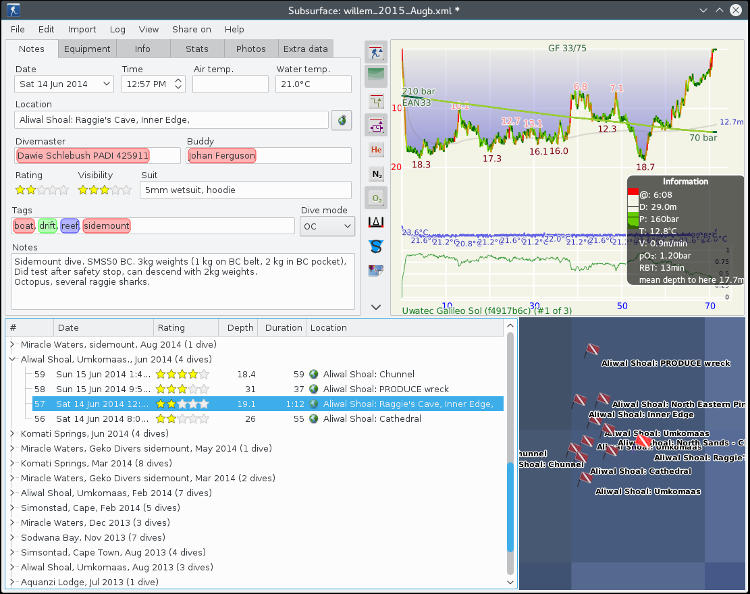
L’utilisateur décide quels panneaux sont affichés, parmi les 4, en sélectionnant l’option Vue dans le menu principal. Cette fonctionnalité permet plusieurs choix d’affichage :
Tout : affiche les quatre panneaux tels que sur la capture d'écran ci-dessus.
Liste des plongées : affiche uniquement la liste des plongées.
Profil : affiche uniquement le profile de plongée de la plongée sélectionnée.
Info : affiche uniquement les notes de plongées de la dernière plongée sélectionnée et les statistiques pour toutes les plongées mises en surbrillance.
Globe : affiche uniquement la carte mondiale, centrée sur la dernière plongée sélectionnée.
Comme d’autres fonctions qui peuvent être accédée via le menu principal, ces options peuvent aussi être utilisées par des raccourcis clavier. Les raccourcis pour un système particulier sont affichés avec un souligné des les entrées de menu. À cause des différents systèmes d’exploitation et des divers langues, Subsurface peut utiliser différentes touches de raccourcis et ne sont donc pas détaillées ici.
Lorsque le programme est lancé pour la première fois, il n’affiche aucune information, parce qu’il n’a aucune information de plongée disponible. Dans les sections suivantes, le procédure pour créer a nouveau carnet de plongée sera détaillée.
4. Créer un nouveau carnet de plongée
Sélectionner Fichier → Nouveau carnet de plongée à partir du menu principal. Toutes les données de plongées sont effacées pour que de nouvelles puissent être ajoutées. S’il existe des données non encore enregistrées dans le carnet ouvert, l’utilisateur devra sélectionner s’il faut les enregistrer ou non avant de créer le nouveau carnet.
5. Enregistrement des informations de plongée dans le carnet
Maintenant qu’un nouveau carnet de plongée a été créé, il est simple de lui ajouter des données. Subsurface comporte plusieurs façons pour ajouter des données de plongée au carnet.
1) Si l’utilisateur possède un carnet manuscrit, un tableur ou une autre forme de carnet maintenu manuellement, les données de plongée peuvent être ajoutées au carnet en utilisant une des approches suivantes :
-
Entrer les informations de plongée à la main. Cela est utile si le plongeur n’a pas utilisé d’ordinateur de plongée et que les plongées sont inscrites dans un carnet manuscrit. Voir Entrer les informations de plongée à la main
-
Importer les informations de plongée qui ont été maintenues soit dans un tableur soit dans un fichier CSV. Se reporter à : ANNEXE D : Exporter un tableur vers le format CSV et à Importer des plongées au format CSV.
Si une plongée est enregistrée par un ordinateur de plongée, le profil de profondeur et de nombreuses informations supplémentaires peuvent être obtenues. Ces plongées peuvent être importées à partir de :
-
L’ordinateur de plongée lui-même. Voir : Importer de nouvelles informations de plongée à partir de l’ordinateur de plongée;
-
Logiciels propriétaires fournis par les fabricants d’ordinateurs de plongée. Voir Importer les informations à partir d’autres sources de données numériques ou d’autres formats de données.
-
Tableur ou de fichiers CSV contenant les profils de plongées. Voir : Importer les plongées au format CSV à partir des ordinateurs de plongées ou d’autres logiciels de carnet de plongée
5.1. Entrer les informations de plongée à la main
This is usually the approach for dives without a dive computer. The basic record of information within Subsurface is a dive. The most important information in a simple dive logbook usually includes dive type, date, time, duration, depth, the names of your dive buddy and the dive master or dive guide, and some remarks about the dive. Subsurface can store much more information for each dive. To add a dive to a dive log, select Log → Add Dive from the Main Menu. The program then shows three panels on which to enter information for a dive: two tabs in the Info panel (Notes and Equipment), as well as the Dive Profile panel that displays a graphical profile of each dive. These panels are respectively marked A, B and C in the figure below. Each of these tabs will now be explained for data entry.
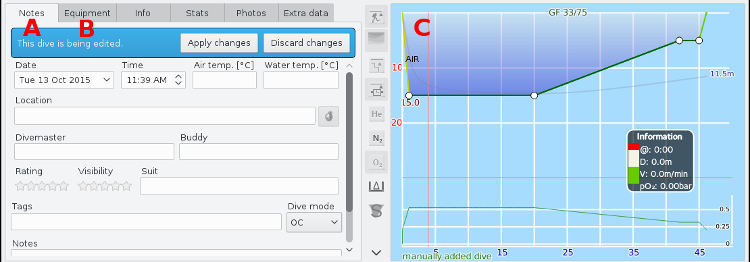
When you edit a field in Notes or Equipment panels, Subsurface enters Editing Mode, indicated by the message in the blue box at the top of the Notes panel (see the image below). This message is displayed in all the panels under Notes and Equipment when in Editing Mode.

The Apply changes button should only be selected after all the parts of a dive have been entered. When entering dives by hand, the Info, Equipment and Profile tabs should be completed before applying the information. By selecting the Apply changes button, a local copy of the information for this specific dive is saved in memory but NOT written to disk. The Apply changes button should ONLY be selected after all parts of a dive have been entered. When closing Subsurface, the program will ask again, this time whether the complete dive log should be saved on disk or not.
5.1.1. Creating a Dive Profile
The Dive Profile (a graphical representation of the depth of the dive as a function of time) is shown in the panel on the top right hand of the Subsurface window. When a dive is manually added to a logbook, Subsurface presents a default dive profile that needs to be modified to best represent the dive described:
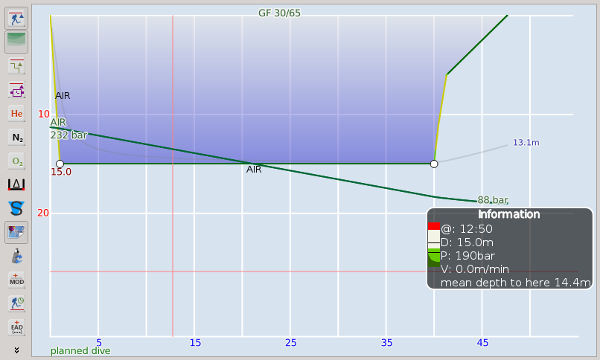
Modifying the dive profile: When the cursor is moved around the dive profile, its position is shown by two right-angled red lines as seen below. The time and depth represented by the cursor are indicated at the top of the black information box (@ and D). The units (metric/imperial) on the axes are determined by the Preference settings. The dive profile itself comprises several line segments demarcated by waypoints (white dots on the profile, as shown above). The default dive depth is 15 m. If the dive depth was 20 m then you need to drag the appropriate waypoints downward to 20 m. To add a waypoint, double-click on any line segment. To move an additional waypoint, drag it. To remove a waypoint, right-click on it and choose "Remove this point" from the context menu. Drag the waypoints to represent an accurate time duration for the dive. Below is a dive profile for a dive to 20 m for 30 min, followed by a 5 minute safety stop at 5 m.
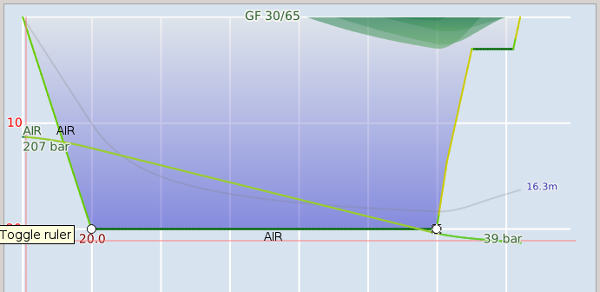
Specifying the gas composition: The gas composition used is indicated along the line segments of the dive profile. This defaults to the first gas mixture specified in the Equipment tab, which was air in the case of the profile above. The gas mixtures of segments of the dive profile can be changed by right-clicking on the particular waypoint and selecting the appropriate gas from the context menu. Changing the gas for a waypoint affects the gas shown in the segment to the left of that waypoint. Note that only the gases defined in the Equipment tab appear in the context menu (see image below).

With the profile now defined, more details must be added to have a fuller record of the dive. To do this, the Notes and the Equipment tabs on the top left hand of the Subsurface window should be used. Click on this link for instructions on how to use these tabs.
5.2. Importer de nouvelles informations de plongée à partir de l’ordinateur de plongée
5.2.1. Connecting and importing data from a dive computer.
The use of dive computers allows the collection of a large amount of information about each dive, e.g. a detailed record of depth, duration, rates of ascent/descent and of gas partial pressures. Subsurface can capture this information, using dive details from a wide range of dive computers. The latest list of supported dive computers can be found at: Supported dive computers.
|
|
Several dive computers consume more power when they are in PC-Communication mode. This could drain the dive computer’s battery. We recommend the user checks to be sure the dive computer is charged when connected to the USB port of a PC. For example, several Suunto and Mares dive computers do not recharge through the USB connection. Users should refer to the dive computer’s manual if they are unsure whether the dive computer recharges its batteries while connected to the USB port. |
To import dive information from a dive computer to a computer with Subsurface, the two pieces of equipment must communicate with one another. This involves setting up the communications port (or mount point) of the computer with Subsurface that communicates with the dive computer. To set up this communication, users need to find the appropriate information to instruct Subsurface where and how to import the dive information. Appendix A provides the technical information to help the user achieve this for different operating systems and Appendix B has dive computer specific information.
After this, the dive computer can be hooked up to the user’s PC using these steps:
-
The interface cable should be connected to a free USB port (or the Infra-red or Bluetooth connection set up as described later in this manual)
-
The dive computer should be placed into PC Communication mode. (Se reporter au manuel de l’ordinateur de plongée)
-
In Subsurface, from the Main Menu, select Import → Import From Dive Computer. Dialogue A in the figure below appears:
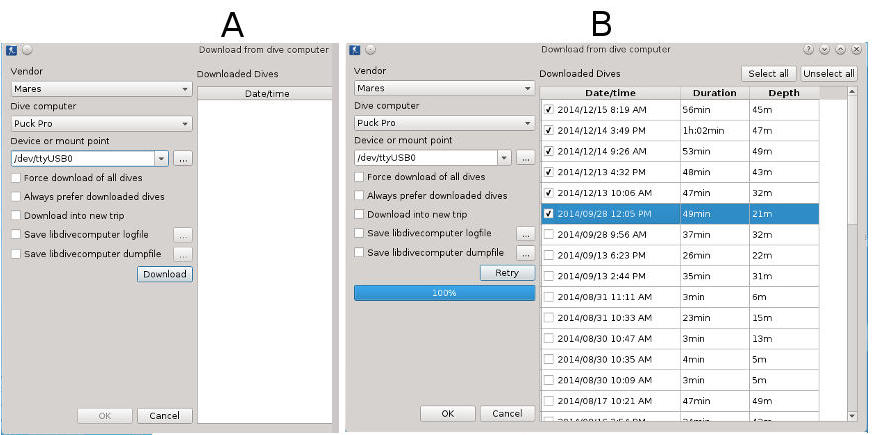
Dive computers tend to keep a certain number of dives in memory, even though these dives have already been imported to Subsurface. For that reason, if the dive computer allows this, Subsurface only imports dives that have not been uploaded before. This makes the download process faster on most dive computers and also saves battery power of the dive computer (at least for those not charging while connected via USB).
-
The dialogue has two drop-down lists, Vendor and Dive Computer. On the vendor drop-down list select the make of the computer, e.g. Suunto, Oceanic, Uwatec, Mares. On the Dive Computer drop-down list, the model name of the dive computer must be selected, e.g. D4 (Suunto), Veo200 (Oceanic), or Puck (Mares).
-
The Device or Mount Point drop-down list contains the USB or Bluetooth port name that Subsurface needs in order to communicate with the dive computer. The appropriate port name must be selected. Consult Appendix A and Appendix B for technical details on how to find the appropriate port information for a specific dive computer and, in some cases, how to do the correct settings to the operating system of the computer on which Subsurface is running.
-
If all the dives on the dive computer need to be downloaded, check the checkbox Force download of all dives. Normally, Subsurface only downloads dives after the date-time of the last dive in the Dive List panel. If one or more of your dives in Subsurface has been accidentally deleted or if there are older dives that still need to be downloaded from the dive computer, this box needs to be checked. Some dive computers (e.g. Mares Puck) do not provide a contents list to Subsurface before the download in order to select only new dives. Consequently, for these dive computers, all dives are downloaded irrespective of the status of this check box.
-
If the checkbox Always prefer downloaded dives has been checked and, during download, dives with identical date-times exist on the dive computer and on the Subsurface Dive List panel, the dive in the Subsurface divelog will be overwritten by the dive record from the computer.
-
The checkbox marked Download into new trip ensures that, after upload, the downloaded dives are grouped together as a new trip(s) in the Dive List.
-
Do not check the checkboxes labelled Save libdivecomputer logfile and Save libdivecomputer dumpfile. These are only used as diagnostic tools when there are problems with downloads(see below).
-
Then select the Download button. With communication established, you can see how the data are retrieved from the dive computer. Depending on the make of the dive computer and/or number of recorded dives, this could take some time. Be patient. The Download dialogue shows a progress bar at the bottom of the dialogue. Remember for some dive computers progress information could be inaccurate since Subsurface doesn’t know how much downloadable data there are until the download is complete. After the dives have been downloaded, they appear in a tabular format on the right-hand side of the dialogue (see image B, above). Each dive comprises a row in the table, showing the date, duration and depth. Next to each dive is a checkbox: check all the dives that need to be transferred to the Dive List. In the case of the image above, the last six dives are checked and will be transferred to the Dive List. Then click the OK button at the bottom of the dialogue. All the imported dives appear in the Dive List, sorted by date and time. Disconnect and switch off the dive computer to conserve its battery power.
-
If there is a problem in communicating with the dive computer, an error message is shown, similar to this text: "Unable to open /dev/ttyUSB0 Mares (Puck Pro)". Refer to the text in the box below.
5.2.2. Connecting Subsurface to a Bluetooth-enabled dive computer
Bluetooth is becoming a more common way of communication between dive computers and Subsurface, for or instance, the Shearwater Petrel Mk2 and the OSTC Mk3. Subsurface provides a largely operating system independent Bluetooth interface. Setting up Subsurface for Bluetooth communication requires four steps:
-
Ensure Bluetooth is activated on the host computer running Subsurface.
-
Ensure Subsurface sees the Bluetooth adapter on the host computer.
-
Ensure the Bluetooth-enabled dive computer is Bluetooth-discoverable and in PC upload mode.
-
Ensure Subsurface is paired with the Bluetooth-enabled dive computer.
Select the Download dialogue by selecting Import → Import from dive computer from the Main Menu. After checking the box labelled "Choose Bluetooth download mode", the dialogue below appears.
Sur Linux ou MacOS :
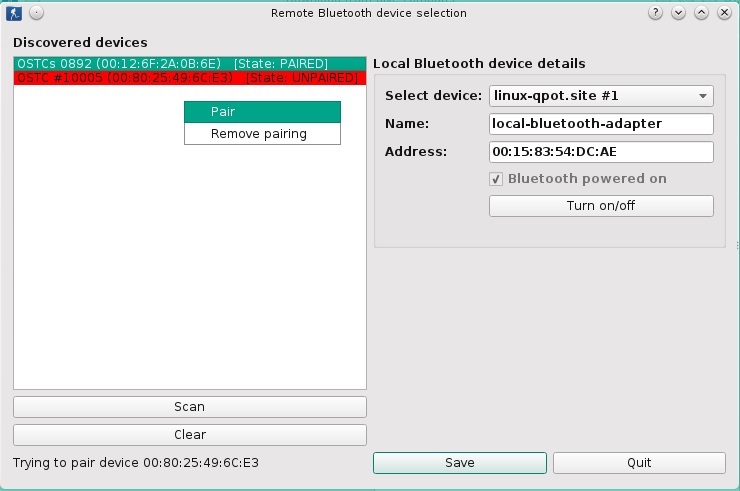
On the Linux or MacOS platforms the name of the Subsurface computer and its Bluetooth address are shown on the right hand side, On the left hand side, if the computer has connected more than one local Bluetooth devices you can use the list box to indicate which one needs to connect to Subsurface. The power state (on/off) of the Bluetooth adapter is shown below the address and can be changed by checking the Turn on/off box. If the Bluetooth address is not shown, then Subsurface does not see the local Bluetooth device. Ensure the Bluetooth driver is installed correctly on the Subsurface computer and check if it can be used by other Bluetooth utilities like bluetoothctl or bluemoon. This completes the first two steps above. Ensure the Bluetooth-enabled dive computer is in PC-upload mode and it is discoverable by other Bluetooth devices. Consult the manual of the dive computer for more information. Now the third item in the list above has been finished. Select the Scan button towards the bottom left of the dialogue above. After searching, the dive computer should be listed (perhaps as one of a number of Bluetooth devices) in the main list box on the lefthand side of the dialogue (see image above). If this does not work, select the Clear button, then scan again for Bluetooth devices using the Scan button. After taking these actions Subsurface should see the dive computer. The label of the discovered dive computer contains the name of the device, its address and its pairing status. If the device is not paired and has a red background color, a context menu can be opened by selecting the item with a right-click. Select the the Pair option and wait for the task to complete. If this dive computer is being paired to Subsurface for the first time, it’s possible Subsurface will request a Pass Code or PIN number. The most commonly-used Pass Code is 0000, and this works for the Shearwater Petrel. If necessary, consult the user manual of the dive computer being used.
After the devices are paired, press the Save button of the dialogue. This closes the Bluetooth dialogue. Now select Download in the Download from dive computer dialogue which should still be open. The downloaded dives are shown on the righthand side of the download dialogue.
Sur Windows :
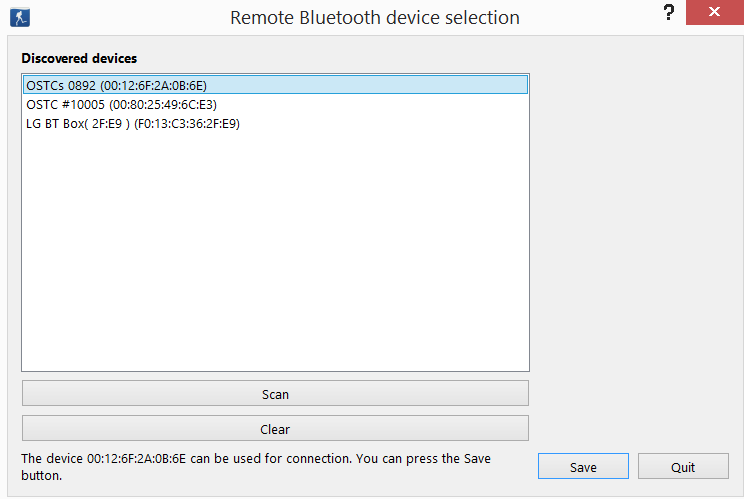
On Windows platforms the Local Bluetooth device details section on the right is not displayed as is the case on the Linux/Mac systems. To start a scan (by pressing the Scan button) check that the Bluetooth device on the Subsurface computer is turned on by selecting the dive computer from the list of available Bluetooth devices (see image above). If the dive computer is being accessed by Subsurface for the first time, it’s possible Subsurface will request a Pass Code or PIN number. Supply the Pass Code recommended in the user manual of the dive computer. A Pass Code or PIN of 0000 is often the default.
The pairing step is checked and done automatically during the download process. If the devices have never been paired the system will ask permission and put a message on the right side of the screen: Add a device, Tap to set up your DC device. Always allow this pairing. After a discovered item is selected, select the Save button. Finally select the Download button on the Download dialogue and wait for the process to complete.
|
|
Currently Subsurface works only with local Bluetooth adapters which use Microsoft Bluetooth Stack. If the local device uses Widcomm, Stonestreet One Bluetopia Bluetooth or BlueSoleil drivers it will not work. However, Bluetooth hardware/dongles from these manufacturers (e.g. iSonic) that support the Microsoft Bluetooth Stack do work. |
A log message on the bottom left of the Remote Bluetooth device selection shows details about the current status of the Bluetooth agent. To select another dive computer for download using the "Remote Bluetooth selection dialogue" press the three-dots button from the "Choose Bluetooth download mode" option.
|
|
IN CASE OF PROBLEMS: If the Bluetooth adapter from the Subsurface computer gets stuck and the Download process fails repeatedly, unpair the devices and then repeat the above steps. If this is not successful, Appendix A contains information for manually setting up and inspecting the Bluetooth connection with Subsurface. |
5.2.3. Changing the name of a dive computer
It may be necessary to distinguish between different dive computers used to upload dive logs to Subsurface. For instance if a buddy’s dive computer is the same make and model as your own and dive logs are uploaded from both dive computers to the same Subsurface computer, then you might like to call one "Alice’s Suunto D4" and the other "Bob’s Suunto D4". Alternatively, consider a technical diver who dives with two or more dive computers of the same model, the logs of both (or all) being uploaded. In this case it might be prudent to call one of them "Suunto D4 (1)" and another "Suunto D4 (2)". This is easily done in Subsurface. On the Main Menu, select Log → Edit device names. A dialog box opens, showing the current Model, ID and Nickname of the dive computers used for upload. Edit the Nickname field for the appropriate dive computer. After saving the Nickname, the dive logs show the nickname for that particular device instead of the model name, allowing easy identification of devices.
5.2.4. Updating the dive information imported from the dive computer.
With the uploaded dives in the Dive List, the information from the dive computer is not complete and more details must be added to have a full record of the dives. To do this, the Notes and the Equipment tabs on the top left hand of the Subsurface window should be used.
Notes
To have a more complete dive record, the user needs to add additional information by hand. The procedure below is virtually identical for hand-entered dives and for dives downloaded from a dive computer.
In some cases, you must provide the date and time of the dive, for example when entering a dive by hand or when a dive computer doesn’t provide the date and time of the dive. (Usually the date and time of the dive, gas mixture and water temperature are shown as obtained from the dive computer) If the contents of the Notes tab is changed or edited in any way, the message in a blue box at the top of the panel shows the dive is being edited. If you click on the Notes tab, the following fields are visible (left hand image, below):
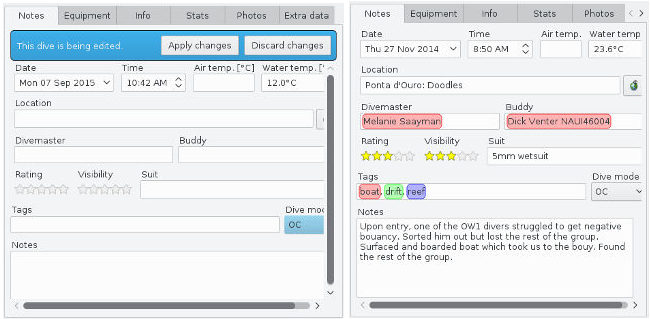
The right hand image, above, shows a Notes tab filled with dive information. The Time field reflects the date and time of the dive. By clicking the date, a calendar is displayed for selecting the correct date. Press ESC to close the calendar. The time values (hour and minutes) can also be edited directly by clicking on each of them in the text box and by over-typing the information displayed.
Air/water temperatures: Air and water temperatures during the dive are shown in text boxes to the right of the Start time. Many dive computers supply water temperature information and this box may have information. If air temperature isn’t provided by the dive computer, the first temperature reading might be used for the air temperature. Generally this is close to the real air temperature. If editing is required, only a value is required, the units of temperature will be automatically supplied by Subsurface (following the Preferences, metric or imperial units will be used).
Location:
|
|
Dive locations are managed as a separate part of the dive log. The dive information in the Notes and Equipment tabs can therefore NOT be edited at the same time as the dive site information. Save all the other dive information (e.g. divemaster, buddy, protective gear, notes about the dive) by selecting Apply changes on the Notes tab BEFORE editing the dive site information. Then supply a dive site name in the textbox labelled Location on the Notes tab. |
Type in the name of the dive site, e.g. "Tihany, Lake Balaton, Hungary". If several dives are made at the same location, the site information for the first dive is re-used. Existing dive locations can be edited by selecting (on the Dive List panel) a dive done at that site and by opening the location information. Click the globe button on the right of the location name (see image on the right, above). When entering a dive location name, auto location of dive site names makes it easy to select an existing dive site name. When typing the name of a dive site, a dropdown list appears showing all sites with similar names. If the dive site has been used before, click on the already-existing name. The dive site names in the dropdown list contain either a globe symbol (indicating existing dive sites in the Subsurface database) or a + symbol (indicating dive site names that appear consistent with the current dive site name but which haven’t been added to the dive site database). If the present dive site has not been used before, a message appears as follows (image A below):

Doubleclick on the new dive site name. A panel appears to enter the coordinates and other information about the site (image B, above). The most important items are the coordinates of the site. There are three ways to specify coordinates:
-
Use the world map in the bottom right hand part of the Subsurface window. The map displays an orange bar indicating "No location data - Move the map and double-click to set the dive location". Doubleclick at the appropriate place, and the orange bar disappears and the coordinates are stored.
-
Use eiher the Subsurface-Mobile App or the Subsurface Companion App on an Android or iPhone device with GPS and if the dive site coordinates were stored using one of these apps. Click here for more information
-
Enter coordiantes by hand if they are known, using one of four formats with latitude followed by longitude:
ISO 6709 Annex D format e.g. 30°13'28.9"N 30°49'1.5"E Degrees and decimal minutes, e.g. N30° 13.49760' , E30° 49.30788' Degrees minutes seconds, e.g. N30° 13' 29.8" , E30° 49' 1.5" Decimal degrees, e.g. 30.22496 , 30.821798
Southern hemisphere latitudes are given with a S, e.g. S30°, or with a negative value, e.g. -30.22496. Similarly western longitudes are given with a W, e.g. W07°, or with a negative value, e.g. -7.34323. Some keyboards don’t have the degree sign (°). It can be replaced by a d like this: N30d W20d. If both a dive site name and coordinates have been provided, save the dive site information by selecting the button Apply changes at the top of the panel.
Important: GPS coordinates of a dive site are linked to the location name - so saving a dive site with only coordinates and no name causes problems. (Subsurface will think all of these dives have the same location and try to keep their GPS coordinates the same).
Dive site name lookup: If you typed coordinates into the appropriate text box, you can do an automated name lookup based on the coordinates. This is done when Subsurface uses the Internet to find the name of the dive site based on the coordinates that were typed. If a name has been found, it is automatically inserted into the tags box. The list box (Titled Dive sites on same coordinates") at the bottom of the dive site panel contains the names of other dives sites used at the current location. For instance if the dive site is "Blue Hole" and there are several sites named "Blue Hole", all of them are listed.
Enter any other contextual information about the dive site (Description and Notes), then select Apply Changes to save the geolocation for this dive site. The dive site information can later be edited by clicking the globe icon to the right of the dive site name in the Notes tab.
Dive mode: This is a dropdown box allowing you to choose the type of dive performed. The options are OC (Open Circuit SCUBA, the default setting, for most recreational dives), Freedive (dive without SCUBA equipment), CCR (Closed-circuit rebreather) and pSCR (Passive semi-closed rebreather).
Divemaster: The name of the divemaster or dive guide should be entered in this field which offers auto selection based on the list of dive masters in the current logbook.
Buddy: In this field, enter the name(s) of the buddy or buddies (separated with commas) who were on the dive. Auto selection based on the list of buddies in the current logbook is offered.
Suit: Here the type of dive suit used can be entered. Auto selection of the suit description is available. Some dry-suit users may choose to use this field to record what combination of suit and thermal under suit was used.
Rating: Provide a subjective overall rating of the dive on a 5-point scale by clicking the appropriate star on the rating scale.
Visibility: Provide a rating of visibility during the dive on a 5-point scale by clicking the appropriate star.
Tags: Tags that describe the type of dive done can be entered
here (separated by commas). Examples of common tags are boat, drift, training,
cave, etc.
Subsurface has many built-in tags. By starting to type a tag, Subsurface lists
the tags that correspond to the typing. For instance, by typing
cav, the tags cave and cavern are shown to choose from.
Notes: Any additional information for the dive can be entered here.
The Apply changes and Discard changes buttons are used to save all the information for tabs in the Info panel and in the Dive Profile panel. Use them when ALL other information has been added. The image at the beginning of this section shows an example of a Notes tab after completing the dive information.
Equipment
The Equipment tab allow entering information about the type of cylinder and gas used, as well as the weights used for the dive. The message in the blue box at the top of the panel:

shows the equipment is being edited. This is a highly interactive part of Subsurface and the information on cylinders and gases (entered here) determines the behavior of the Dive profile (top right-hand panel).
Cylinders: The cylinder information is entered through a dialogue that looks like this:

For hand-entered dives, this information needs to be typed in. For dive computers, Subsurface often gets the gas used from the dive computer and automatically inserts the gas composition(% oxygen or % helium) in the table. The + button at the top right allows adding more cylinders for this dive. The dark dustbin icon on the left allows you to delete information for a cylinder. Note that it is not possible to delete a cylinder if it is used during the dive. A cylinder might be implicitly used in the dive, even without a gas change event. Start by selecting a cylinder type on the left-hand side of the table. To select a cylinder, the Type box should be clicked. This brings up a list button that can be used to display a dropdown list of cylinders:

The drop-down list can then be used to select the cylinder type that was used for this dive, or just start typing in the box which shows the available options for the entered characters. The Size of the cylinder as well as its working pressure (Work.press) will automatically be shown in the dialogue.
Next, indicate the starting pressure and the ending pressure of the specified gas during the dive. The unit of pressure (metric/imperial) corresponds to the settings chosen in the Preferences.
Finally, provide the gas mixture used. If air was used, the value of 21% can
be entered into the oxygen box or this field can be left blank. If nitrox or
trimix were used, their percentages of oxygen and/or helium should be
entered. Any inappropriate fields should be left empty. After typing the
information for the cylinder, save the data either by pressing ENTER on
the keyboard or by clicking outside the cell containing the
cursor. Information for any additional cylinders can be added by using the
button at the top right hand. Here is an example of a complete description
for a dive using two cylinders (air and EAN50):

Weights: Information about the weight system used can be entered using a dialogue similar to that of the cylinder information. If you click the + button on the top right of the weights dialogue, the table looks like this:

By clicking on the Type field, a drop-down list becomes accessible through a down-arrow:

This can be used to select the type of weight system used during the
dive. You may start typing in the box to specify a different weighting
mechanism that will be saved by Subsurface. In the Weight field, type
in the amount of weight used during the dive. After specifying the weight
system, save the data by pressing ENTER on the keyboard or by clicking
outside the cell with the cursor. It’s possible to enter information for
more than one weight system by adding an additional system using the
button on the top right hand. Weight systems can be deleted using the dust
bin icon on the left hand. Here is an example of information for a dive with
two types of weights: integrated as well as a weight belt:

5.2.5. Editing several selected dives simultaneously
METHOD 1: After uploading dives from a dive computer, the dive profiles of each is shown in the Dive profile tab, as well as a few items of information in the Notes tab (e.g. water temperature) and in the Equipment tab (e.g. gas pressures and gas composition). Other fields remain empty. It may be useful to simultaneously edit some of the fields in the Notes and Equipment tabs. For instance, it’s possible that a diver performed several dives during a single day, using identical equipment at the same dive site, or with the same divemaster and/or buddy or tags. Instead of completing the information for each dive separately, select all the dives for that day in the Dive List and insert the same information in the Notes and Equipment fields that need identical information. This is done by editing the dive notes or the equipment for any one of the selected dives.
Simultaneous editing only works with fields that do not already contain information. This means if some fields have been edited for a particular dive among the selected dives, these are not changed while editing the dives simultaneously. Technically, the rule for editing several dives simultaneously is: if the data field being edited contains exactly the same information for all the dives that have been selected, the new, edited information is substituted for all the selected dives. Otherwise only the edited dive is changed, even though several dives have been selected in the Dive List. This speeds up the completion of the dive log after several similar dives.
METHOD 2:There is a different way of achieving the same goal. Select a dive with all the appropriate information typed into the Notes and Equipment tabs. Then, from the main menu, select Log → Copy dive components. A box is presented with a selection of check boxes for most of the fields in the Notes and Equipment tabs. Select the fields to be copied from the currently selected dive, then select OK. Now, in the Dive List, select the dives into which this information is to be pasted. Then, from the main menu, select Log → Paste dive components. All the selected dives now contain the data initially selected in the original source dive log.
5.2.6. Adding Bookmarks to a dive
Many divers wish to annotate dives with text that indicate particular events, e.g. "Saw dolphins", or "Released surface buoy". This is easily done:
-
Right-click at the appropriate point on the dive profile. This brings up the dive profile context menu. Select Add bookmark. A red flag is placed on the dive profile at that point (see A below).
-
Right-click on the red flag. This brings up the context menu (see B below). Select Edit name.
-
A text box is shown. Type the explanatory text for the bookmark (see C below). Select OK. This saves the text associated with the bookmark.
-
Hovering the mouse over the red bookmark, the appropriate text is shown at the bottom of the information box (see D below).

5.2.7. Saving the updated dive information
The information entered in the Notes tab and the Equipment tab can be saved by using the two buttons on the top right hand of the Notes tab. If the Apply changes button is clicked, the dive data are saved in the memory image of the dive. If the Discard changes button is clicked, the newly entered dive data are erased from the computer memory, although the dive profile is retained. When the user exits Subsurface there is a final prompt to confirm the new data should now be saved permanently on the computer disk.
5.3. Importer les informations à partir d’autres sources de données numériques ou d’autres formats de données
Many divers log their dives using the proprietary software provided by the manufacturers of their dive computers. Subsurface can import dive logs from a range of other dive log software. While import from some software is supported natively, others require export of the the dive log to an intermediate format that can then be imported into Subsurface. Currently, Subsurface supports importing CSV log files from several sources. Dive log import from APD LogViewer, XP5, Sensus and Seabear files are preconfigured, but because the import is flexible, users can configure their own imports. Manually kept log files (e.g. a spreadsheet) can also be imported by configuring the CSV import. Subsurface can also import UDDF and UDCF files used by some dive log software and some dive computers, like the Heinrichs & Weikamp DR5. Finally, for some dive log software like Mares Dive Organizer we currently recommend importing the logbook first into a web service like divelogs.de and then import from there with Subsurface. Divelogs.de supports a few additional logbook formats that Subsurface currently cannot handle.
If the format of other software is supported natively on Subsurface, select either Import → Import log files or File → Open log file. Subsurface supports the data formats of many dive computers, including Suunto, Shearwater and some CCR equipment. When importing dives, Subsurface tries to detect multiple records for the same dive and merges the information as best as it can. If there are no time zone issues (or other reasons that would cause the beginning time of the dives to be significantly different) Subsurface will not create duplicate entries. Below is more specific information to import data to Subsurface.
5.3.1. Using the universal import dialogue
Importing dives from other software is done through a universal interface activated by selecting Import from the Main Menu, then clicking on Import Log Files. This brings up dialogue A, below.

Towards the bottom right is a dropdown selector with a default label of Dive Log Files which accesses different types of direct imports available, as in dialogue B, above. Currently these are:
-
XML-formatted dive logs (DivingLog 5.0, MacDive and several other dive log systems)
-
Cochran dive logs
-
UDDF-formatted dive logs (e.g. Kenozoooid)
-
UDCF-formatted dive logs
-
Poseidon MkVI CCR logs
-
APD Inspiration/Evolution CCR logs
-
LiquiVision logs
-
divelogs.de logs
-
OSTC Tools logs
-
JDiveLog
-
Suunto Dive Manager (DM3, DM4, DM5)
-
CSV (text-based and spreadsheet-based) dive logs, including APD CCR logs
Selecting the appropriate format and then the specific log file in the large window containing the file list on the right of the dialogue, opens the imported dive log in the Subsurface Dive List. Some other formats not accessible through the Import dialogue are also supported, as explained below.
5.3.2. Importing from OSTCTools
OSTC Tools is a Microsoft-based suite of dive download and dive management tools for the OSTC family of dive computers. OSTC Tools downloads dive data from the dive computer and stores it as a binary file with file extension .dive . Subsurface can directly import these files when using the universal import dialogue. From the dropdown list at the bottom right select OSTCTools Files (.dive .DIVE). This makes the OSTC Tools dive logs visible in the file list panel. Select one or more dive, then click the Open button. The OSTC dives are shown in the Dive List panel.
All H&W devices supported by OSTCTools can be imported to Subsurface. This includes OSTC, OSTC Mk2, OSTC 2N/2C, OSTC3, OSTC Sport, and probably although untested, Frog, OSTC2 and OSTC CR.
Please remember that OSTCTools is not true diving log software, but rather a useful set of tools for analysis and management of OSTC devices. Only raw dive computer data will be imported to Subsurface; the rest of the data (buddies, equipment, notes, etc) need to be completed manually.
5.3.3. Importing from Mares Dive Organizer V2.1
Since Mares uses proprietary Windows software not compatible with multi-platform applications, these dive logs cannot be directly imported into Subsurface. Mares dive logs need to be imported using a three-step process, using www.divelogs.de as a gateway to extract the dive log information.
-
Export the dive log data from Mares Dive Organizer to your desktop, using a .sdf file name extension. Refer to Appendix C for more information.
-
Data should then be imported into www.divelogs.de. First, create a user account in www.divelogs.de and Log into that web site, then select Import Logbook → Dive Organizer from the menu on the left hand side. The instructions must be carefully followed to transfer the dive information (in _.sdf format) from the Dive Organizer database to www.divelogs.de.
-
Finally, import the dives from divelogs.de to Subsurface, using the instructions below.
5.3.4. Importing dives from divelogs.de
Importing dive information from divelogs.de is simple, using a single dialogue box. The Import → Import from Divelogs.de option should be selected from the Main Menu. This brings up a dialogue box (see image A below). Enter a user-ID and password for divelogs.de and then select the Download button. Download from divelogs.de starts immediately, displaying a progress bar in the dialogue box. At the end of the download, the success status is shown (see image B, below). The Apply button should then be selected, after which the imported dives appear in the Subsurface Dive List panel.

5.3.5. Importer des données au format CSV
A comma-separated file (.csv) can be used to import dive information either as dive profiles (as in the case of the APD Inspiration and Evolution closed circuit rebreathers) or as dive metadata (in case the user keeps dive data in a spreadsheet). The CSV format is a universal simplified format that allows easy information exchange between different computers or software packages. For an introduction to CSV-formatted files see A Diver’s Introduction To CSV Files. Subsurface dive logs can also be exported in CSV format to other software that reads this format. See APPENDIX D: Exporting a spreadsheet to CSV format for information that may be helpful for importing spreadsheet-based data into Subsurface.
Importer les plongées au format CSV à partir des ordinateurs de plongées ou d’autres logiciels de carnet de plongée
_CSV_ files can be viewed using an ordinary text editor. A _CSV_ file is normally organized into
a single line that provides the headers (or _field names_ or _column headings_) of the data
columns, followed by the data, one record per line.There are two types of CSV dive logs that can be imported into Subsurface:
-
CSV dive details: This dive log format contains similar information to that of a typical written dive log, e.g. dive date and time, dive depth, dive duration, names of buddy and divemaster and information about cylinder pressures before and after the dive, as well as comments about the dive. All the data for a single dive go on a single line of text, following the order of the column headings.
-
CSV dive profile: This dive log format includes much more information about a single dive. For instance there may be information at 30-second intervals, indicating depth, water temperature, and cylinder pressure at that moment in time. Each line contains the information for a single instant in time during the dive, 30 seconds after that of the previous instant. Many lines are required to complete the depth profile information for a single dive. This is a common export format used by closed-circuit rebreather (CCR) dive equipment and many software packages that handle dive computer data and/or dive logs.
Before being able to import the CSV data to Subsurface you need to know a few things about the data being imported:
-
Which character separates the different columns within a single line of data? This field separator should be either a comma (,) a semicolon (;) or a TAB character. This can be determined by opening the file with a text editor. If it is comma-delimited or semicolon-delimited, the comma or semicolon characters between the values are clearly visible. If these are not evident and the numbers are aligned in columns, the file is probably TAB-delimited (i.e. it uses a TAB as a field separator).
-
Which data columns need to be imported into Subsurface? Is it a CSV dive details file or a CSV dive profile file? Open the file using a text editor and note the titles of the columns to be imported and their column positions.
-
Is the numeric information (e.g. dive depth) in metric or in imperial units?
With this information, importing the data into Subsurface is straightforward. Select Import → Import Log Files from the main menu. In the resulting file selection menu, select CSV files (towards the bottom right). This shows all .CSV files in the selected directory. Select the file that needs to be imported. A configuration panel appears as depicted below:
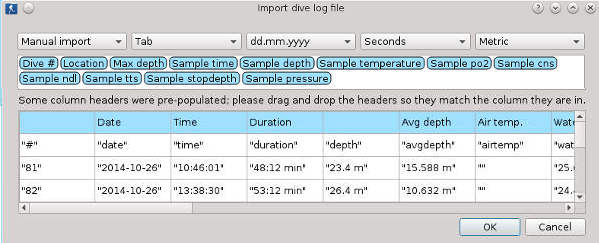
At the top left, there is a dropdown list containing pre- configured settings for common dive computers and software packages. If the CSV file being imported originated from any of these pre-configured items, select it. Otherwise use the Manual Import option. The configuration panel also has dropdown lists for the specification of the appropriate field separator (Tab, comma or semicolon), the date format used in the CSV file, the time units (seconds, minutes or minutes:seconds), as well as the unit system (metric or imperial). Selecting the appropriate options among these is critical for successful data import.
Complete this by ensuring that all the data columns have the appropriate column headings. The top blue row of the data table contains the column headings found in the CSV data file. The blue row of balloons immediately above these contains the names understood by Subsurface. These balloons can be moved using a drag-and-drop action. For instance, Subsurface expects the column heading for Dive number (" # ") to be "Dive # ". If the column heading that Subsurface expects is not in the blue row, drag the appropriate balloon from the upper area and drop it in the appropriate blue cell at the top of the table. For example, to indicate the correct column for "Dive #", drag the ballooned item labelled "Dive # " and drop it in the blue cell immediately above the white cell containing " # ", depicted in the image below.

Continue in this way to ensure all the column headings in the blue row of cells correspond to the headings listed in the top part of the dialogue. When finished, select the OK button on the bottom right of the dialogue. The data from the CSV file are imported and shown in the Dive List panel.
|
|
But, the CSV import has a couple of caveats. Avoid some special characters like ampersand (&), less than (<), greater than (>) and double quotes (") as part of the numbers or text within a cell. The file should use UTF-8 character set, if using non-ASCII characters. Also the size of the CSV file might cause problems. Importing 100 dives at a time (CSV dive details) works, but larger files might exceed the limits of the parser used. When encountering problems with CSV imports, first try with a smaller file to make sure everything works. |
5.4. Importing Dive coordinates from a mobile device with GPS.
A smartphone with built-in GPS facilities can be used to store the locations of dives. This is performed by:
Taking the mobile device along on the dive boat / liveabord while automatically collecting dive site coordinate information.
2) Uploading the coordinates from the mobile device to the Subsurface Internet server.
Syncronising the dives in the Subsurface dive list with the coordinates stored on the Subsurface Internet server.
_Subsurface has two tools for achieving this:
-
The Subsurface Companion App (Android and iOS).
-
The Subsurface-mobile app (Android and iOS)
Both of these applications perform the collection of dive site coordinates and the synchronisation with dives in the Subsurface dive list. However, the Companion App is not being further developed and has largely been replaced by the Subsurface-mobile app. While the Companion app serves exclusively to collect dive site coordinates and to make these available to the Subsurface desktop version, Subsurface-mobile performs many of the functions of the desktop version, including the management and viewing of dive information. Below, we describe how to perform the above three steps using each of the two mobile apps.
For information on using the Subsurface Companion App, click here.
5.4.1. Storing and and using GPS locations using Subsurface-mobile
Install Subsurface-mobile
Find Subsurface-mobile on Google Play and install it on an Android device. The app is free. The iOS version is currently experimental. Subsurface-mobile has an extensive user manual accessible from within that app.
Create a Subsurface-mobile account
This topic is discussed at length in the Subsurface-mobile user manual. In the Credentials screen of Subsurface-mobile provide an e-mail address and a user password that enables subsequent access. A PIN number is e-mailed from the Subsurface Internet server to the e-mail address that has been provided. Type the PIN into the appropriate text field in the Credentials screen (see image below). The Subsurface Internet server notifies the user that a new user has been registered.
N.B.: To successfully create a user account, the mobile device must have Internet connectivity, either through the cellular network or via wifi.

Configure auto-collecting of GPS coordinates
Activate the main menu of Subsurface-mobile by selecting the "hamburger" menu button at the bottom left of the Subsurface-mobile screen (see image above), then select GPS → Preferences (see image below). The collection of GPS locations is done in the background and automatically, using two settings:
-
Time threshold. (minutes). The app will try to get a location every X minutes
-
Distance threshold. (meters). Minimum distance between two locations.
How are GPS coordinates collected? Assuming the diver sets 5 minutes and 50 meters in the settings above, the app will start by recording a location at the current location, followed by another one at every 5 minutes or every time you move 50 m from previous location, whichever happens first. If subsequent locations are within a radius of 50 meters from the previous one, a new location is not saved. If the diver is not moving, only one location is saved, at least until the Time-threshold period has elapsed. If the diver moves, a trace of the route is obtained by saving a location every 50 meters.
Activate the automated recording of GPS locations
The Subsurface-mobile main menu has a checkbox at the bottom left labled Run location service (see image below). Checking the box starts the automated recording of GPS positions.
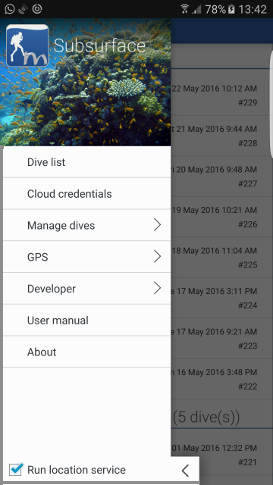
After the dive, stop the automated recording of GPS locations
Uncheck the check box at the bottom left of the Subsurface-mobile main menu.
Upload the GPS locations onto the Subsurface Internet server.
N.B.: Uploading the GPS locations to the Internet can only take place if the mobile device has reliable access to the Internet, either via a cellular network or via a wifi connection. If the Internet is not accessible from the dive site(s), then GPS uploading can only take place after the dive or after the dive trip, when an Internet connection has been re-established.
From the Subsurface-mobile main menu, select GPS → Upload GPS data. The locations are uploaded. Check the indicator at the top of the mobile screen for internet activity, indicating the transfer of information.
Apply the stored GPS locations to dives on the Subsurface dive list.
Subsurface collects the first GPS location recorded after the start of a dive (obtained within Subsurface from either the dive computer or from the manually-entered dive information) and before the end of a dive. These coordinates are shown in the Coordinates field of the dive site panel for each dive. Within the dive site panel, provide a name for the coordinates that have been assigned to the dive, following the instructions under the heading above Location management.
The user manual for Subsurface-mobile (accessible from within that app) contains detailed instructions for performing the collection of GPS data and for managing, uploading and synchronising this information.
5.4.2. Importing GPS coordinates with the Subsurface Companion App for mobile phones
Using the Subsurface Companion App on an Android device or iPhone with GPS, the coordinates for the diving location can be automatically passed to the Subsurface dive log. The Companion App stores dive locations on a dedicated Internet server. Subsurface can collect the locations from the server. To do this:
Create a Companion App account
-
Register on the Subsurface companion web page. A confirmation email with instructions and a personal DIVERID will be sent, a long number enabling access to the file server and Companion App capabilities.
-
Download the app from Google Play Store or from F-Droid.
Using the Subsurface companion app on an Android smartphone
On first use the app has three options:
-
Create a new account. Equivalent to registering in the Subsurface companion page using an Internet browser. You can request a DIVERID using this option, but it’s supplied via email and followed up by interaction with the Subsurface companion web page to activate the account.
-
Retrieve an account. If you forget your DIVERID you will receive an email to recover the ID string.
-
Use an existing account. You are prompted for your DIVERID. The app saves this DIVERID and doesn’t ask for it again unless you use the Disconnect menu option (see below).
|
|
In the Subsurface main program, the DIVERID should also be entered on the Default Preferences panel, by selecting File → Preferences → Defaults from the main menu in Subsurface itself. This helps synchronization between Subsurface and the Companion App. |
Créer de nouveaux emplacements de plongée
Now you are ready to get a dive position and send it to the server. The Android display looks like the left hand image (A) below, but without any dives.
Touch the + icon at the top right to add a new dive site. A menu with 3 options shows:
-
Current: A prompt for a place name is shown (or a request to activate the GPS if it is turned off), after which the current location is saved.
-
Use Map: This option allows you to fix a position by searching a world map. A world map is shown (see B below). Specify the desired position with a long press on the touch sensitive screen (if the marked location is wrong, simply choose a new location) and select the check symbol in the upper right. A dialog is shown allowing you to enter the name of the dive location and the date and time of the dive (see C below). In order to import this dive location in Subsurface, set the time to agree with the time of that dive on the dive computer.
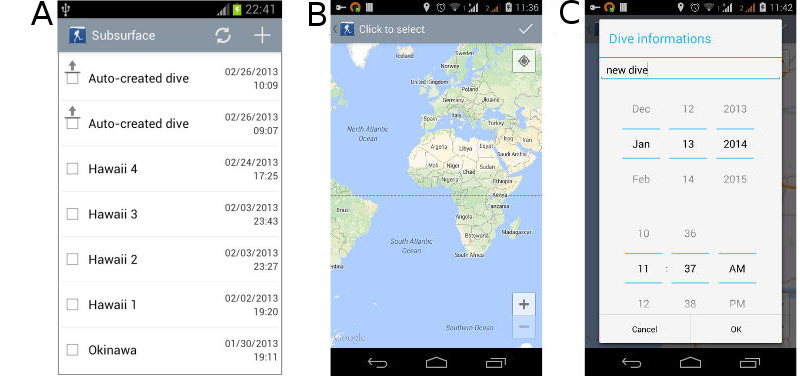
-
Import local GPX file: The Android device searches for .gpx files and located archives will be shown. The selected .gpx file is opened and its locations shown. Now select the appropriate locations, then select the tab in the upper right, afterAndroid device.
Dive lists of dive locations
The main screen shows a list of dive locations, each with a name, date and time (see A below). Some locations may have an arrow-up icon over the selection box to the left showing they need to be uploaded to the server. You can select individual dive locations from the list. A selected location has a check mark in the selection box on the left. Group operations (like Delete or Send) are performed on several selected locations.
Dive locations in this list can be viewed in two ways: a list of locations or a map showing them. The display mode (List or Map) is changed by selecting Dives at the top left of the screen (see A below) and then selecting the display mode. The display mode can be changed either from the list of locations or from the map (see B below). Upon selecting a location (on the list or on the map), an editing panel opens (see C below) where the dive description or other details may be changed.
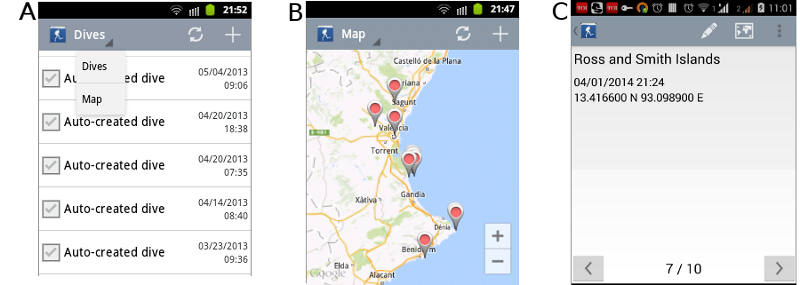
Upon selecting a dive (not selecting the check box), the name given to it, date/time and GPS coordinates are shown with two options at the top of the screen:
-
Edit (pencil): Change the text name or other characteristics of the dive location.
Maps: Display a map showing the dive location. After editing and saving a dive location (see C above), upload it to the web service, as explained below.
Uploading dive locations
There are several ways to send locations to the server. The easiest is simply selecting the locations (See A below) and then touching the right arrow at the top right of the screen.
|
|
Be careful! The trash icon on the right means exactly what it should; it deletes the selected dive location(s). |
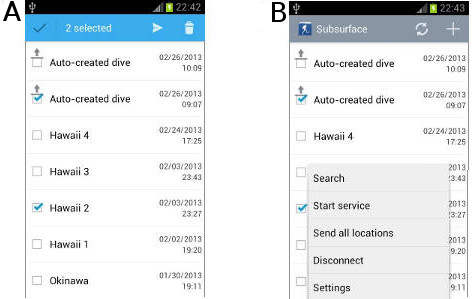
After a dive trip using the Companion App, all dive locations are ready to be downloaded to a Subsurface dive log (see below).
Settings on the Companion App
Selecting the Settings menu option results in the right hand image above (B).
Server and account
-
Web-service URL. This is predefined (http://api.hohndel.org/)
-
User ID. The DIVERID obtained by registering as described above. The easiest way to get it is to copy and paste from the confirmation email or just type it in.
Synchronisation
-
Synchronize on startup. If selected, dive locations in the Android device and those on the web service synchronize each time the app is started.
-
Upload new dives. If selected, each time the user adds a dive location it is automatically sent to the server.
Background service
Instead of entering an unique dive location, you can leave the service running in the background, allowing a continuous collection of GPS locations.
The settings below define the behavior of the service:
-
Min duration. In minutes. The app will try to get a location every X minutes until stopped by the user.
-
Min distance. In meters. Minimum distance between two locations.
-
Name template. The name the app will use when saving the locations.
|
|
How does the background service work? Assuming the diver sets 5 minutes and 50 meters in the settings above, the app will start by recording a location at the current location, followed by another one at every 5 minutes or every time one moves 50 m from previous location. If subsequent locations are within a radius of 50 meters from the previous one, a new location is not saved. If the diver is not moving, only one location is saved. If the diver is moving, a trace of the route is obtained by saving a location every 50 meters. |
Other
Mailing List. The mail box for Subsurface. Users can send an email to the Subsurface mailing list.
-
Subsurface website. A link to the URL of Subsurface web
-
Version. Displays the current version of the Companion App.
Search
Search the saved dive locations by name or by date and time.
Start service
Starts the background service following the previously defined settings.
Disconnect
This is admittedly a badly named option that disconnects the app from the server. It resets the user ID in the app, showing the first screen where an account can be created, retrieve the ID for an existing account or use the users own ID. The Disconnect option is useful if the Android device was used to download the dive locations of another registered diver.
Send all locations
This option sends all locations stored in the Android device to the server.
Using the Subsurface companion app on an iPhone to record dive locations
The iPhone interface is quite simple. Type the user ID (obtained during registration) into the space reserved for it, then select "Dive in" (see left part of the image below) and start collecting dive location information.

Dives can be added automatically or manually. In manual mode, a dive location or waypoint is added to the GPS input stream. In automatic mode, a continuous path of GPS locations is created from which, after import, Subsurface can select the appropriate GPS locations based on the times of dives. The default mode for the iphone is automatic. When adding a dive, the location service is started automatically and a red bar appears at the bottom of the screen. After the dive, click on the red bar to end the location service. While the location service is running you can only add dives manually.
You can edit the site name afterwards by selecting the dive from the dive list and clicking on the site name. There are no other editable fields. The dive list is automatically uploaded from the iPhone to the web service. There is no option to trigger upload manually.
Downloading dive locations to the Subsurface divelog
Download dive(s) from a dive computer or enter them manually into Subsurface before obtaining the GPS coordinates from the server. The download dialog can be reached via Ctrl+G or from the Subsurface Main Menu Import → Import GPS data from Subsurface Service, resulting in the image on the left (A), below. On first use the DIVERID text box is blank. Provide a DIVERID, then select the Download button to start the download process, after which the screen on the right (B) below appears:

Note that the Apply button is now active: selecting it updates the locations of the newly entered or uploaded dives in Subsurface, i.e. it applies the coordinates and names entered on the app to all the new dives that match the date-times of the uploaded GPS localities. The names of dive locations entered within Subsurface (i.e. before downloading the GPS coordinates) have precedence over downloaded dive locations.
Since Subsurface matches GPS locations from the mobile device and dive information from the dive computer based on date-time data, automatic assignment of GPS data to dives depends on agreeing date-time information between the two devices. Although Subsurface has a wide range tolerance, it may not be able to identify the appropriate dive if there is a large difference between the time in the dive computer and that of the Android device. This results in no updates.
Similar date-times may not always be possible and there may be many reasons for this (e.g. time zones). Subsurface may also be unable to decide which is the correct position for a dive (e.g. on repetitive dives while running background service there may be several locations that would be included in the time range that fit not only the first dive, but one or more subsequent dives as well). A workaround to manually edit the date-time of a dive in the Subsurface Dive List before downloading the GPS data and then to change the date-time back again after downloading GPS data.
|
|
TIPS: |
-
Background service may fill the location list with unnecessary locations that don’t correspond to the exact dive point but do correspond to the boat’s route. Right now, these locations are difficult to delete from the server. In some situations it is better to clean up the list on the mobile device before sending the dive points to the web server by simply deleting the inappropriate locations. This might be necessary, for instance, to keep the location list clear to see dives in the web service map display (see above).
-
It may also be useful to give informative names to the locations sent to the web server, or at least to use an informative name in the Name Template setting while running the background service, especially on a dive trip with many dives and dive locations.
5.5. Adding photographs to dives
Many (if not most) divers take photographs during a dive. Subsurface allows the storage and display of photographs for each dive. Photos are superimposed on the dive profile at the times during the dive when they were taken. They can also be viewed from the dive profile.
5.5.1. Loading photos and synchronizing between dive computer and camera
Left-lick on a dive or on a group of dives on the dive list, bringing up the Dive list context Menu. Right-click the appropriate option to import images either from file or from the Internet. The system file browser appears. Select the folder and photographs that need to be loaded into Subsurface and click the Open button.
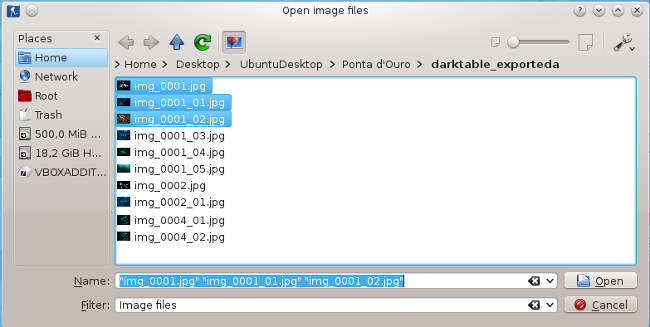
This brings up the time synchronization dialog, shown below. The time synchronization is not perfect between the dive computer used during a dive, and the camera used during that same dive. These two devices often differ by several minutes. Subsurface attempts to synchronize these two devices so that the exact times of photographs can be used to position photographs on the dive profile.
Subsurface synchronizes camera with dive computer in three ways:
-
Pro-actively: Before the dive, ensure synchronization of the dive computer time settings with the time settings of the camera by changing the date-time settings on one or both of these devices.
-
Manually: Writing down the exact camera time at the start of a dive allows using the difference in time between the two devices. As long as the device settings for time has not been changed in either device, the times of both devices after the dive or even at the end of the day allows manually setting the time difference in the Time shift dialog (see image below). Towards the top of the dialog is a time setting tool immediately under the heading Shift times of image(s) by, in the image below. If the camera time is 7 minutes later than that of the dive computer, set the time setting tool to a value of 00:07 and select the Earlier radio button. This is appropriate, since the photos need to be shifted 7 minutes earlier (camera is 7 minutes ahead of dive computer). Ignore any "AM" or "PM" suffix in that tool. Click the OK button and synchronization is done.
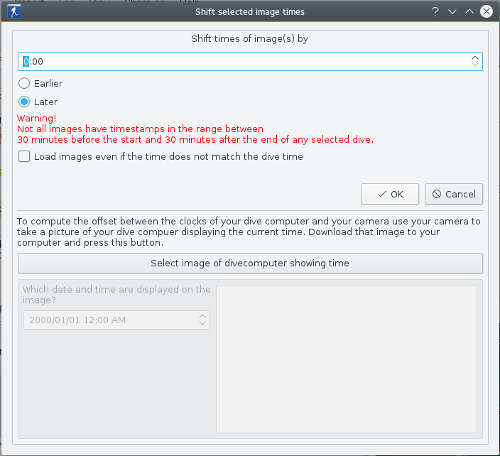
-
By photograph: There is a very slick way of achieving synchronization, requiring a photograph of the face of the dive computer showing the time. Subsurface gets the exact time the photograph was taken, using the metadata the camera stores within each photo and compares this with the time visible on the photo. To do this, use the bottom half of the Time shift dialog. In this case the top part of the dialog is ignored. Click on the horizontal bar called Select image of dive computer showing time. This brings up a file browser for selecting the photograph of the dive computer time. Select the photograph using the file browser and click on OK. This photograph of the dive computer appears in the bottom panel of the Shift times dialog. Now Subsurface knows exactly when the photograph was taken. Now set the date-time dialog to the left of the photo so it reflects the date and time of the dive computer in the photo. When the date-time tool has been set, Subsurface knows exactly what the time difference between camera and dive computer is, and it can synchronize the devices. The image below shows a photograph of the face of the dive computer and with the date-time tool set to the date-time.
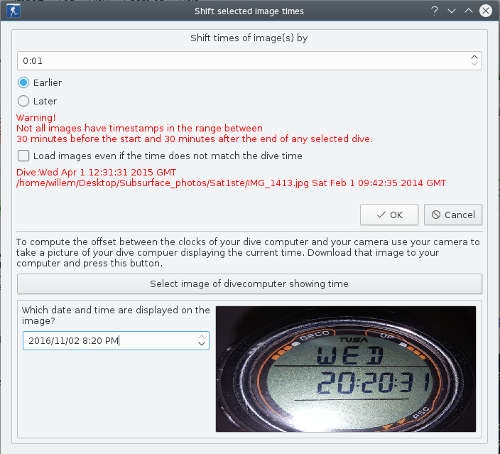
If the timestamp of a photograph is more than 30 minutes before or after the dive, it is not placed on the dive profile (see the red warning in the image above). However, If the appropriate checkbox is selected (see image above) these images can still be placed on the Photos tab of the Notes panel so that all photos associated with a dive are visible, including photos taken before or after the dive.
5.5.2. Viewing the photos
After the images have been loaded, they appear in two places:
-
the Photos tab of the Notes panel (left part of image below).
-
as tiny icons (stubs) on the dive profile at the appropriate positions reflecting the time each photograph was taken. To view the photos on the dive profile, activate the show-photos button in the tool bar to the left of the dive profile:
This results in a profile display as in the image below:
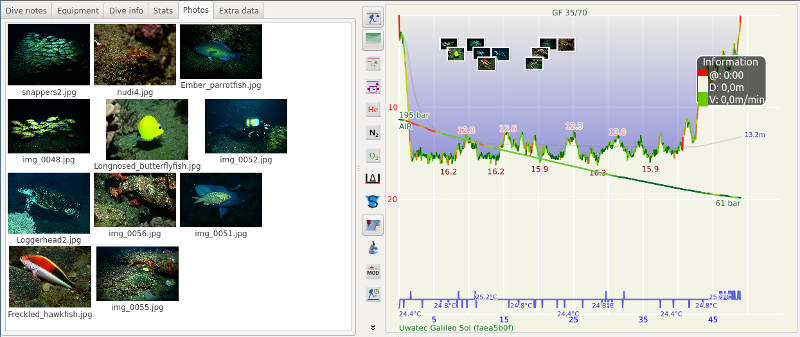
Hover the mouse over any of the photo stubs. A thumbnail photo is shown of the appropriate photo. See the image below:
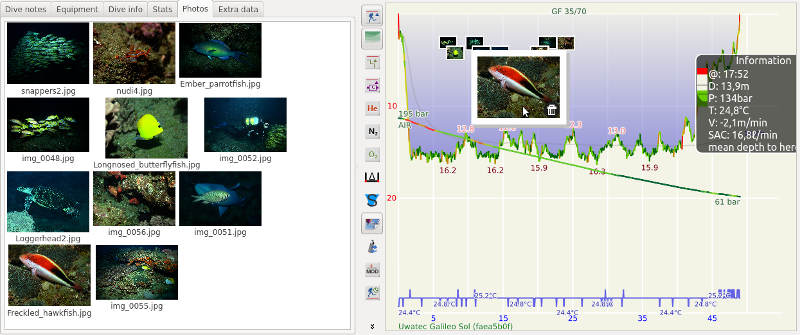
Clicking on the thumbnail brings up a full size photo overlaid on the Subsurface window, allowing a good view of the photographs (see the image below). Note that the thumbnail has a small dustbin icon in the bottom right hand corner (see image above). Selecting the dustbin removes the image from the dive. Be careful when clicking on a thumbnail. Images can also be deleted using the Photos tab (see text below).
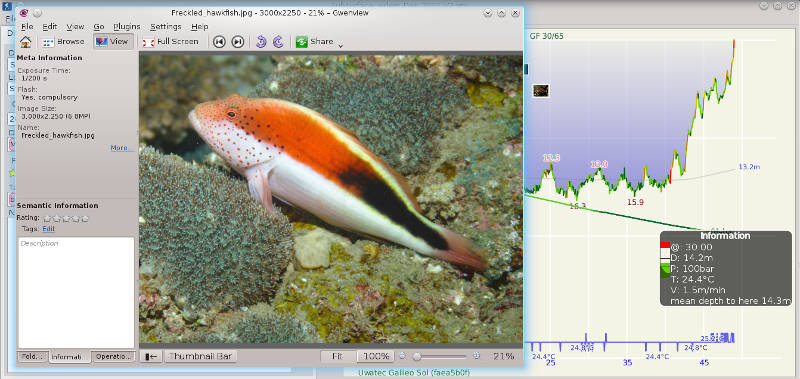
5.5.3. The Photos tab
Photographs associated with a dive are shown as thumbnails in the Photos tab of the Notes panel. Photos taken in rapid succession during a dive (therefore sometimes with large overlap on the dive profile) can easily be accessed in the Photos tab. This tab serves as a tool for individually accessing the photos of a dive, while the stubs on the dive profile show when during a dive a photo was taken. Single-click a thumbnail in the Photos panel to select a photo. Double-click a thumbnail to view the full-sized image, overlaying the Subsurface window. Deleted a photo from the Photos panel by selecting it (single-click) and then by pressing the Del key on the keyboard. This removes the photo BOTH from the Photos tab as well as the dive profile.
5.5.4. Photos on an external hard disk
Most underwater photographers store photos on an external drive. If such a drive can be mapped by the operating system (almost always the case) the photos can be directly accessed by Subsurface. This eases the interaction between Subsurface and an external repository of photos. When associating a dive profile with photos from an external drive, the normal procedure of selection and synchronization (see text above) is used. After the external drive has been disconnected, Subsurface cannot access these photos any more. If the display of photos is activated (using the toolbox icon to the left of the Dive Profile), the program shows a small white dot where each photo should be on the dive profile. In addition the Photos tab shows only the file names of the photos. If the external drive with the photos is re-connected, the photos can be seen in the normal way.
5.5.5. Moving photographs among directories, hard disks or computers
After a photograph has been loaded into Subsurface and associated with a specific dive, Subsurface saves the directory path where the photo lies as well as the file name of the photo, in order to find it when the dive is opened again. If the photo or the whole photo collection is moved to another drive or to a different machine, the path to the photo changes. Now, Subsurface looks for the photos at their original location before they were moved, cannot find them and cannot display them. Because, after moving photos, large numbers of photos may need to be deleted and re-imported from the new location, Subsurface has a mechanism to ease this inconvenience: automatic updates using fingerprints.
When a photo is loaded into Subsurface, a fingerprint for the image is calculated and stored with the other reference information for that photo. After moving a photo collection (that has already been loaded into Subsurface) to a different directory, disk or computer, Subsurface can:
-
look through a particular directory (and all its subdirectories recursively) where photos have been moved to,
-
calculate fingerprints for all photos in this directory, and
if there is a match between a calculated fingerprint and the one calculated when a photo was originally loaded into Subsurface (even if the original file name has changed), automatically update the directory information so that Subsurface can find the photo in the new moved directory.
This is done by selecting from the Main Menu: File → Find moved images. This brings up a window within which the NEW directory of the photos needs to be specified. Select the appropriate directory and click the Scan button towards the bottom right of the panel. The process may require several minutes to complete, after which Subsurface will show the appropriate photographs when a particular dive is opened.
5.6. Logging special types of dives
This section gives examples of the versatility of Subsurface as a dive logging tool.
5.6.1. Multicylinder dives
Subsurface easily handles dives involving more than one cylinder. Multi-cylinder diving usually happens (a) if a diver doesn’t have enough gas for the complete dive in a single cylinder; (b) if a diver needs more than one gas mixture because of the depth or the decompression needs of the dive. For this reason multi-cylinder dives are often used by technical divers who dive deep or long. As far as Subsurface is concerned, there are only two types of information that need to be provided:
-
Describe the cylinders used during the dive This is performed in the Equipment tab of the Info panel, as described above. Enter the cylinders one by one, specifying its size and pressure, as well as the gas composition within it.
-
Record the times at which the switch from one cylinder to another was done: This is information tracked by some dive computers (provided the diver indicated these changes to the dive computer by pressing specific buttons). If the dive computer does not provide the information, the diver has to record these changes using a different method, e.g. writing it on a slate or by creating a bookmark on the dive computer.
-
Record the cylinder changes on the dive profile: If the latter option was followed, the diver needs to indicate the gas change event by right-clicking at the appropriate point in time on the Dive Profile panel and indicating the cylinder to which the change was made. After right-clicking, follow the context menu to "Add gas change" and select the appropriate cylinder from those defined during the first step, above (see image below). If the tank bar button in the toolbar has been activated, the cylinder switches are also indicated in the tank bar (image below).
When this is complete, Subsurface indicates the appropriate use of cylinders in the dive profile. Below is a two-cylinder dive, starting off with EAN28, then changing cylinders to EAN50 after 26 minutes for decompression.
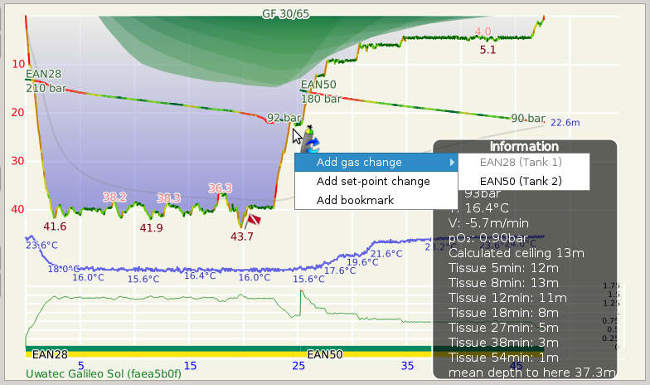
5.6.2. Sidemount dives
Sidemount diving is just another form of multi-cylinder diving, often with both or all cylinders having the same gas mixture. Although it’s a popular configuration for cave divers, sidemount diving can be done by recreational divers who’ve completed the appropriate training. Sidemount dive logging involves three steps, exactly as with multi-cylinder dives above:
-
During the dive, record cylinder switch events. Since sidemount diving normally involves two cylinders with air or with the same gas mixture, Subsurface distinguishes between these different cylinders. In contrast, many dive computers that allow gas switching only distinguish between different gases used, not among different cylinders used. This means when sidemount dives are downloaded from these dive computers, the switching event between cylinders with the same gas is not downloaded. This may mean that a diver may have to keep a written log of cylinder switch times using a slate, or (if the dive computer has the capability) marking each cylinder switch with a bookmark that can be retrieved later. Returning from a dive with the times of cylinder changes is the only tedious part of logging sidemount dives.
-
Within Subsurface describe the cylinders used during the dive. The diver needs to provide the specifications of the different cylinders, using the Equipment tab of the Info Panel (see image below where two 12 litre cylinders were used).
-
Indicate cylinder change events on the Subsurface dive profile. Once the dive log has been imported from a dive computer into Subsurface, the cylinder switch events need to be shown on the dive profile. Cylinder changes are recorded by right-clicking at the appropriate point on the dive profile, then selecting Add gas change. A list of the appropriate cylinders is shown with the currently used cylinder greyed out. In the image below Tank 1 is greyed out, leaving only Tank 2 to be selected. Select the appropriate cylinder. The cylinder change is then shown on the dive profile with a cylinder symbol. If the Tank Bar is activated using the toolbar to the left of the profile, then the cylinder change is also shown on the Tank Bar (see image below). After all the cylinder change events have been recorded on the dive profile, the correct cylinder pressures for both cylinders are shown on the dive profile, as in the image below.
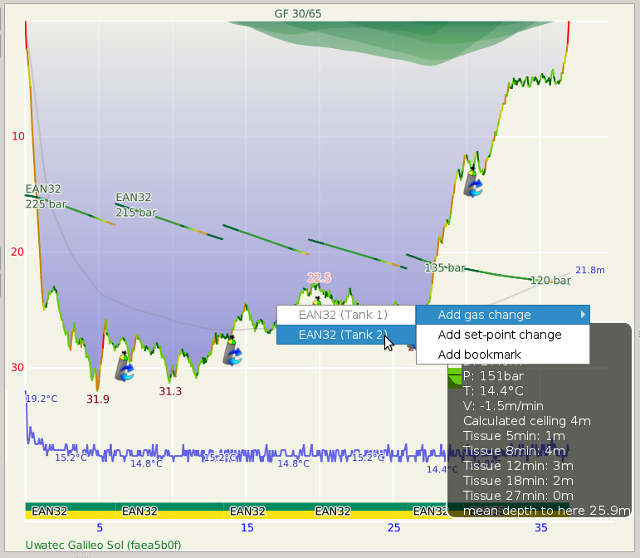
5.6.3. Semi-closed circuit rebreather (SCR) dives
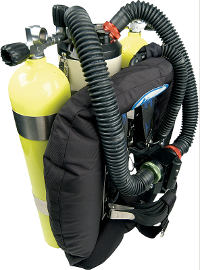
|
Passive semi-closed rebreathers (pSCR) are a technical advance in diving equipment that recirculates the breathing gas a diver uses, while removing carbon dioxide from the exhaled gas. While a small amount (typically a tenth) of the exhaled breathing gas is released into the water, a small amount of fresh gas is released from the back gas cylinder (typically containing nitrox). A diver using a single cylinder of breathing gas can therefore dive for much longer periods than using a recreational open-circuit configuration. With pSCR equipment, a very small amount of breathing gas is released every time the diver inhales. With active SCR (aSCR) equipment, in contrast, a small amount of breathing gas is released continuously from the back cylinder. |
To log pSCR dives, no special procedures are required. Use the normal steps outlined above:
-
Select pSCR in the Dive Mode dropdown list on the Info panel.
-
pSCR diving often involves gas changes, requiring an additional cylinder. Define all the appropriate cylinders as described above and indicate the cylinder/gas changes as described above in the section on multicylinder dives.
If a pSCR Dive Mode has been selected, the dive ceiling for that is adjusted for the oxygen drop across the mouthpiece, which often requires longer decompression periods. Below is a dive profile of a pSCR dive using EAN36 on the back cylinder and oxygen for decompression. Note that this dive lasted over two hours.
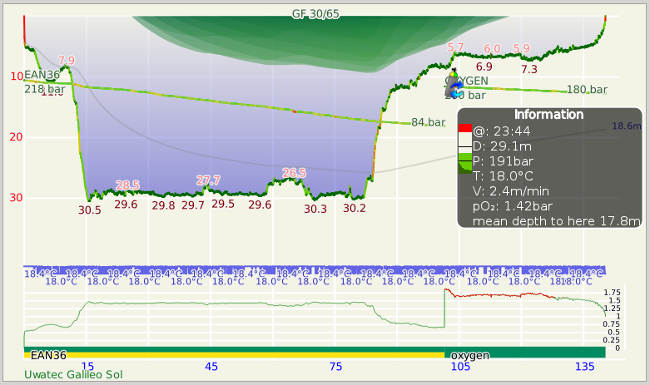
5.6.4. Closed circuit rebreather (CCR) dives
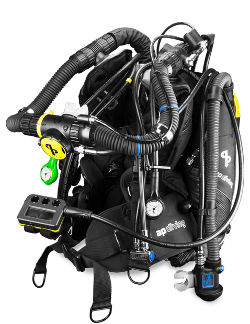
|
Closed system rebreathers use advanced technology to recirculate gas that has been breathed. They also do two things to maintain a breathable oxygen concentration: a) remove carbon dioxide from the exhaled gas regulate the oxygen concentration to remain within safe diving limits. The CCR interface of Subsurface is currently experimental and under active development. Subsurface currently supports Poseidon MkVI and APD Discovery/Evolution dive computers. In contrast to a conventional recreational dive computer, a CCR system computer does not allow the download of a log containing multiple dives. Rather, each dive is stored independently. This means that Subsurface cannot download a dive log directly from a CCR dive computer, but that it imports individual CCR dive profiles in the same way it imports dive log data from other digital databases: one dive at a time. |
Import a CCR dive
See the section dealing with Importing dive information from other digital sources. CCR dive data are currently obtained from the proprietary software provided when purchasing CCR dice equipment. See Appendix B for more complete information. Use that software to download the dive data into a known directory. From the main menu of Subsurface, select Import → Import log files to bring up the universal import dialogue. As explained in that section, the bottom right hand of the import dialogue contains a dropdown list (labled Filter:) of appropriate devices that currently include (Poseidon) MkVI or APD log viewer files. Import for other CCR equipment is under active development. Having selected the appropriate CCR format and the directory where the original dive logs have been stored from the CCR dive computer, select a particular dive log file (in the case of the MkVI it is a file with a .txt extension). After selecting the appropriate dive log, click the Open button at the bottom right hand of the universal import dialogue. The selected dive is imported to the Subsurface dive list.
Displayed information for a CCR dive
Partial pressures of gases: The graph of oxygen partial pressure shows the information from the oxygen sensors of the CCR equipment. In contrast to recreational equipment (where pO2 values are calculated based on gas composition and dive depth), CCR equipment provide actual measurements of pO2, derived from oxygen sensors. In this case the graph for oxygen partial pressure should be fairly flat, reflecting the setpoint settings during the dive. The mean pO2 is NOT the mean oxygen partial pressure as given by the CCR equipment, but a value calculated by Subsurface as follows:
-
For TWO O2 sensors the mean value of the two sensors are given.
-
For THREE-sensor systems (e.g. APD), the mean value is also used. However differences of more than 0,1 bar in the simultaneous readings of different sensors are treated as false. If one of the three sensors provides false data, it is ignored.
-
If no sensor data are available, the pO2 value is assumed to be equal to the setpoint.
The mean pO2 of the sensors is indicated with a green line,
The oxygen setpoint values as well as the readings from the individual oxygen sensors can be shown. The display of additional CCR information is turned on by checking the appropriate boxes in the Preferences panel (accessible by selecting File → Preferences → Graph). This part of the Preferences panel is shown in the image below, representing two checkboxes that modify the display of pO2 when the appropriate toolbar button on the Dive Profile has been checked.

Checking any of these boxes allows the display of additional oxygen-related information whenever the pO2 toolbar button on the Profile panel is activated. The first checkbox allows the display of setpoint information. This is a red line superimposed on the green oxygen partial pressure graph and allows a comparison of the mean measured oxygen partial pressure and the setpoint values, as shown below.

The second checkbox allows the display of the data from each individual oxygen sensor of the CCR equipment. The data for each sensor is colour-coded as follows:
-
Sensor 1: grey
-
Sensor 2: blue
-
Sensor 3: brown
The mean oxygen pO2 is indicated by the green line. This allows the direct comparison of data from each of the oxygen sensors, useful for detecting abnormally low or erratic readings from a particular sensor.

The setpoint data can be overlaid on the oxygen sensor data by activating both of the above check boxes. Partial pressures for nitrogen (and helium, if applicable) are shown in the usual way as for open circuit dives.
Events: Several events are logged, e.g. switching the mouthpiece to open circuit. These events are indicated by yellow triangles and, if you hover over a triangle, a description of that event is given as the bottom line in the Information Box.
Cylinder pressures: Some CCR dive computers like the Poseidon MkVI record the pressures of the oxygen and diluent cylinders. The pressures of these two cylinders are shown as green lines overlapping the depth profile. In addition, start and end pressures for both oxygen and diluent cylinders are shown in the Equipment Tab. Below is a dive profile for a CCR dive, including an overlay of setpoint and oxygen sensor data, as well as the cylinder pressure data. In this case there is agreement from the readings of the two oxygen sensors.
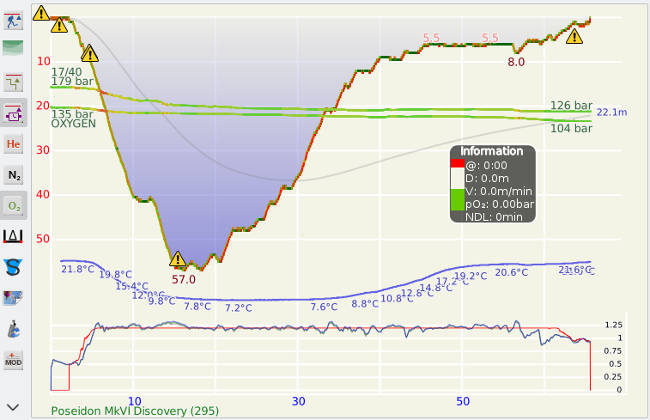
Equipment-specific information: Equipment-specific information gathered by Subsurface is shown in the Extra data tab. This may include setup information or metadata about the dive.
The deco ceiling calculated by Subsurface is not very accurate because the precise pressure of nitrogen in the loop can usually not be determined from the dive log imported from the CCR equipment. Many CCR dive computers, however, report an internally-calculated deco ceiling that is reported in the dive log, reflecting a more accurate assessment. The display of this ceiling is activated by clicking the appropriate button to the left of the dive profile:
The default color of the computer-generated deco ceiling is white. This can be set to red by checking the appropriate check box after selecting File → Preferences → Graph. Below is a dive profile indicating the dive computer-generated deco ceiling:
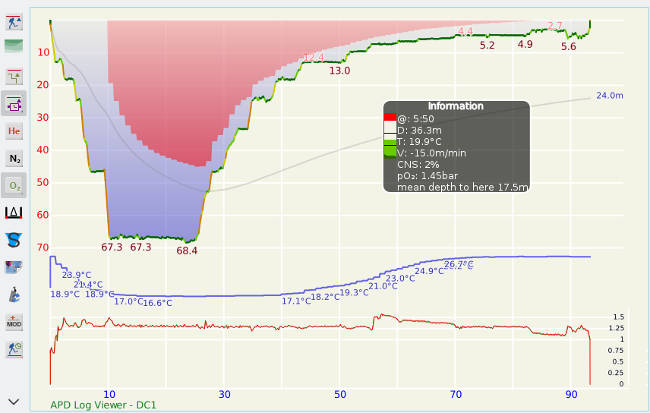
More equipment-specific information for downloading CCR dive logs for Poseidon MkVI and APD equipment can be found in Appendix B.
6. Obtaining more information about dives entered into the logbook
6.1. The Info tab (for individual dives)
The Info tab gives some summary information about a particular dive that has been selected in the Dive List. Useful information here includes the surface interval before the dive, the maximum and mean depths of the dive, the gas volume consumed, the surface air consumption (SAC) and the number of oxygen toxicity units (OTU) incurred.
|
|
Gas consumption and SAC calculations: Subsurface calculates SAC and Gas consumption taking in account gas incompressibility, particularly at tank pressures above 200 bar, making them more accurate. Refer to Appendix F for more information. |
6.2. The Extra Data tab (usually for individual dives)
When using a dive computer, it often reports several data items that cannot easily be presented in a standardised way because the nature of the information differs from one dive computer to another. These data often comprise setup information, metadata about a dive, battery levels, no fly times, or gradient factors used during the dive. When possible, this information is presented in the Extra Data tab. Below is an image showing extra data for a dive using a Poseidon rebreather.
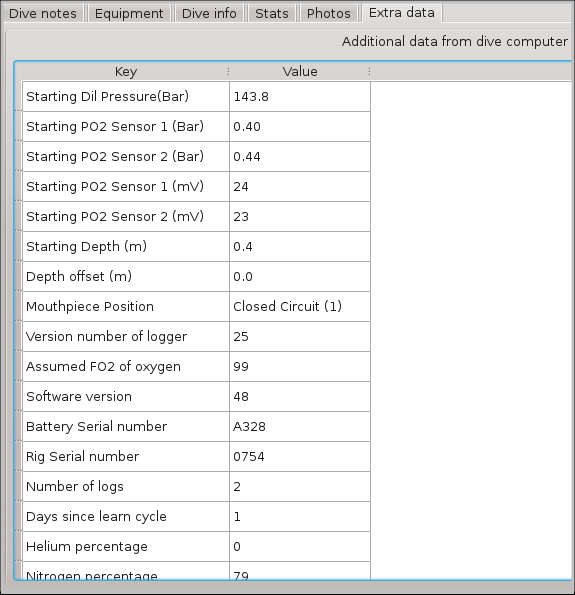
6.3. The Stats tab (for groups of dives)
The Stats tab gives summary statistics for more than one dive, assuming that more than one dive has been selected in the Dive List using the standard Ctrl-click or Shift-click of the mouse. If only one dive has been selected, figures for only that dive are given. This tab shows the number of dives selected, the total amount of dive time in these dives, as well as the minimum, maximum and mean for the dive duration, water temperature and surface air consumption (SAC). It also shows the depth of the shallowest and deepest dives of those selected.
6.4. The Dive Profile

Of all the panels in Subsurface, the Dive Profile contains the most detailed information about each dive. The Dive Profile has a button bar on the left hand side, allowing control of several display options. The functions of these buttons are described below. The main item in the Dive Profile is the graph of dive depth as a function of time. In addition to depth, it also shows the ascent and descent rates compared to the recommended speed of going up or down in the water column. This information is given using different colors:
Couleur |
Vitesse de descente (m/min) |
Vitesse de remontée (m/min) |
Rouge |
> 30 |
> 18 |
Orange |
18 - 30 |
9 - 18 |
Jaune |
9 - 18 |
4 - 9 |
Vert clair |
1.5 - 9 |
1.5 - 4 |
Vert foncé |
< 1.5 |
< 1.5 |
The profile also includes depth readings for the peaks and troughs in the graph. So users should see the depth of the deepest point and other peaks. Mean depth is plotted as a grey line, indicating mean dive depth up to a particular moment during the dive.
|
|
In some cases the dive profile does not fill the whole area of the Dive Profile panel. Clicking the Scale button in the toolbar on the left of the dive profile increases the size of the dive profile to fill the area of the panel. |
Water temperature is shown as a blue line with temperature values placed adjacent to significant changes.
6.4.1. The Information Box
The Information box displays a large range of information about the dive profile. Normally the Information Box is located to the top left of the Dive Profile panel. If the mouse points outside of the Dive Profile panel, then only the top line of the Information Box is visible (see left-hand part of figure (A) below). The Information Box can be moved around in the Dive Profile panel by click-dragging it with the mouse so that it is not obstructing important detail. The position of the Information Box is saved and used again during subsequent dive analyses.
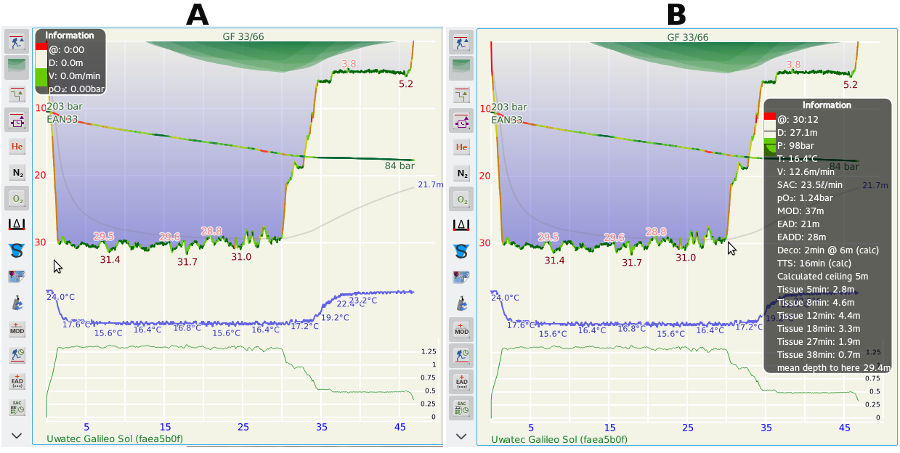
When the mouse points inside the Dive Profile panel, the information box expands and shows many data items. In this situation, the data reflect the time point along the dive profile shown by the mouse cursor (see right-hand part of figure (B) above where the Information Box reflects the situation at the position of the cursor [arrow] in that image). Moving the cursor horizontally lets the Information Box show information for any point along the dive profile. It gives extensive statistics about depth, gas and ceiling characteristics of the particular dive. These include: Time period into the dive (indicated by a @), depth, cylinder pressure (P), temperature, ascent/descent rate, surface air consumption (SAC), oxygen partial pressure, maximum operating depth, equivalent air depth (EAD), equivalent narcotic depth (END), equivalent air density depth (EADD), decompression requirements at that instant in time (Deco), time to surface (TTS), the calculated ceiling, as well as of the statistics in the Information Box, shown as four buttons on the left of the profile panel. These are:
|
|
Show the Maximum Operating Depth (MOD) of the dive, given the gas mixture used. MOD is dependent on the oxygen concentration in the breathing gas. For air (21% oxygen) it is around 57 m if a maximum pO2 of 1.4 is specified in the Preferences section (select File → Preferences → Graph and edit the text box pO2 in calculating MOD. When diving below the MOD there is a markedly increased risk of exposure to the dangers of oxygen toxicity. |
|
|
Show either the No-deco Limit (NDL) or the Total Time to Surface (TTS). NDL is the time duration that a diver can continue with a dive, given the present depth, that does not require decompression (that is, before an ascent ceiling appears). Once a diver has exceeded the NDL and decompression is required (that is, there is an ascent ceiling above the diver) then TTS gives the number of minutes required before the diver can surface. TTS includes ascent time as well as decompression time. TTS is calculated assuming an ascent surface air consumption (SAC) for the gas currently used. Even if the profile contains several gas switches, TTS at a specific moment during the dive is calculated using the current gas. TTS longer than 2 hours is not accurately calculated and Subsurface only indicates TTS > 2h. |
|
|
Show the Surface Air Consumption (SAC), an indication of the surface-normalized respiration rate of a diver. The value of SAC is less than the real respiration rate because a diver at 10m uses breathing gas at a rate roughly double that of the equivalent rate at the surface. SAC gives an indication of breathing gas consumption rate independent of the depth of the dive, so the respiratory rates of different dives can be compared. The units for SAC is liters/min or cubic ft/min. |
|
|
Show the Equivalent Air Depth (EAD) for nitrox dives as well as the Equivalent Narcotic Depth (END) for trimix dives. These are important to divers breathing gases other than air. Their values are dependent on the composition of the breathing gas. The EAD is the depth of a hypothetical air dive that has the same partial pressure of nitrogen as the current depth of the nitrox dive at hand. A nitrox dive leads to the same decompression obligation as an air dive to the depth equalling the EAD. The END is the depth of a hypothetical air dive that has the same sum of partial pressures of the narcotic gases nitrogen and oxygen as the current trimix dive. A trimix diver can expect the same narcotic effect as a diver breathing air diving at a depth equalling the END. |
Figure (B) above shows an information box with a nearly complete set of data.
The Gas Pressure Bar Graph
On the left of the Information Box is a vertical bar graph showing the pressures of the nitrogen (and other inert gases, e.g. helium, if applicable) that the diver was inhaling at a particular instant during the dive, shown by the position of the cursor on the Dive Profile. The drawing on the left below indicates the meaning of the different parts of the Gas Pressure Bar Graph.

-
The light green area indicates the gas pressure, with the top margin of the light green area showing the total gas pressure of ALL gases inhaled by the diver and measured from the bottom of the graph to the top of the light green area. This pressure has a relative value in the graph and does not indicate absolute pressure.
-
The horizontal black line underneath the light green margin indicates the equilibrium pressure of the INERT gases inhaled by the diver, usually nitrogen. In the case of trimix, it is the pressures of nitrogen and helium combined. In this example, the user is diving with EAN32, so the equilibrium inert gas pressure is 68% of the distance from the bottom of the graph to the total gas pressure value.
-
The dark green area at the bottom of the graph represents the pressures of inert gas in each of the 16 tissue compartments, following the Bühlmann algorithm, with fast tissues on the left hand side.
-
The top black horizontal line indicates the inert gas pressure limit determined by the gradient factor that applies to the depth of the diver at the particular point on the Dive Profile. The gradient factor shown is an interpolation between the GFLow and GFHigh values specified in the Graph tab of the Preferences Panel of Subsurface.
-
The bottom margin of the red area in the graph indicates the Bühlman-derived M-value. That is the pressure value of inert gases at which bubble formation is expected to be severe, resulting in a significant risk of decompression sickness.
These five values are shown on the left in the image above. The way the Gas Pressure Bar Graph changes during a dive can be seen on the right hand side of the above figure for a diver using EAN32.
-
Graph A indicates the start of a dive with the diver at the surface. The pressures in all the tissue compartments are still at the surface equilibrium pressure because no diving has taken place.
-
Graph B indicates the situation after a descent to 30 meters. Few of the tissue compartments have had time to respond to the descent, so their gas pressures are far below the equilibrium gas pressure.
-
Graph C represents the pressures after 30 minutes at 30 m. The fast compartments have attained equilibrium (i.e. they have reached the height of the black line indicating the equilibrium pressure). The slower compartments (towards the right) have not reached equilibrium and are in the process of slowly increasing in pressure.
-
Graph D shows the pressures after ascent to a depth of 4.5 meters. Since during ascent the total inhaled gas pressure has decreased strongly from 4 bar to 1.45 bar, the pressures in the different tissue compartments now exceed that of the total gas pressure and approach the gradient factor value (i.e. the top black horizontal line). Further ascent will result in exceeding the gradient factor value (GFHigh), endangering the diver.
-
Graph E indicates the situation after remaining at 4.5 meters for 10 minutes. The fast compartments have decreased in pressure. As expected, the pressures in the slow compartments have not changed much. The pressures in the fast compartments do not approach the GFHigh value any more and the diver is safer than in the situation indicated in graph D.
6.4.2. The Profile Toolbar
The dive profile can include graphs of the partial pressures of O2, N2, and He during the dive (see figure above) as well as a calculated and dive computer reported deco ceilings (only visible for deep, long, or repetitive dives). Partial pressures of oxygen are indicated in green, nitrogen in black, and helium in dark red. These partial pressure graphs are shown below the profile data.
|
|
Show the partial pressure of oxygen during the dive. This is shown below the dive depth and water temperature graphs. |
|
|
Show the partial pressure of nitrogen during the dive. |
|
|
Display of the partial pressure of helium during the dive. This is only important to divers using Trimix, Helitrox or similar breathing gasses. |
The air consumption graph displays the tank pressure and its change during the dive. The air consumption takes depth into account so that even when manually entering the start and end pressures the graph, is not a straight line. Like the depth graph, the slope of the tank pressure provides information about the momentary SAC rate (Surface Air Consumption) when using an air integrated dive computer. Here the color coding is not relative to some absolute values but relative to the mean normalized air consumption during the dive. So areas in red or orange indicate times of increased normalized air consumption while dark green reflects times when the diver was using less gas than average.
|
|
Clicking on the heart rate button allows display of heart rate information during the dive if the dive computer was attached to a heart rate sensor. |
It is possible to zoom into the profile graph. This is done either by using the scroll wheel / scroll gesture of the mouse or trackpad. By default Subsurface always shows a profile area large enough for at least 30 minutes and 30m (100ft) – this way short or shallow dives are easily recognizable; something free divers won’t care about.
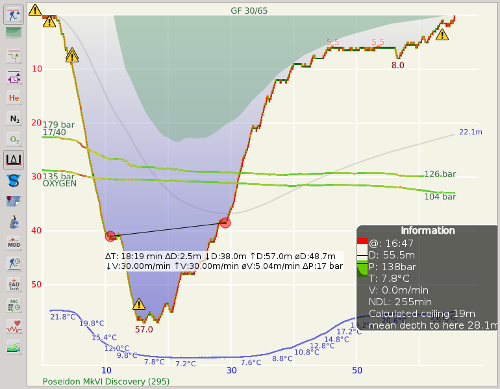
|
|
Measurements of depth or time differences can be achieved by using the ruler button on the left of the dive profile panel. The measurement is done by dragging the red dots to the two points on the dive profile that you wish to measure. Information is then given in the horizontal white area underneath the two red dots. |
|
|
Photographs that have been added to a dive can be shown on the profile by selecting the Show-photo button. The position of a photo on the profile shows the exact time when this photo was taken. If this button is not active, the photos are hidden. |
The profile can also include the dive computer reported ceiling (more precisely, the deepest deco stop that the dive computer calculated for each particular moment in time) as a red overlay on the dive profile. Ascent ceilings occur when a direct ascent to the surface increases the risk of a diver suffering from decompression sickness (DCS) and it is necessary to either ascend slower or to perform decompression stop(s) before ascending to the surface. Not all dive computers record this information and make it available for download; for example none of the Suunto dive computers make these data available to divelog software. Subsurface also calculates ceilings independently, shown as a green overlay on the dive profile. Because of the differences in algorithms used and amount of data available (and other factors taken into consideration at the time of the calculation) it’s unlikely that ceilings from dive computers and from Subsurface are the same, even if the same algorithm and gradient factors (see below) are used. It’s also quite common that Subsurface calculates a ceiling for non-decompression dives when the dive computer stayed in non-deco mode during the whole dive (represented by the dark green section in the profile at the beginning of this section). This is because Subsurface’s calculations describe the deco obligation at each moment during a dive, while dive computers usually take the upcoming ascent into account. During the ascent some excess nitrogen (and possibly helium) are already breathed off so even though the diver technically encountered a ceiling at depth, the dive still does not require a specific deco stop. This feature lets dive computers offer longer non-stop bottom times.
|
|
If the dive computer itself calculates a ceiling and makes it available to Subsurface during upload of dives, this can be shown as a red area by checking Dive computer reported ceiling button on the Profile Panel. |
|
|
If the Calculated ceiling button on the Profile Panel is clicked, then a ceiling, calculated by Subsurface, is shown in green if it exists for a particular dive (A in figure below). This setting can be modified in two ways: |
|
|
If, in addition, the show all tissues button on the Profile Panel is clicked, the ceiling is shown for the tissue compartments following the Bühlmann model (B in figure below). |
|
|
If, in addition, the 3m increments button on the Profile Panel is clicked, then the ceiling is indicated in 3 m increments (C in figure below). 
Gradient Factor settings strongly affect the calculated ceilings and their depths. For more information about Gradient factors, see the section on Gradient Factor Preference settings. The currently used gradient factors (e.g. GF 35/75) are shown above the depth profile if the appropriate toolbar buttons are activated. N.B.: The indicated gradient factors are NOT the gradient factors in use by the dive computer, but those used by Subsurface to calculate deco obligations during the dive. For more information external to this manual see: |
|
|
By selecting this icon, the different cylinders used during a dive can be represented as a colored bar at the bottom of the Dive Profile. In general oxygen is represented by a green bar, nitrogen a yellow bar and helium a red bar. The image below shows a dive which first uses a trimix cylinder (red and green), followed by a switch to a nitrox cylinder (yellow and green) after 23 minutes. Cylinders with air are shown as a light blue bar. |

|
|
Display the tissue heat-map. The heat map summarises, for the duration of the dive, the inert gas tissue pressures for each of the 16 tissue compartments of the Bühlmann model. Blue colours mean low gas pressures in a tissue compartment and thus on-gassing, green to red means excess gas in the tissue and thus off-gassing. Fast to slow tissues are indicated from top to bottom. The figure below explains in greater detail how the heat map can be interpreted. 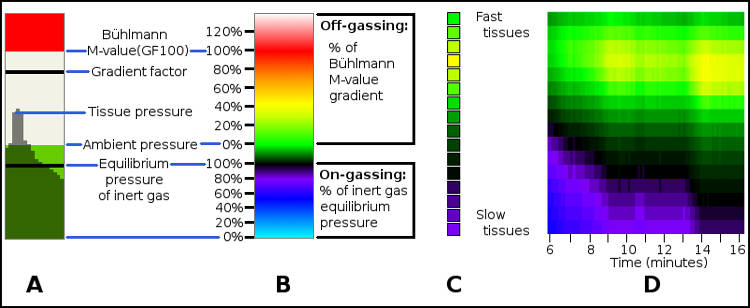
Image A on the left shows the Gas Pressure Graph in the Information box, representing a snapshot of inert gas pressures at a particular point in time during the dive. The inert gas pressures of 16 tissue compartments are shown as dark green vertical bars with the quick tissue compartments on the left and the slow tissue compartments on the right. Refer to the section on the Gas Pressure Graph for more details on the different elements of this graph. Image B shows a gradient of unique colours, spanning the whole range of inert gas pressures. It is possible to map the height of each of the dark green vertical bars of A to a colour in B. For instance, the fastest (leftmost) dark green verical bar in A has a height corresponding to the medium green part of B. The height of this bar can therefore be summarised using a medium green colour. Similarly, the highest dark green bar in A is as high as the yellow part of B. The 14 remaining tissue pressure bars in A can also be translated to colours. The colours represent three ranges of tissue inert gas pressure:
Image C shows the colour mapping of each of the vertical bars in A, the fast tissues (on the left in A) depicted at the top and the slow tissue compartments at the bottom of C. The highest vertical bar in A (vertical bar 3rd from the left) is presented as the yellow rectangle 3rd from the top in C. The 16 vertical bars in A are now presented as a vertical column of 16 coloured rectangles, representing a snapshot of tissue compartment gas pressures at a particular instant during the dive. Image D is a compilation of similar colour mappings of 16 tissue compartments during a 10-minute period of a dive, the colours representing the inert gas loading of a tissue compartment at a point in time during the dive. Faster tissues are shown at the top and slower tissues at the bottom, with time forming the horizontal axis of the graph. The column of rectangles in C can be found on the horizontal axis between 9 and 10 minutes. The colours of the heat map are not affected by the gradient factor settings. This is because the heat map indicates tissue pressures relative to the Bühlmann M-value gradient, and not relative to any specific gradient factor. For more information external to this manual see: Since the colours of the heat map are not affected by the gradient factor(s), the heat map is also applicable when using the VPM-B decompression model. The image below compares the profiles and heat maps for two planned decompression dives to 60m: the first using the Bühlmann decompression model, the second using the VPM-B decompression model. Both profiles have the same total decompression time, but the VPM-B model requires deeper stops early in the acent phase. In both profiles, the inert gas pressures in the faster tissues rise much more rapidly than the slower tissues during the descent and bottom phase, with the colors transitioning from light blue through blue and purple to black. Similarly, the inert gas pressure in the fast tissues reduces more rapidly than the slow tissues at each decompression stop, with colors transitioning from red, orange and yellow to green and black. The comparison of the two profiles and heatmaps shows that by including deep stops, the oversaturation gradient in the faster tissues early in ascent phase is reduced. However, on-gassing of slower tissues continues during the deep stops, which leads to greater oversaturation gradient in slower tissues at the end of the dive. 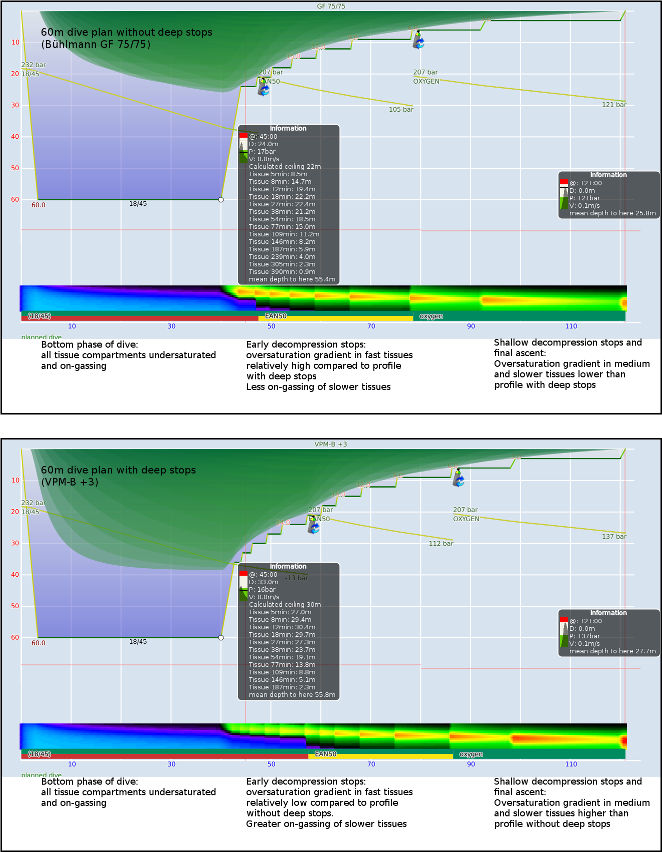
|
6.4.3. The Dive Profile context menu
The context menu for the Dive Profile is accessed by right-clicking while the mouse cursor is over the Dive Profile panel. The menu allows creating Bookmarks, Gas Change Event markers, or manual CCR set-point changes other than the ones that might have been imported from a Dive Computer. Markers are placed against the depth profile line, with the time of the event determined by the mouse cursor when the right mouse button was clicked to bring up the menu. Gas Change events involve a selection of which gas is being switched TO. The list of choices is based on the available gases defined in the Equipment Tab. Setpoint change events open a dialog letting you choose the next setpoint value. As in the planner, a setpoint value of zero shows the diver is breathing from an open circuit system while any non-zero value shows the use of a closed circuit rebreather (CCR). By right-clicking while over an existing marker a menu appears, adding options to allow deletion of the marker, or to allow all markers of that type to be hidden. Hidden events can be restored to view by selecting Unhide all events from the context menu.
7. Organizing the logbook (Manipulating groups of dives)
7.1. The Dive List context menu
Several actions on either a single dive, or a group of dives, can be performed using the Dive List Context Menu. It is found by selecting either a single dive or a group of dives and then right-clicking.
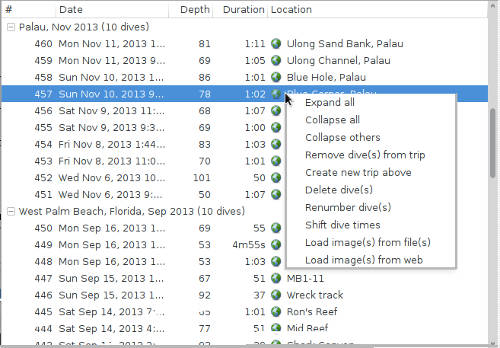
The context menu is used in many functions described below.
7.1.1. Customizing the columns showed in the Dive List panel
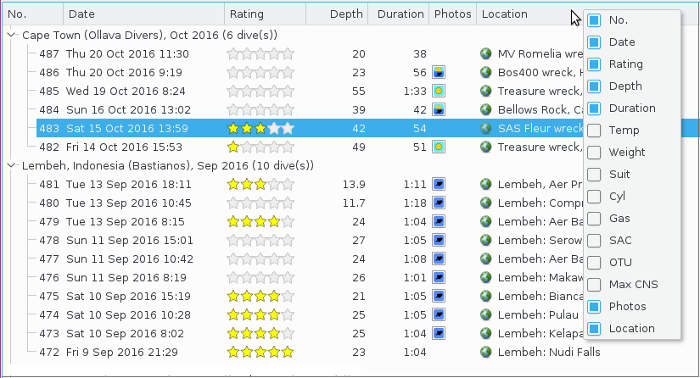
The default information in the Dive List includes, for each dive, Dive_number, Date, Rating, Dive_depth, Dive_duration and Dive_location. This information can be controlled and changed by right-clicking on the header bar of the Dive List. For instance, a right-click on the Date header brings up a list of items that can be shown in the dive list (see above). Select an item to be included in the Dive List or to be deleted (reflected by the check symbols) and the list is immediately updated. Preferences for information shown in the Dive List are saved and used when Subsurface is re-opened.
7.2. Renumbering the dives
Dives are normally numbered incrementally from non-recent dives (low sequence numbers) to recent dives (higher sequence numbers). Numbering of dives is not always consistent. For instance, when non-recent dives are added, correct numbering does not automatically follow on because of the dives that are more recent in date/time than the newly-added dive with an older date/time. This requires renumbering the dives. Do this by selecting (from the Main Menu) Log → Renumber. Provide the lowest sequence number to be used. This results in new sequence numbers (based on date/time) for all the dives in the Dive List panel.
Renumber a few selected dives in the dive list by selecting only the dives that need renumbering. Right-click on the selected list and use the Dive List Context Menu to perform the renumbering. A popup window appears letting the user specify the starting number for the process.
7.3. Grouping dives into trips and manipulating trips
For regular divers, the dive list can rapidly become very long. Subsurface can group dives into trips. It does this by grouping dives that have date/times not separated by more than two days and creating a single heading for each diving trip represented in the dive log. Below is an ungrouped dive list (A, on the left) as well as the corresponding grouped dive list of five dive trips (B, on the right):
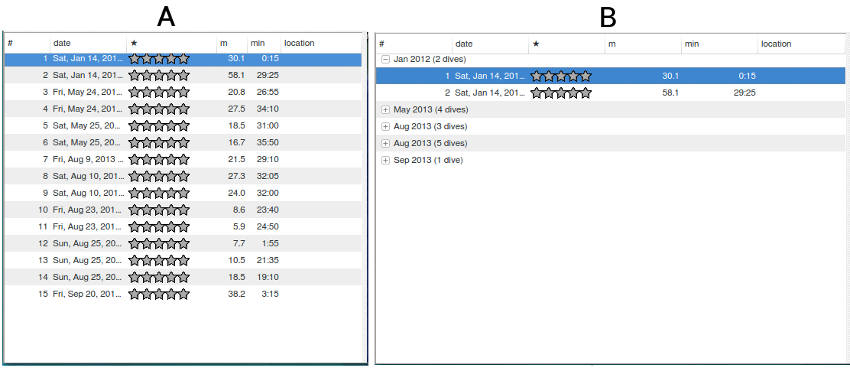
Grouping into trips allows a rapid way of accessing individual dives without having to scan a long lists of dives. To group the dives in a dive list, (from the Main Menu) select Log → Auto group. The Dive List panel now shows only the titles for the trips.
7.3.1. Editing the title and associated information for a particular trip
Normally, in the dive list, minimal information is included in the trip title. More information about a trip can be added by selecting its trip title bar from the Dive List. This shows a Trip Notes tab in the Notes panel. Here you can add or edit information about the date/time, the trip location and any other general comments about the trip as a whole (e.g. the dive company that was used, the general weather and surface conditions during the trip, etc.). After entering this information, select Save from the buttons at the top right of the Trip Notes tab. The trip title in the Dive List panel should now reflect the edited information.
7.3.2. Viewing the dives during a particular trip
Once the dives have been grouped into trips, you can expand one or more trips by clicking the expansion button [+/-] on the left of each trip title. This expands the selected trip, revealing individual dives during the trip.
7.3.3. Collapsing or expanding dive information for different trips
After selecting a particular trip in the dive list, the context menu allows several options to expand or collapse dives within trips. This includes expanding all trips and collapsing all trips.
7.3.4. Merging dives from more than one trip into a single trip
After selecting a trip title, the context menu allows the merging of trips by either merging the selected trip with the trip below or with the trip above. (Merge trip with trip below; Merge trip with trip above)
7.3.5. Splitting a single trip into more than one trip
If a trip includes ten dives, you can split this trip into two trips (trip 1: top 4 dives; trip 2: bottom 6 dives) by selecting and right-clicking the top four dives. The resulting context menu lets the user create a new trip by choosing the option Create new trip above. The top four dives are then grouped into a separate trip. The figures below show the selection and context menu on the left (A) and the completed action on the right (B):

7.4. Manipulating single dives
7.4.1. Delete a dive from the dive log
Dives can be permanently deleted from the dive log by selecting and right-clicking them to bring up the context menu, then selecting Delete dive(s). Typically this would apply to a case where a user wishes to delete workshop calibration dives of the dive computer or dives of extremely short duration.
7.4.2. Unlink a dive from a trip
You can unlink dives from the trip to which they belong. To do this, select and right-click the relevant dives to bring up the context menu. Then select the option Remove dive(s) from trip. The dive(s) now appear immediately above or below the trip to which they belonged, depending on the date and time of the unlinked dive.
7.4.3. Add a dive to the trip immediately above
Selected dives can be moved from the trip to which they belong and placed within a separate trip. To do this, select and right-click the dive(s) to bring up the context menu, and then select Create new trip above.
7.4.4. Shift the start time of dive(s)
Sometimes it’s necessary to adjust the start time of a dive. This may apply to situations where dives are done in different time zones or when the dive computer has a wrong time. To do this, select and right-click the dive(s) to be adjusted. This brings up the context menu on which the Shift times option should be selected. You must then specify the time (in hours and minutes) by which the dives should be adjusted and click on the option of whether the time adjustment should be earlier or later.
7.4.5. Merge dives into a single dive
Sometimes a dive is briefly interrupted, for example, if a diver returns to the surface for a few minutes, resulting in two or more dives being recorded by the dive computer and appearing as different dives in the Dive List panel. Merge these dives onto a single dive by selecting the appropriate dives, right-clicking them to bring up the context menu and then selecting Merge selected dives. It may be necessary to edit the dive information in the Notes panel to reflect events or conditions that apply to the merged dive. The figure below shows the depth profile of two dives that were merged:

7.4.6. Undo dive manipulations
Important actions on dives or trips, described above, can be undone or redone. This includes: delete dives, merge dives, renumber dives and shift dive times. To do this after performing any of these actions, from the Main Menu select Edit. This brings up the possibility to Undo or Redo an action.
7.5. Filtering the dive list
The dives in the Dive List panel can be filtered, selecting only some of the dives based on their attributes, e.g. dive tags, dive site, dive master, buddy or protective clothing. For instance, filtering lets you list the deep dives at a particular dive site, or otherwise the cave dives with a particular buddy.
To open the filter, select Log → Filter divelist from the main menu. This opens the Filter Panel at the top of the Subsurface window. Three icons are located at the top right hand of the filter panel (see image below). The Filter Panel can be reset (i.e. all current filters cleared) by selecting the yellow angled arrow. The Filter Panel may also be minimized by selecting the green up-arrow. When minimized, only these three icons are shown. The panel can be maximized by clicking the same icon that minimized it. The filter may also be reset and closed by selecting the red button with the white cross.

Four filter criteria may be used to filter the dive list: dive tags, person (buddy / divemaster), dive site and dive suit. Each of these is represented by a check list with check boxes. Above each check list is a second-level filter tool, allowing the listing of only some attributes within that check list. For instance, typing "ca" in the filter text box above the tags check list, results in the list being reduced to "cave" and "cavern". Filtering the check list helps to rapidly find search terms for filtering the dive list.
To activate filtering of the dive list, check at least one check box in one of the four check lists. The dive list is then shortened to include only the dives that pertain to the criteria specified in the check lists. The four check lists work as a filter with AND operators. Subsurface filters therefore for cave as a tag AND Joe Smith as a buddy. But the filters within a category are inclusive - filtering for cave and boat shows those dives that have either one OR both of these tags.
8. Exporting the dive log or parts of the dive log
There are two ways to export dive information from Subsurface:
-
Exporter les informations de plongée vers Facebook
-
Exporter des informations de plongée vers d’autres destinations ou formats
8.1. Export des informations de plongée vers Facebook
L’export des plongées vers Facebook est géré différemment des autres types d’export car une connexion vers Facebook est nécessaire, nécessitant un identifiant et un mot de passe. À partir du menu principal, si vous sélectionnez Partager sur → Connecter à → Facebook, un écran de connexion s’affiche (image A sur la gauche, ci dessous). Entrez l’identifiant et le mot de passe Facebook. Une fois connecté à Facebook, le panneau de l’image B ci dessous est affiché, avec un bouton Déconnecter de Facebook pour fermer la connexion Facebook.

From the Subsurface window it’s easy to determine whether Subsurface has a valid connection to Facebook From the Main Menu, select Share on (image A, below). Normally, the Facebook option is greyed out. But if there is a connection to Facebook, this option is active (i.e. in black color and can be selected).
Une fois qu’une connexion à Facebook est établie, transférer un profil de plongée vers Facebook est facile. Assurez-vous que la plongée à transférer est affichée dans le panneau Profil de plongée de Subsurface. Si, à partir du menu principal, vous sélectionnez Partager sur → Facebook, une fenêtre s’affiche, pour déterminer quelles informations seront transférées avec le profil de plongée (voir l’image B ci-dessous). Pour transférer un profil de plongée vers Facebook, le nom d’un album Facebook doit être fourni. Les cases à cocher sur la partie gauche permettent de sélectionner des informations supplémentaires à transférer avec le profil de plongée. Ces informations sont affichées dans le champs de texte sur la partie droite du panneau. (image B ci dessous). Vous pouvez facilement modifier le message qui sera envoyé avec le profil de plongée. Une fois les informations supplémentaires ajoutées et vérifiées, sélectionner le bouton OK qui lance le transfert vers Facebook. Après un moment, une fenêtre apparait indiquant le succès du transfert.
À la fois l’album créé et la publication sur votre ligne temporelle seront marquées comme privés. Pour que vos amis puissent la voir, modifier les permissions à partir d’une connexion Facebook standard depuis un navigateur ou l’application Facebook.

Si besoin, fermer la connexion Facebook en fermant Subsurface ou en sélectionnant _Fichier → Préférences → Facebook, à partir du menu principal et en cliquant sur le bouton approprié dans le panneau des préférences Facebook.
8.2. Exporter des informations de plongée vers d’autres destinations ou formats
For non-Facebook exports, the export function can be found by selecting File → Export, which brings up the Export dialog. This dialog always gives two options: save ALL dives, or save only the dives selected in Dive List panel of Subsurface. Click the appropriate radio button (see images below).
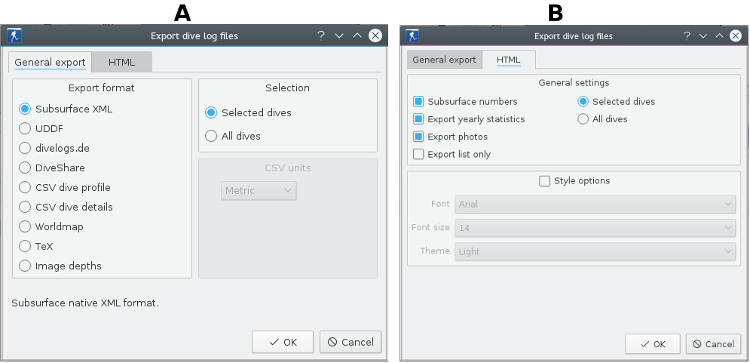
A dive log or part of it can be saved in several formats:
-
Subsurface XML format. This is the native format used by Subsurface.
-
Universal Dive Data Format (UDDF). Refer to http://uddf.org for more information. UDDF is a generic format that enables communication among many dive computers and computer programs.
-
Divelogs.de, an Internet-based dive log repository. In order to upload to Divelogs.de, you need a user-ID as well as a password for Divelogs.de. Log into http://en.divelogs.de and subscribe to this service to upload dive log data from Subsurface.
-
DiveShare is also a dive log repository on the Internet focusing on recreational dives. To upload dives, you need a user ID, so registration with http://scubadiveshare.com is required.
-
CSV dive details, that includes the most critical information of the dive profile. Included information of a dive is: dive number, date, time, buddy, duration, depth, temperature and pressure: in short, most of the information that recreational divers enter into handwritten log books.
-
CSV dive profile, that includes a large amount of detail for each dive, including the depth profile, temperature and pressure information of each dive.
-
HTML format, in which the dive(s) are stored in HTML files, readable with an Internet browser. Most modern web browsers are supported, but JavaScript must be enabled. The HTML export cannot be changed or edited. It contains most of the information recorded in the dive log. However, it does not show the calculated values in the Dive Profile panel, e.g. dive ceiling, calculated cylinder pressure, gas pressures and MOD. The HTML export contains a search option to search the dive log. HTML export is specified on the second tab of the Export dialog (image B above). A typical use of this option is to export all your dives to a smartphone or a tablet where it would serve as a portable record of dives, useful for dive companies wishing to verify the dive history of a diver, and doing away with the need to carry an original logbook when doing dives with dive companies.
-
Worldmap format, an HTML file with a world map upon which each dive and some information about it are indicated. This map is not editable. If you select any of the dive sites on the map, a summary of the dive is available in text, as shown in the image below.
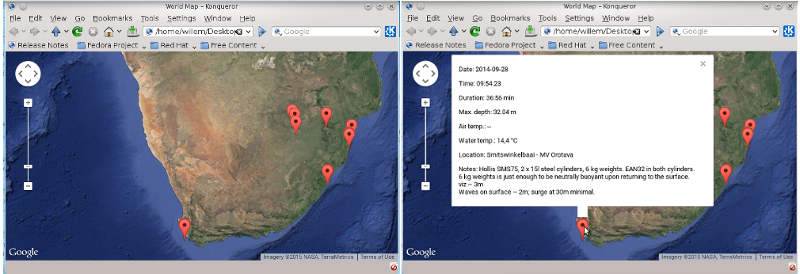
-
Image depths, which creates a text file that contains the file names of all photos or images attached to any of the selected dives in the Dive List, together with the depth underwater where of each of those photos was taken.
-
General Settings, under the HTML tab, provides the following options:
-
Subsurface Numbers: if this option is checked, the dive(s) are exported with the numbers associated with them in Subsurface, Otherwise the dive(s) will be numbered starting from 1.
-
Export Yearly Statistics: if this option is checked, a yearly statistics table will be attached to the HTML exports.
-
Export List only: a list of dives only (date, time, depth, duration) will be exported and the detailed dive information, e.g. dive profile, will not be available.
-
-
Under Style Options some style-related options are available like font size and theme.
Export to other formats can be done through third party facilities, for instance www.divelogs.de.
9. Keeping a Subsurface dive log in the Cloud
For each diver, dive log information is highly important. Not only is it a record of diving activities for your pleasure, but it’s important information required for admission to training courses or sometimes even diving sites. The security of the dive log is critical. To have a dive log that is resistant to failure of a home computer hard drive, loss or theft of equipment, the Cloud is an obvious solution. This also has the added benefit that you can access your dive log from anywhere in the world. For this reason, facilities such as divelogs.de and Diving Log offer to store dive log information on the Internet.
Subsurface includes access to a transparently integrated cloud storage back end that is available to all Subsurface users. Storing and retrieving a dive log from the cloud is no more difficult than accessing the dives on the local hard disk. The only requirement is that you should first register as a user on the cloud. To use Subsurface cloud storage , follow these steps:
9.1. Create a cloud storage account
-
Open the Network Preferences by selecting File → Preferences → Network.
-
In the section headed Subsurface cloud storage, enter an email address that Subsurface can use for user registration.
-
Enter a novel password that Subsurface will use to store the dive log in the cloud.
-
Click Apply to send the above email address and password to the (remote) cloud server. The server responds by sending a verification PIN to the above email address (This is the only occasion that Subsurface uses the email address provided above). The Network Preferences dialog now has a new PIN text box, not visible previously.
-
Enter the PIN in the corresponding text box in the Network Preferences dialog (this field is only visible while the server is waiting for email address confirmation)
-
Click Apply again. The Subsurface cloud storage account will be marked as verified and the Subsurface cloud storage service is initialised for use.
9.2. Using Subsurface cloud storage
-
Once the cloud storage has been initialized, two new items appear in the File menu of the main menu system: Open cloud storage and Save to cloud storage. These options let you load and save data to the Subsurface cloud storage server.
-
In the Defaults Preferences tab, you can select to use the Subsurface cloud storage data as the default data file by checking the box marked Cloud storage default file. This means the data from the Subsurface cloud storage is loaded when Subsurface starts and saved there when Subsurface closes.
-
Subsurface keeps a local copy of the data and the cloud facility remains fully functional even if used while disconnected to the Internet. Subsurface simply synchronizes the data with the cloud server the next time the program is used while the computer is connected to the Internet.
9.3. Web access to Subsurface cloud storage
One of the nice side benefits of using Subsurface cloud storage is that you can also access your dive data from any web browser. Simply open https://cloud.subsurface-divelog.org, log in with the same email and password, and you can see an HTML export of the last dive data that was synced to Subsurface cloud storage. The dive information shown is only the contents of the recorded dive logs, NOT the calculated values shown in the Profile panel, including some cylinder pressures, deco ceilings and O2/He/N2 partial pressures.
9.4. Other cloud services
If you prefer not to use the integrated cloud storage of dive logs (and don’t need the web access), it’s simple to store dive logs in the cloud using several of the existing facilities on the Internet. For instance Dropbox offers a free application that allows files on the Dropbox servers to be seen as a local folder on a desktop computer.

The Dropbox program creates a copy of the Dropbox Internet Cloud content on your desktop computer. When the computer is connected to the Internet, the Internet content is automatically updated. Therefore both the Open and Save of dive logs are done using the local copy of the dive log in the local Dropbox folder, so there’s no need for a direct internet connection. If the local copy is modified, e.g. by adding a dive, the remote copy in the Dropbox server in the Cloud will be automatically updated whenever Internet access is available.
In this way a dive log in your Dropbox folder can be accessed seamlessly from the Internet and can be accessed anywhere with Internet access. Currently there are no costs involved for this service. Dropbox (Windows, Mac and Linux) can be installed by accessing the Install Page on the Dropbox website Alternatively you can use Dropbox as a way back up your dive log. To Store a dive log on Dropbox, select File → Save as from the Subsurface main menu, navigate to the Dropbox folder and select the Save button. To access the dive log in Dropbox, select File → Open Logbook from the Subsurface main menu and navigate to the dive log file in the Dropbox folder and select the Open button.
Several paid services exist on the Internet (e.g. Google, Amazon) where the same process could be used for the Cloud-based storage of dive logs.
10. Printing a dive log
Subsurface provides a simple and flexible way to print a whole dive log or only a few selected dives. Pre-installed templates or a custom written template can be used to choose where the data are fitted into the page.
Some decisions need to be made before printing:
-
Should the whole dive log be printed or only part of it? If only part is required, select the required dives from the Dive List panel.
-
If the dive profiles are printed, what gas partial pressure information should be shown? Select the appropriate toggle-buttons on the button bar to the left of the Dive Profile panel.
If File → Print is selected from the Main menu, the dialogue below (image A) appears. Three specifications are needed to get the desired information and page layout:
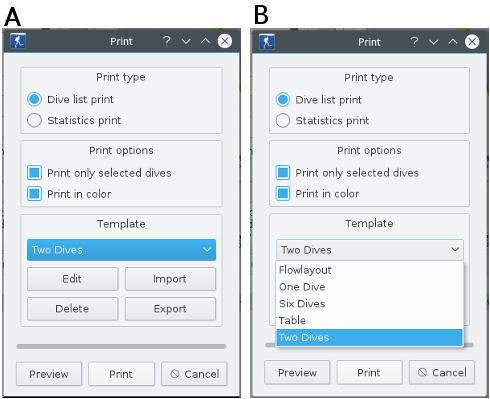
-
Under Print type select one of two options:
-
Dive list print: Print dives from the Dive List panel with profiles and other information.
-
Statistics print: Print yearly statistics of the dives.
-
-
Under Print options select:
-
Printing only the dives selected from the dive list before activating the print dialogue by checking the box Print only selected dives. If this check box is not checked ALL dives in the Dive List panel are printed.
-
Printing in color, done by checking the box with Print in color. If this check box is not checked, printing is in black and white.
-
Under Template select a template to be used as the page layout. There are several choices. (see image B, above).
-
Table: This prints a summary table of all dives selected (see below).

-
Flow layout: Print the text associated with each dive without printing the dive profiles of each dive (see below):
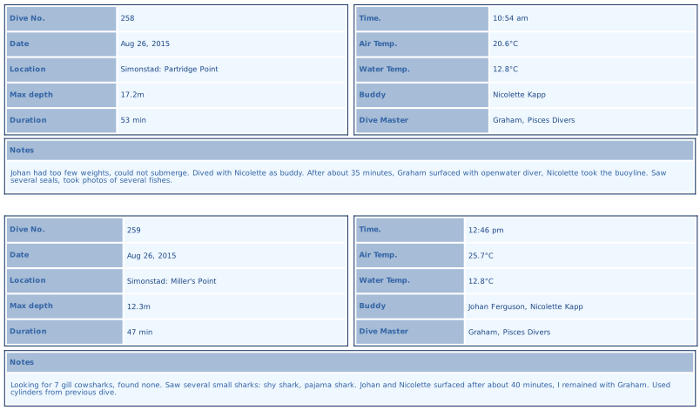
-
One Dive: Print one dive per page, also showing the dive profile (see below)
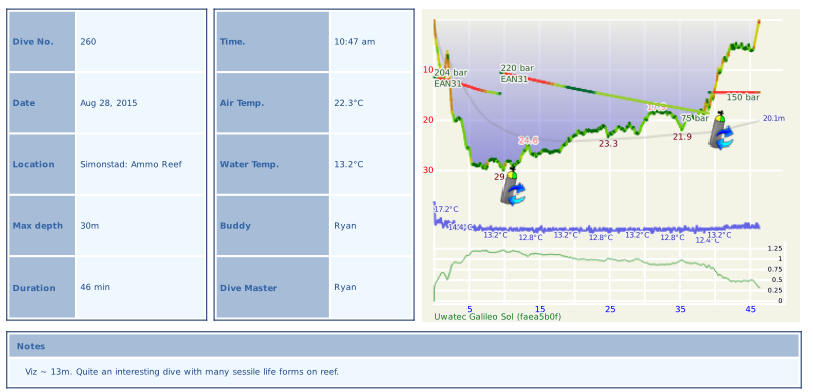
-
Two Dives: Print two dives per page, also showing the dive profiles.
-
Six Dives: Print six dives per page, also showing the dive profiles.
You can Preview the printed page by selecting the Preview button on the dialogue (see image A at the start of this section). After preview, you can change the options in the print dialogue, so the layout fits personal taste.
Next, select the Print button (see image A at the start of this section). This activates the regular print dialogue used by the operating system, letting you choose a printer and set its properties (see image below):
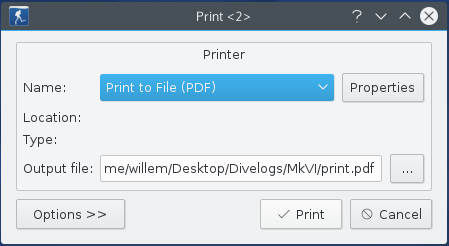
Set the print resolution of the printer to an appropriate value by changing the printer Properties. Finally, select the Print button to print the dives. Below is a (rather small) example of the output for one particular page.
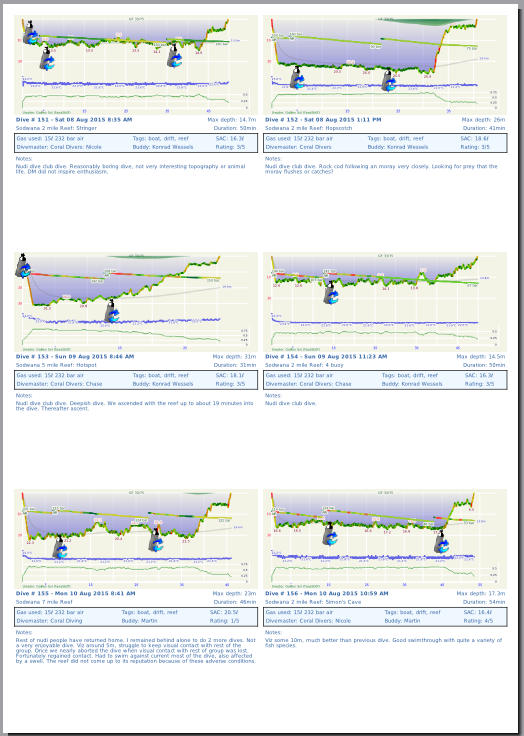
10.1. Créer un modèle d’impression personnalisé (avancé)
Writing a custom template is an effective way to produce highly customized printouts. Subsurface uses HTML templates to render printing. You can create a template, export a new template, import an existing template and delete an existing template by using the appropriate buttons under the Template dropdown list in the print dialogue. See APPENDIX E for information on how to write or modify a template.
11. Configurer un ordinateur de plongée
Subsurface vous permet de configurer un ordinateur de plongée. Actuellement, les familles d’ordinateurs supportés sont Heinrichs-Weikamp (OSTC 2, OSTC 3) et Suunto Vyper (Stinger, Mosquito, D3, Vyper, Vytec, Cobra, Gekko et Zoop). De nombreux paramètres de ces ordinateurs de plongée peuvent être lues et modifiées. Pour s’assurer que les pilotes pour votre ordinateur de plongée sont installés (également nécessaire pour télécharger les plongées) et que le nom de périphérique de l’ordinateur de plongée est connu. Voir ANNEXE A pour plus d’informations sur la manière de procéder.
Une fois que l’ordinateur de plongée est connecté à Subsurface, sélectionner Fichier → Configurer l’ordinateur de plongée, à partir du menu principal. Sélectionner le nom du périphérique (ou le point de montage) dans la liste déroulante, en haut du panneau de configuration et sélectionner le bon modèle d’ordinateur de plongée à partir du panneau à gauche (voir l’image ci-dessous).
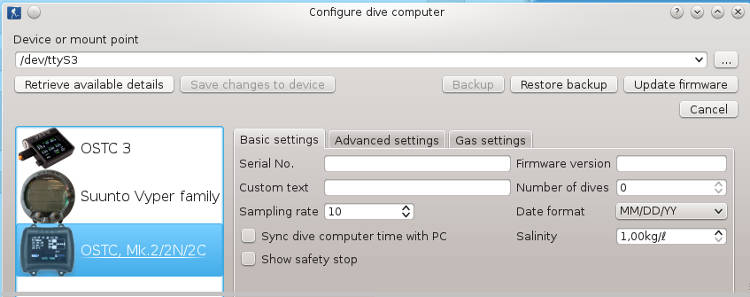
En utilisant les boutons appropriés du panneau de configuration, les actions suivantes peuvent être effectuées :
-
Récupérer les détails disponibles. Cela charge la configuration existante à partir de l’ordinateur de plongée dans Subsurface, en l’affichant dans le panneau de configuration.
-
Enregistrer les modifications sur le périphérique. Cela change la configuration de l’ordinateur de plongée pour correspondre aux informations affichées dans le panneau de configuration.
-
Sauvegarder. Cela enregistre la configuration dans un fichier. Subsurface demande l’emplacement et le nom du fichier pour enregistrer les informations.
-
Restaurer une sauvegarde. Cela charge les informations à partir d’un fichier de sauvegarde et l’affiche dans le panneau de configuration.
-
Mettre à jour le firmware. Si un nouveau firmware est disponible pour l’ordinateur de plongée, il sera chargé dans l’ordinateur de plongée.
12. Setting user Preferences for Subsurface
There are several user-definable settings within Subsurface, found by selecting File → Preferences, mostly affecting the way in which Subsurface shows dive information to the user. The settings are in six panels: Defaults, Units, Graph, Language, Network, and Georeference, all of which operate on the same principles: specified settings can be applied to the display of the dive log by selecting Apply. At this stage, any new settings only apply to the present session and are not saved. In order to apply new settings permanently, select the Save button. If you do not wish to apply the new preferences, select Cancel.
12.1. Defaults
There are several headings in the Defaults panel:
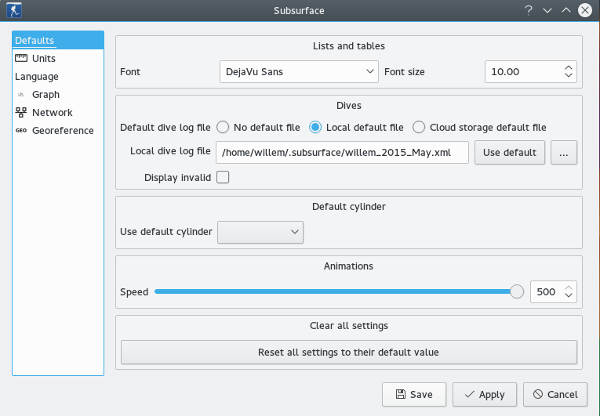
-
Lists and tables: Specify the font type and font size of the Dive Table panel: decreasing the font size allows one to see more dives on a screen.
-
Dives: For the Default Dive Log File specify the directory and file name of your electronic dive log book. This is a file with filename extension of either .xml or .ssrf. When launched, Subsurface will automatically load the specified dive log book. There are three options:
-
No default file: When checked, Subsurface does not automatically load a dive log at startup.
-
Local default file: When checked, Subsurface automatically loads a dive log from the local hard disk.
-
Cloud storage default file: When checked, Subsurface automatically loads the dive log from the cloud device that was initialized using the Preferences _Network tab (see below).
-
-
Display invalid: Dives can be marked as invalid (when a user wishes to hide dives that he/she doesn’t consider valid dives, e.g. pool dives, but still want to keep them in the dive log). This controls whether those dives are displayed in the dive list.
-
Default cylinder: From the dropdown list, select the default cylinder to be used in the Equipment tab of the Notes panel.
-
Animations: Some actions in showing the dive profile are performed using animations. For instance, the axis values for depth and time change from dive to dive. When viewing a different dive, these changes in axis characteristics do not happen instantaneously, but are animated. The Speed of animations can be controlled by setting this slider with faster animation speed to the left, and a 0 value representing no animation at all.
-
Clear all settings: As indicated in the button below this heading, all settings are cleared and set to default values.
12.2. Units
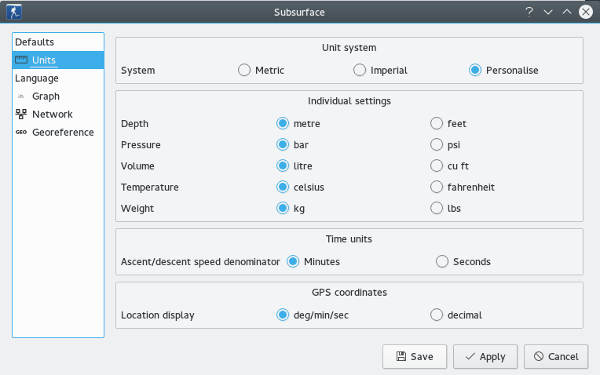
Choose between metric and imperial units of depth, pressure, volume, temperature and mass. By selecting the Metric or Imperial radio button at the top, you can specify that all units are in the chosen measurement system. Alternatively, if you select the Personalize radio button, units can be selected independently, with some in the metric system and others in imperial.
Regardless of the above settings, dive time measurements can be either in seconds or minutes. Choose the appropriate option. GPS coordinates can be represented either as traditional coordinates (degrees, minutes, seconds) or as decimal degrees Choose the appropriate option.
12.3. Graph
This panel has three sections:
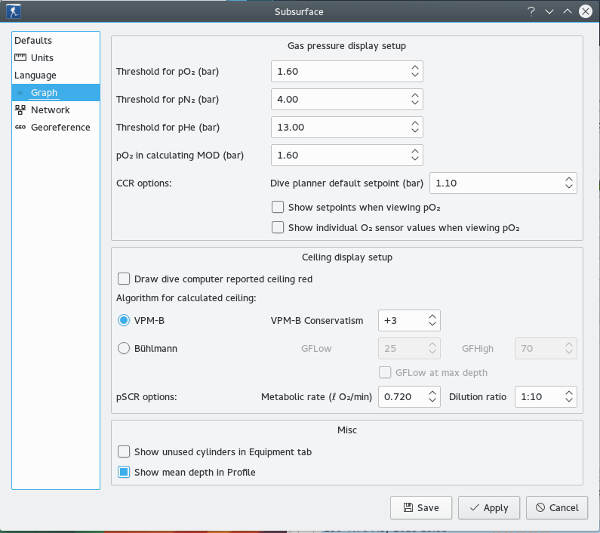
Gas pressure display setup. Even though nitrogen and helium pressures are also included here, these items mainly pertain to oxygen management: Thresholds: Subsurface can display graphs of the nitrogen, oxygen and the helium partial pressures during the dive, activated using the toolbar on the left of the Dive Profile panel. For each of these graphs, specify a threshold value. If any of the graphs go above the specified threshold, the graph is highlighted in red, indicating the particular partial pressure threshold has been exceeded. The pO2 threshold is probably the most important one and a value of 1.6 is commonly used. pO2 in calculating MOD is used for calculating the maximum operative depth for a particular nitrox or trimix gas mixture. A value of 1.4 is commonly used.
-
CCR Options: These options determine oxygen management for CCR dives:
-
Dive planner default setpoint: Specify the O2 setpoint for a CCR dive plan. This determines the pO2 maintained during a particular dive. Setpoint changes during the dive can be added via the profile context menu.
-
CCR: Show setpoints when viewing pO2: With this checkbox activated, the pO2 graph on the dive profile has an overlay in red which indicates the CCR setpoint values. See the section on Closed Circuit Rebreather dives.
-
CCR: Show individual O2 sensor values when viewing pO2: Show the pO2 values associated with each of the individual oxygen sensors of a CCR system. See the section on Closed Circuit Rebreather dives.
-
Ceiling display setup. These settings mostly deal with nitrogen and helium management by determining how the decompression ceiling (ascent ceiling) is calculated and displayed:
-
-
-
Draw dive computer reported ceiling red: This checkbox does exactly what it says. By default the computer reported ceiling is shown in white. Not all dive computers report ceiling values. If the dive computer does report it, it may differ from the ceilings calculated by Subsurface because of the different algorithms and gradient factors, as well as the dynamic way a dive computer calculates ceilings during a dive.
-
Algorithm for calculating ceiling. Choose between the Bühlmann Z1H-L16 decompression model and the VPM-B model:
-
VPM-B: Provide a conservatism level for calculating the VPM-B ceiling. Values between 0 (least conservative) and 4 (most conservative) are valid.
-
Bühlmann: Set the gradient factors (GFlow and GFHigh) for calculcating the deco ceiling following the ZH-L16 algorithm. GF_Low is the gradient factor at depth and GF_High is used at the surface. At intermediate depths gradient factors between GF_Low and GF_High are used. Gradient factors add conservatism to nitrogen and helium exposure during a dive, in a similar way that many dive computers have a conservatism setting. The lower the value of a gradient factor, the more conservative the calculations are with respect to inert gas loading and the deeper the ceilings are. Gradient factors of 20/60 are considered conservative and values of 70/90 are considered harsh. In addition decide whether to check the GFLow at max depth box. If checked, GF_Low is used for the deepest dive depth and linearly increased up to the GF_High value at the surface. If unchecked, GF_Low is used between the deepest dive depth and the first deco stop, after which the gradient factor linearly increases up to the GF_High value at the surface. For more information see:
-
Understanding M-values by Erik Baker, Immersed Vol. 3, No. 3.
-
-
pSCR options. These preferences determine how passive semi-closed circuit (pSCR) dives are planned and how the pSCR deco ceiling is calculated:
-
Metabolic rate: this is the volume of oxygen used by a diver during a minute. Set this value for pSCR dive planning and decompression calculations.
-
pSCR ratio: The dilution ratio (or dump ratio) is the ratio of gas released to the environment to that of the gas recirculated to the diver. A 1:10 ratio is commonly used.
-
Misc
-
-
-
Show unused cylinders in Equipment Tab: This checkbox allows display of information about unused cylinders when viewing the Equipment Tab. If this box is not checked, and if any cylinders entered using the Equipment Tab are not used (e.g. there was no gas switch to such a cylinder), then these cylinders are omitted from that list.
-
Show mean depth: If this box is checked, the Dive Profile panel contains a grey line that shows the mean depth of the dive, up to any time instant during the dive. Normally this is a u-shaped line indicating the deepest mean depth just before ascent.
12.4. Language
Choose a language that Subsurface will use.
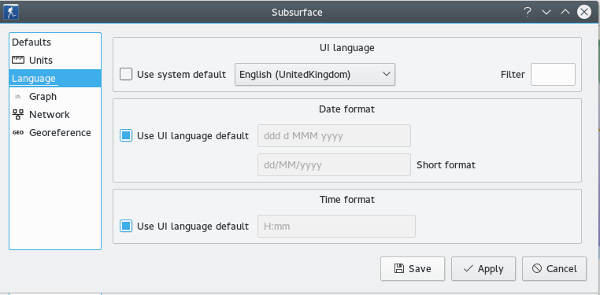
Check the System Default language i.e. the language of the underlying operating system if this is appropriate. This is the default setting in Subsurface. To change it, uncheck this checkbox and pick a language / country combination from the list of locations. The Filter text box to list similar languages. For instance there are several system variants of English or French. This particular preference requires a restart of Subsurface to take effect.
In this section also specify appropriate date an time formats for showing dive details.
12.5. Network
This panel facilitates communication between Subsurface and data sources on the Internet. This is important, for instance, when Subsurface needs to communicate with web services such as Cloud storage or the Subsurface Companion app. These Internet requirements are determined by your type of connection to the Internet and by the Internet Service Provider (ISP) used. Your ISP should provide the appropriate information.
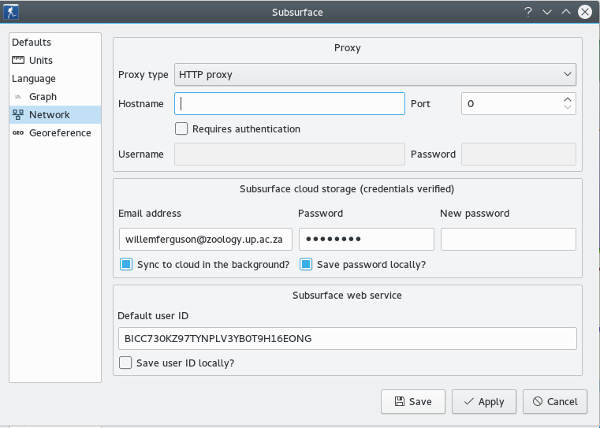
This dialogue has three sections:
-
Proxy type: If a proxy server is used for Internet access, the type of proxy needs to be selected from the dropdown list, after which the IP address of the host and the appropriate port number should be provided. If the proxy server uses authentication, the appropriate userID and password are required so that Subsurface can automatically pass through the proxy server to access the Internet. This information is usually obtained from your ISP.
-
Subsurface cloud storage: To store your dive log in the cloud, a valid email address and password are required. This lets Subsurface email security information regarding cloud storage to you, and to set up cloud storage appropriately. Two additional options are given:
-
Sync to cloud in the background: This option allows saving of dive information to the cloud storage while you do other things within Subsurface.
-
Save password locally: This allows local storage of the cloud storage password. Note that this information is saved in raw text form, not encoded in any way.
-
-
Subsurface web service: When you subscribe to the Subsurface web service, a very long and hard-to-remember userID is issued. This is the place to save that userID. By checking the option Save User ID locally?, you ensure a local copy of that userID is saved.
12.6. Georeference
Subsurface provides a geo-lookup service (that is, given the coordinates of a dive site) derived from a click on the Dive Map panel at the bottom right of the Subsurface window, or from a GPS instrument or from the Subsurface Companion app). A search on the Internet is done to find the name of the closest known location. This function only works if Subsurface has an Internet connection. The preference of the dive site name can be configured, e.g. Country/State/City or City/State/Country (see image below).

13. The Subsurface dive planner
Dive planning is an advanced feature of Subsurface, accessed by selecting Log → Plan Dive from the main menu. It allows calculation of inert gas load during a dive by using the Bühlmann ZH-L16 algorithm with the addition of gradient factors as implemented by Erik Baker.
13.1. The Subsurface dive planner screen
Like the Subsurface dive log, the planner screen is divided into several sections (see image below). The setup parameters for a dive are entered into the sections on the left hand side of the screen. They are: Available Gases, Rates, Planning, Gas Options and Notes.
At the top right hand is a green design panel on which the profile of the dive can be manipulated directly by dragging and clicking as explained below. This feature makes the Subsurface dive planner unique in ease of use.
At the bottom right is a text panel with a heading of Dive Plan Details. This is where the details of the dive plan are provided in a way that can easily be copied to other software. This is also where any warning messages about the dive plan are printed.
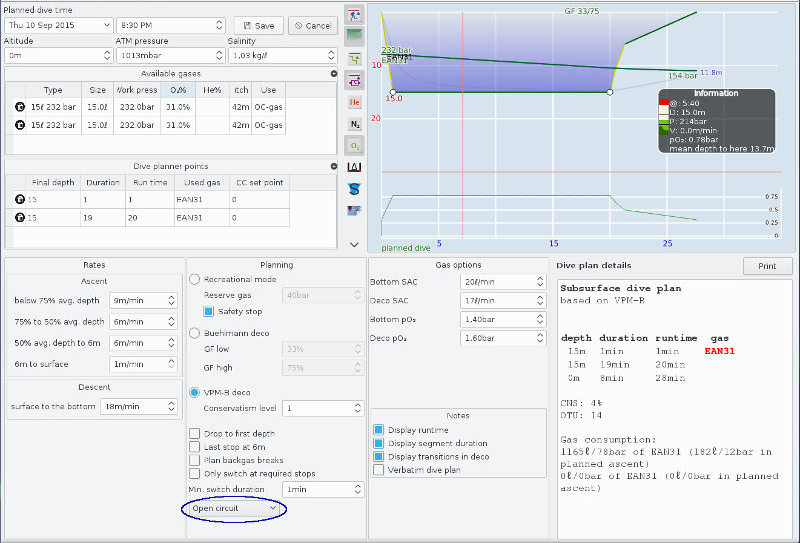
13.2. Open circuit dives
-
Towards the center bottom of the planner (circled in blue in the image above) is a dropbox with three options. Select the appropriate one of these:
-
Open Circuit (the default)
-
CCR
-
pSCR
-
-
Choose the Open Circuit option.
-
In the top left-hand area of the planning screen, be sure the constant dive parameters are appropriate. These are: Start date and time of the intended dive, Atmospheric Pressure and Altitude above sea level of the dive site. The atmospheric pressure can also be entered as an altitude in meters, assuming a sea-level atmospheric pressure of 1.013 bar.
-
In the table labelled Available Gases, add the information of the cylinders to be used as well as the gas composition within that cylinder. This is done in a similar way as for providing cylinder data for dive logs. Choose the cylinder type by double clicking the cylinder type and using the dropdown list, then specify the work pressure of this cylinder. By leaving the oxygen concentration (O2%) field empty, the cylinder is assumed to contain air. Otherwise enter the oxygen and/or helium concentration in the boxes provided in this dialogue. Add additional cylinders by using the "+" icon to the top right-hand of the dialogue.
-
The Available Gases table includes three gas depth fields, labelled:
-
Deco switch at: the switch depth for deco gases. Unless overridden by the user, this will be automatically calculated based on the Deco pO₂ preference (default 1.6 bar)
-
Bot. MOD: the gas Maximum Operating Depth (MOD) if it is used as a bottom mix. Automatically calculated based on the Bottom pO₂ preference (default 1.4 bar). Editing this field will modify the O₂% according to the depth set. Set to '*' to calculate the best O₂% for the dive maximum depth.
-
MND: the gas Maximum Narcotic Depth (MND). Automatically calculated based on the Best Mix END preference (default 30m / 98 ft). Editing this field will modify the He% according to the depth set. Set to '*' to calculate the best He% for the dive maximum depth.
-
-
The profile of the planned dive can be created in two ways:
-
Drag the waypoints (the small white circles) on the existing dive profile to represent the dive. Additional waypoints can be created by double-clicking the existing dive profile. Waypoints can be deleted by right-clicking a particular waypoint and selecting the delete item from the resulting context menu.
-
The most efficient way to create a dive profile is to enter the appropriate values into the table marked Dive planner points. The first line of the table represents the duration and the final depth of the descent from the surface. Subsequent segments describe the bottom phase of the dive. The CC set point column is only relevant for closed circuit divers. The ascent is usually not specified because this is what the planner is supposed to calculate. Add additional segments to the profile by selecting the "+" icon at the top right hand of the table. Segments entered into the Dive planner points table automatically appear in the Dive Profile diagram.
-
13.2.1. Recreational dives
Recreational mode is what comes closest to planning a dive based on the non-decompression limit (NDL). It computes the maximum time a diver can stay at the current depth without needing mandatory decompression stops and without using more than the existing gas (minus a reserve). The planner automatically takes into account the nitrogen load incurred in previous dives. But conventional dive tables are also used in a way that can take into account previous dives. Why use a dive planner for recreational dives? Using recreational dive tables, the maximum depth of a dive is taken into account. But few dives are done at a constant depth corresponding to the maximum depth (i.e. a "square" dive profile). This means dive tables overestimate the nitrogen load incurred during previous dives. The Subsurface dive planner calculates nitrogen load according to the real dive profiles of all uploaded previous dives, in a similar way as dive computers calculate nitrogen load during a dive. This means that the diver gets credit, in terms of nitrogen load, for not remaining at maximum depth during previous dives, so a longer subsequent dive can be planned. For the planner to work it’s crucial to upload all previous dives onto Subsurface before doing dive planning. To plan a dive, the appropriate settings need to be defined.
Ensure the date and time is set to that of the intended dive. This allows calculation of the nitrogen load incurred during previous dives.
-
Immediately under the heading Planning are two checkboxes Recreational and Safety Stop. Check these two boxes.
-
Then define the cylinder size, the gas mixture (air or % oxygen) and the starting cylinder pressure in the top left-hand section of the planner under Available gases.
-
The planner calculates whether the specified cylinder contains enough air/gas to complete the planned dive. In order for this to be accurate, under Gas options, specify an appropriate surface air consumption (SAC) rate for Bottom SAC. Suitable values are between 15 l/min and 30 l/min, with novice divers or difficult dives requiring SAC rates closer to 30l/min.
-
Define the amount of gas the cylinder must have at the end of the bottom section of the dive just before ascent. A value of 50 bar is often used. The reason for this reserve gas is to provide for the possible need to bring a buddy to the surface using gas sharing. How much gas is used in sharing depends on the depth of the ascent. This can be difficult to estimate, so most agencies assume a fixed amount of gas, or actually of pressure e.g. 40 or 50 bar or 25% or 33% (rule of thirds). But Subsurface can do better because it knows about the ascent and that is why we add the amount of gas during the ascent (i.e. the "deco gas“). Subsurface still uses a fixed pressure "reserve" but that’s supposed to be for the additional gas used when there’s a problem and your pulse rate goes up when you start to buddy breathe. This reserve amount is user configurable.
-
Define the depth of the dive by dragging the waypoints (white dots) on the dive profile or (even better) defining the appropriate depths using the table under Dive planner points as desribed under the previous heading. If this is a multilevel dive, set the appropriate dive depths to represent the dive plan by adding waypoints to the dive profile or by adding appropriate dive planner points to the Dive Planner Points table. Subsurface will automatically extend the bottom section of the dive to the maximum duration within the no-decompression limits (NDL).
-
The ascent speed can be changed. The default ascent speeds are those considered safe for recreational divers.
The dive profile in the planner shows the maximum dive time within no-deco limits using the Bühlmann ZH-L16 algorithm and the gas and depth settings specified as described above. The Subsurface planner allows rapid assessment of dive duration as a function of dive depth, given the nitrogen load incurred during previous dives. The dive plan includes estimates of the amount of air/gas used, depending on the cylinder settings specified under Available gases. If the initial cylinder pressure is set to 0, the dive duration shown is the true no-deco limit (NDL) without taking into account gas used during the dive. If the surface above the dive profile is RED it means that recreational dive limits are exceeded and either the dive duration or the dive depth needs to be reduced.
Below is an image of a dive plan for a recreational dive at 30 meters. Although the no-deco limit (NDL) is 23 minutes, the duration of the dive is limited by the amount of air in the cylinder. That is shown in the text box at the bottom right of the panel, requiring sufficient air for buddy-sharing during ascent.
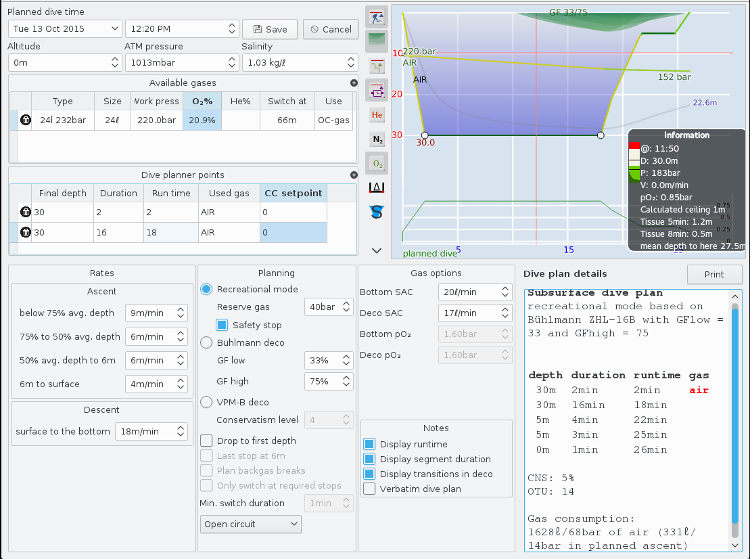
13.2.2. Non-recreational open circuit dives, including decompression
Non-recreational dive planning involves exceeding the no-deco limits and/or using multiple breathing gases. These dives are planned in three stages:
a) Nitrogen management: This is done by specifying the rates for descent and ascent, as well as the deco model (GFLow, GFHigh or Conservatism level) under the headings Rates and Planning to the bottom left of the planning screen. Two deco models are supported the Bühlmann model and the VPM-B model. Select one of the two models. When selecting the Bühlmann model, the gradient factors (GFhigh and GFlow need to be specified. Initially, the GFHigh and GFLow values in the Preferences panel of Subsurface is used. If these are changed within the planner (see Gas Options within the planner), the new values are used without changing the original values in the Preferences. Gradient Factor settings strongly affect the calculated ceilings and their depths. A very low GFLow value brings on decompression stops early during the dive. ** For more information about Gradient factors, see the section on Gradient Factor Preference settings.
If the VPM-B model is selected, the Conservatism_level needs to be specified on a scale of 0 (least conservative) to 4 (most conservative). This model tends to give deco stops at deeper levels than the Bühlmann model and often results in slightly shorter dive durations than the Bühlmann model, albeit at the cost of higher tissue compartment pressures in the slow tissues. When selecting one of these models, keep in mind they are NOT exact physiological models but only mathematical models that appear to work in practice.
For more information external to this manual see:
-
Understanding M-values by Erik Baker, Immersed Vol. 3, No. 3.
-
Gradient factors for dummies, by Kevin Watts Deco for Divers, by Mark Powell (2008). Aquapress Southend-on-Sea, UK. ISBN 10: 1-905492-07-3. Un excellent livre non technique qui traite à la fois des modèles de décompression Bühlmann et VPM-B.
The ascent rate is critical for nitrogen off-gassing at the end of the dive and is specified for several depth ranges, using the mean depth as a yardstick. The mean depth of the dive plan is shown by a light grey line on the dive profile. Ascent rates at deeper levels are often in the range of 8-12 m/min, while ascent rates near the surface are often in the range of 4-9 m/min. The descent rate is also specified. If the option Drop to first depth is activated, the descent phase of the planned dive will be at the maximal descent rate specified in the Rates section of the dive setup.
b) Oxygen management: In the Gas Options part of the dive specification, the maximum partial pressure for oxygen needs to be specified for the bottom part of the dive (bottom po2) as well as for the decompression part of the dive (deco po2). Commonly used values are 1.4 bar for the bottom part of the dive and 1.6 bar for any decompression stages. Normally, a partial pressure of 1.6 bar is not exceeded. PO2 settings and the depth at which switching to a gas takes place can also be edited in the Available Gases dialog. Normally the planner decides on switching to a new gas when, during ascent, the partial pressure of the new gas has decreased to 1.6 bar.
c) Gas management: With open-circuit dives this is a primary consideration. Divers need to keep within the limits of the amount of gas within the dive cylinder(s), allowing for an appropriate margin for a safe return to the surface, possibly sharing with a buddy. Under the Gas Options heading, specify the best (but conservative) estimate of your surface-equivalent air consumption (SAC, also termed RMV) in liters/min (for the time being, only SI units are supported). Specify the SAC during the bottom part of the dive (bottom SAC) as well as during the decompression or safety stops of the dive (deco SAC). Values of 15-30 l/min are common. For good gas management, a guess is not sufficient and you needs to monitor gas consumption on a regular basis, dependent on different dive conditions and/or equipment. The planner calculates the total volume of gas used during the dive and issues a warning if you exceeds the total amount of gas available. Good practice demands that divers not dive to the limit of the gas supply but that an appropriate reserve is kept for unforeseen circumstances. For technical diving, this reserve can be up to 66% of the total available gas.
Now you can start the detailed time-depth planning of the dive. Subsurface offers an unique graphical interface for doing planning. The mechanics are similar to hand-entering a dive profile in the dive log part of Subsurface. Upon activating the planner, a default dive of depth 15 m for 20 min is offered in the blue design surface to the top right hand of the screen. The white dots (waypoints) on the profile can be dragged with a mouse. Create more waypoints by double-clicking on the profile line and ensuring the profile reflects the intended dive. Drag the waypoints to represent the depth and duration of the dive. It is NOT necessary to specify the ascent part of the dive since the planner calculates this, based on the existing settings. If any of the management limits (for nitrogen, oxygen or gas) are exceeded, the surface above the dive profile changes from BLUE to RED.
Each waypoint on the dive profile creates a Dive Planner Point in the table on the left of the dive planner panel. Ensure the Used Gas value in each row of that table corresponds to one of the gas mixtures specified in the Available Gases table. Add new waypoints until the main features of the dive have been completed, e.g. the bottom time segment and deep stops (if these are implemented). Leave the remaining waypoints on the ascent to Subsurface. In most cases Subsurface computes additional way points in order to fulfill decompression requirements for that dive. A waypoint can be moved by selecting it and by using the arrow keys. The waypoints listed in the Dive Planner Points dialogue can be edited by hand in order to get a precise presentation of the dive plan. In fact, it is sometimes more easy to create the whole dive profile by editing the Dive Planner Points dialog.
Show any changes in gas cylinder used by indicating gas changes as explained in the section hand-creating a dive profile. These changes should reflect the cylinders and gas compositions defined in the table with Available Gases. If two or more gases are used, automatic gas switches will be suggested during the ascent to the surface. These changes can be deleted by right-clicking the gas change and manually creating a gas change by right-clicking on the appropriate waypoint.
A non-zero value in the "CC set point" column of the table of dive planner points indicates a valid setpoint for oxygen partial pressure and that the segment is dived using a closed circuit rebreather (CCR). If the last manually entered segment is a CCR segment, the decompression phase is computed assuming the diver uses a CCR with the specified set-point. If the last segment (however short) is on open circuit (OC, indicated by a zero set-point) the decompression is computed in OC mode and the planner only considers gas changes in OC mode.
Below is an example of a dive plan to 45m using EAN26, followed by an ascent using EAN50 and using the settings as described above.
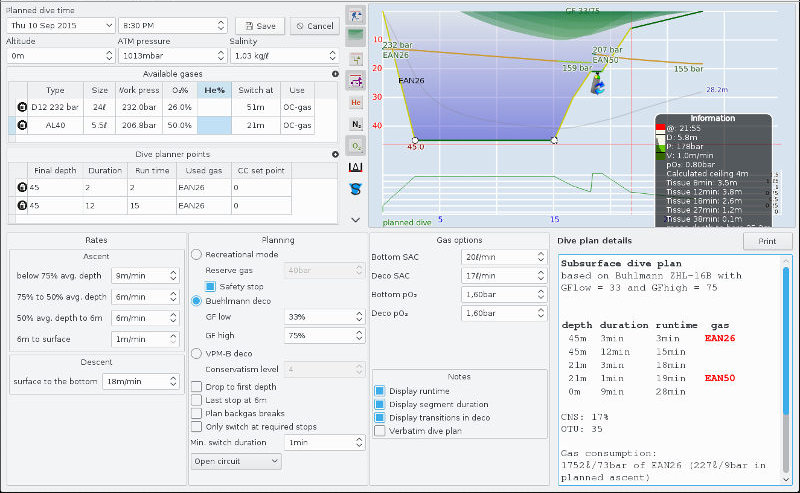
Once the above steps have been completed, save by clicking the Save button towards the top middle of the planner. The saved dive plan will appear in the Dive List panel of Subsurface.
The dive plan details
On the bottom right of the dive planner, under Dive Plan Details, the exact details of the dive plan are provided. These details may be modified by checking any of the options under the Notes section of the dive planner, immediately to the left of the Dive Plan Details. If a Verbatim dive plan is requested, a detailed sentence-level explanation of the dive plan is given. If any of the management specifications have been exceeded during the planning, a warning message is printed underneath the dive plan information.
If the option Display segment duration is checked, then the duration of each depth level is indicated in the Dive Plan Details. This duration INCLUDES the transition time to get to that level. However, if the Display transition in deco option is checked, the transitions are shown separately from the segment durations at a particular level.
13.3. Planning pSCR dives
To plan a dive using a passive semi-closed rebreather (pSCR), select pSCR rather than Open circuit in the dropdown list. The parameters of the pSCR dive can be set by selecting File → Preferences → Graph from the main menu, where the gas consumption calculation takes into account the pSCR dump ratio (default 1:10) as well as the metabolic rate. The calculation also takes the oxygen drop accross the mouthpiece of the rebreather into account. If the pO2 drops below what is considered safe, a warning appears in the Dive plan details. A typical pSCR configuration is with a single cylinder and one or more bail-out cylinders. Therefore the setup of the Available gases and the Dive planner points tables are very similar to that of a CCR dive plan, described below. However, no oxygen setpoints are specified for pSCR dives. Below is a dive plan for a pSCR dive. The dive is comparable to that of the CCR dive below, but note the longer ascent duration due to the lower oxygen in the loop due to the oxygen drop across the mouthpiece of the pSCR equipment.
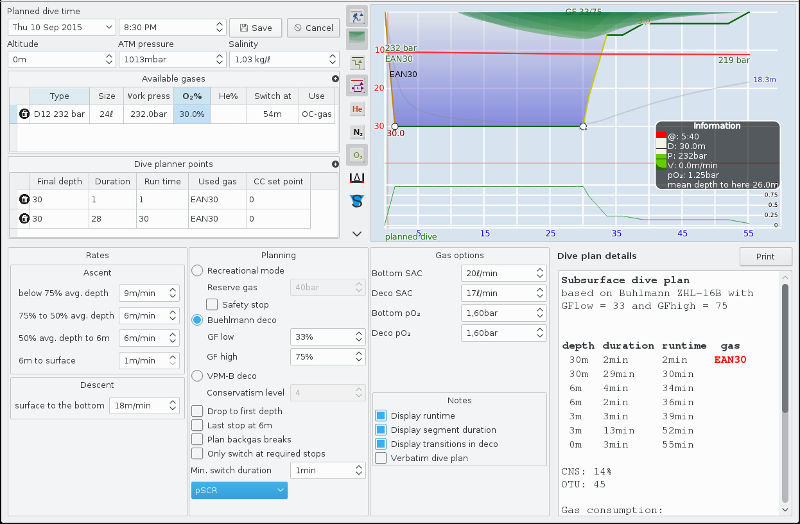
13.4. Planning CCR dives
To plan a dive using a closed circuit rebreather, select the CCR option in the dropdown list, circled in blue in the image below.
Available gases: In the Available gases table, enter the cylinder information for the diluent cylinder and for any bail-out cylinders. Do NOT enter the information for the oxygen cylinder since it is implied when the CCR dropdown selection is made.
Entering setpoints: Specify a default setpoint in the Preferences tab, by selecting File → Preferences → Graph from the main menu. All user-entered segments in the Dive planner points table use the default setpoint value. Then, different setpoints can be specified for dive segments in the Dive planner points table. A zero setpoint means the diver bails out to open circuit mode for that segment. Decompression is always calculated using the setpoint of the last manually entered segment. So, to plan a bail out ascent for a CCR dive, add a one-minute dive segment to the end with a setpoint value of 0. The decompression algorithm does not switch deco-gases automatically while in CCR mode (i.e. when a positive setpoint is specified) but this is calculated for bail out ascents.
The dive profile for a CCR dive may look something like the image below.
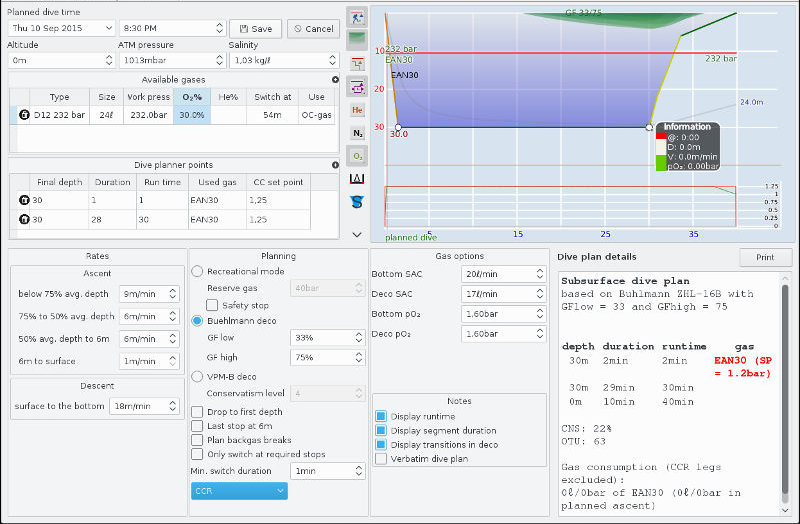
Note that, in the Dive plan details, the gas consumption for a CCR segment is not calculated, so gas consumptions of 0 liters are the norm.
13.5. Modifying an existing dive plan
Normally, when a dive plan has been saved, it is accessible from the Dive List, like any other dive log. Within the Dive List there is no way to change a saved dive plan. To change a dive plan, select it on the Dive List. Then, in the main menu, select Log → Re-plan dive. This will open the selected dive plan within the dive planner, allowing changes to be made and saved as usual.
In addition, there is the option "Save new". This keeps the original planned dive and adds a (possibly modified, - earlier dives are now taken into account -) copy to the dive list. If that copy is saved with the same start time as the original, the two dives are considered two versions of the same dive and do not influence other each during decompression calculation (see next section).
13.6. Planning for repetitive dives
Repetitive dives can easily be planned if the dates and start times of the repetitive dive set are specified appropriately in the top left-hand Start Time field. Subsurface calculates the gas loading figures and the affect of the first dive is evaluated on later dives.
If you have just completed a long/deep dive and are planning another dive, then highlight, in the Dive List, the dive that has just been logged then activate the planner. Depending on the start time of the planned dive, the planner takes into account the gas loading during the completed dive and plans accordingly.
If only a few standard configurations are used (e.g. in GUE), then a template dive can be created conforming to one of the configurations. If you want to plan a dive using this configuration, highlight the template dive in the Dive List and activate the planner: the planner takes into account the configuration in the highlighted dive.
13.7. Printing the dive plan
Selecting the Print button in the planner allows printing of the Dive Plan Details for wet notes. You can also cut and paste the Dive Plan Details to include in a text file or word processing document.
Dive plans have many characteristics in common with dive logs (dive profile, dive notes, etc). After a dive plan has been saved, the dive details and gas calculations are saved in the Notes tab. While a dive plan is being designed, it can be printed using the Print button in the dive planner. This prints the dive details and gas calculations in the Dive Plan Details panel of the dive planner. However, after the plan has been saved, it is represented in a way very similar to a dive log and the gas calculations cannot be accessed in the same way as during the planning process. The only way to print the dive plan is to use the File → Print function on the main menu in the same way as for dive logs or by copy and paste to a word processor.
14. Description des éléments du menu principal de Subsurface
Cette section décrit les fonctions et les opérations des éléments du menu principal de Subsurface. Plusieurs éléments ci-dessous sont des liens vers des sections de ce manuel traitant des opérations relatives.
14.1. Fichier
-
Nouveau carnet de plongée - Fermer le carnet de plongée actuellement ouvert et supprime toutes les informations de plongées.
-
Ouvrir un carnet de plongée - Ouvre une fenêtre pour sélectionner le carnet de plongée à ouvrir.
-
Sauvegarder - Enregistrer le carnet de plongée actuellement ouvert.
-
Enregsitrer sous - Enregistrer le carnet actuel sous un nom différent.
-
Open cloud storage - Open the dive log previously saved in Cloud storage.
-
Save to cloud storage - Save the current dive log to Cloud storage.
-
Take cloud storage online -
-
Fermer - Fermer le carnet de plongée actuellement ouvert.
-
Exporter - Exporter le carnet de plongée actuellement ouvert (ou les plongées sélectionnées dans le carnet) vers un des nombreux formats.
-
Imprimer - Imprimer le carnet de plongée actuellement ouvert.
-
Préférences - Définir les préférences de Subsurface.
-
Find moved images - If photos taken during dives have been moved to a different disk or directory, locate them and link them to the appropriate dives.
-
Configurer l’ordinateur de plongée - Modifier la configuration d’un ordinateur de plongée.
-
Quitter - Quitter Subsurface.
14.2. Edit
-
The Edit option allows one to undo or redo an action, e.g. deleting dives.
14.3. Importer
-
Importer depuis un l’ordinateur de plongée - Importer des informations de plongées à partir de l’ordinateur de plongée.
-
Importer des fichiers de log - Importer des informations de plongées à partir d’un fichier d’un format compatible avec Subsurface.
-
Importer les données GPS depis le service web Subsurface - Charge les coordonnées GPS à partir de l’application mobile Subsurface (téléphones et tablettes).
-
Importer depuis Divelogs.de - Importer des informations de plongées à partir de www.Divelogs.de.
14.4. Journal (log)
-
Ajouter une plongée - Ajouter manuellement une nouvelle plongée au panneau de la liste des plongées.
-
Edit dive - Edit a dive where the profile was entered by hand and not from a dive computer.
-
Planifier une plongée - Planifier des plongées.
-
Modifier la plongée dans le planificateur - Modifier une plongée planifiée qui a été enregistrée dans la liste des plongées.
-
Copier les composants de la plongée - Copier les informations de plusieurs champs d’un journal de plongée vers le presse-papier.
-
Coller les composants de la plongée - Colle, dans les plongées sélectionnées dans la liste des plongées, les informations copiées au préalable avec l’option Copier les composants de la plongée.
-
Renuméroter - Renuméroter les plongées sélectionnées dans le panneau de la liste des plongées.
-
Grouper automatiquement - Grouper les plongées du panneau de liste des plongées dans des voyages de plongées.
-
Editer les noms des ordinateurs de plongée - Modifier les noms des ordinateurs de plongée pour coordonner vos journaux (logs).
-
Filtrer la liste des plongées - Sélectionner seulement certaines plongées, à partir de tags ou de critères de plongées.
14.5. Vue
-
Tout - Affiche les quatre panneaux principaux de Subsurface simultanément.
-
Liste des plongées - Affiche uniquement le panneau de la liste des plongées.
-
Profil - Affiche uniquement le panneau du profil de la plongée.
-
Info - Affiche uniquement le panneau des notes.
-
Globe - Affiche uniquement le panneau de la carte mondiale.
-
Statistiques annuelles - Affiche par année le résumé des statistiques des plongées effectuées.
-
Prev DC - Switch to data from previous dive computer, if a single dive was logged from more than one.
-
Ordinateur suivant - Passer à l’ordinateur de plongée suivant.
-
Plein écran - Passer en mode plein écran.
14.6. Share on
-
Facebook - Partager la plongée sélectionnée sur votre Facebook.
14.7. Aide
-
À propos de Subsurface - Affiche un panneau avec le numéro de version de Subsurface ainsi que les informations de licence.
-
Vérifier les mises à jour - Vérifier si une nouvelle version de Subsurface est disponible sur le site web de Subsurface .
-
Sondge utilisateur - Aider à rendre Subsurface encore meilleur en répondant à notre sondage utilisateur ou en répondant à un autre sondage, si vos habitudes de plongées ont changées.
-
Manuel utilisateur - Ouvre une fenêtre affichant ce manuel utilisateur.
15. ANNEXE A : informations spécifiques au système d’exploitation utilisé pour importer les informations de plongées depuis un ordinateur de plongée.
15.1. Assurez-vous que les pilotes (drivers) nécessaires sont installés
|
|
Le système d’exploitation de l’ordinateur nécessite les bons pilotes pour communiquer avec l’ordinateur de plongée de la façon utilisée par l’ordinateur de plongée (Bluetooth, USB, infra-rouge). |
-
Sous Linux, les utilisateurs doivent avoir le bon module noyau de chargé. La plupart des distributions Linux le font automatiquement, de telle sorte que l’utilisateur n’ait rien à faire de particulier. Cependant, certains protocoles de communication nécessitent des pilotes additionnels, plus particulièrement pour certaines technologies telles que l’infra-rouge.
-
Sous Windows, le bon pilote devrait être téléchargé automatiquement la première fois que l’utilisateur branche son ordinateur de plongée sur le port USB de son ordinateur de bureau.
Sous Mac, les utilisateurs peuvent parfois avoir besoin d’installer manuellement le bon pilote. Par exemple, pour le Mares Puck ou n’importe quel autre ordinateur de plongée utilisant une interface USB-série basé sur le composant Silicon Labs CP2101 ou similaire, le bon pilote est disponible sous Mac_OSX_VCP_Driver.zip sur le dépôt de documents et logiciels Silicon Labs.
15.2. Comment trouver le nom du périphérique branché sur USB et paramétrer les permissions en écriture
|
|
Lors de la connexion d’un ordinateur de plongée en utilisant l’USB, Subsurface proposera généralement soit une liste déroulante avec le bon nom (ou le point de montage pour un Uemis Zurich) ou la liste sera désactivée si aucun nom de périphérique n’est nécessaire. Dans les rares cas où cela ne fonctionnerait pas, voici quelques méthodes pour trouver le nom de votre périphérique ; |
Essayez simplement COM1, COM2, etc. La liste déroulante devrait contenir tous les périphériques COM connectés.
La liste déroulante devrait contenir tous les ordinateurs de plongée connectés.
Il existe un moyen sûr de trouver le port :
-
Déconnecter le cable USB de l’ordinateur de plongée
-
Ouvrir un terminal
-
Taper la commande dmesg et appuyer sur la touche Entrer
-
Connecter le cable USB de l’ordinateur de plongée
-
Taper la commande dmesg et appuyer sur la touche Entrer
Un message similaire à celui-ci devrait apparaitre :
usb 2-1.1: new full speed USB device number 14 using ehci_hcd
usbcore: registered new interface driver usbserial
USB Serial support registered for generic
usbcore: registered new interface driver usbserial_generic
usbserial: USB Serial Driver core
USB Serial support registered for FTDI USB Serial Device
ftdi_sio 2-1.1:1.0: FTDI USB Serial Device converter detected
usb 2-1.1: Detected FT232BM
usb 2-1.1: Number of endpoints 2
usb 2-1.1: Endpoint 1 MaxPacketSize 64
usb 2-1.1: Endpoint 2 MaxPacketSize 64
usb 2-1.1: Setting MaxPacketSize 64
usb 2-1.1: FTDI USB Serial Device converter now attached to ttyUSB3
usbcore: registered new interface driver ftdi_sio
ftdi_sio: v1.6.0:USB FTDI Serial Converters DriverLa troisième ligne en partant du bas montre que l’adaptateur FTDI USB est
détecté et connecté sur ttyUSB3. Cette information peut à présent être
utilisée pour les paramètres d’importation en tant que /dev/ttyUSB3 pour
que Subsurface utilise le bon port USB.
S’assurer que l’utilisateur possède les droits d'écriture sur le port série USB :
Sur les systèmes similaires à Unix, les ports USB ne peuvent être accédés
que par des utilisateurs membres d’un groupe spécial qui peut être dialout
ou uucp. Cela peut être vérifié en listant les permissions associées au
périphérique, par exemple via ls - l /dev/ttyUSB0. Notez que le numéro
dans le nom de fichier dépend du nombre de périphériques USB que vous avez
branchés et peut être ajusté au besoin.Si vous n'êtes pas root, vous n'êtes
peut-être pas membre de ce groupe et ne pouvez donc pas utiliser le port
USB. Admettons que votre nom d’utilisateur soit johnB.
En tant que root, tapez : usermod -a -G dialout johnB+ (utilisateurs
d’Ubuntu : sudo usermod -a -G dialout johnB) Cela ajoute johnB au groupe
dialout.
Tapez : id johnB Cela liste tous les groupes auquel johnB appartient et
vérifiez que
l’appartenance au groupe est bien effectif. Le groupe dialout devrait
être listé
parmi les différents IDs.
Sous certaines circonstances, les modifications ne prennent effet qu’après une déconnexion
puis reconnexion sur l’ordinateur (sous Ubuntu, par exemple).
Avec le bon nom de périphérique (par exemple dev/ttyUSB3) et avec un accès
en écriture au port USB, l’ordinateur de plongée devrait se connecter et
vous devriez pouvoir importer vos plongées.
15.3. Manually setting up Bluetooth enabled devices
|
|
For dive computers communicating through Bluetooth like the Heinrichs Weikamp Frog or the Shearwater Predator, Petrel and Nerd there is a different procedure to get the device’s name to communicate with Subsurface. Follow these steps: |
-
For the dive computer, after enabling Bluetooth, be sure it is in Upload mode.
For Bluetooth pairing of the dive computer, refer to the manufacturer’s user guide. When using a Shearwater Predator/Petrel/Nerd, select Dive Log → Upload Log and wait for the Wait PC message.
-
Pair the Subsurface computer with the dive computer.
15.3.1. Sur Windows :
Bluetooth is most likely already enabled. For pairing with the dive computer choose Control Panel → Bluetooth Devices → Add Wireless Device. This should bring up a dialog showing your dive computer (which should be in Bluetooth mode) and allowing pairing. Right click on it and choose Properties→ COM Ports to identify the port used for your dive computer. If there are several ports listed, use the one saying "Outgoing" instead of "Incoming".
For downloading to Subsurface, the Subsurface drop-down list should contain this COM port already. If not, enter it manually.
Note: If there are issues afterwards when downloading from the dive computer using other software, remove the existing pairing with the dive computer.
15.3.2. Sur MacOS :
Click on the Bluetooth symbol in the menu bar and select Set up Bluetooth Device…. The dive computer should then show up in the list of devices. Select it and go through the pairing process. This step should only be needed once for initial setup.
Once the pairing is complete, the correct device is shown in the Device or Mount Point drop-down in the Subsurface Import dialog.
15.3.3. Sur Linux
Be sure Bluetooth is enabled on the Subsurface computer. On most common distributions this should be true out of the box and pairing should be straightforward. For instance, Gnome3 shows a Bluetooth icon on the right of the toolbar at the top of the screen. Users have reported difficulties with some Bluetooth controllers. If you have an onboard controller, try that first. It is simplest if you remove any USB Bluetooth dongles. If you have a USB dongle that came with your dive computer, try that before any others.
Setting up a connection to download dives from your Bluetooth-enabled device, such as the Shearwater Petrel, is not yet an automated process and will generally require the command prompt. It is essentially a three step process.
-
Enable the Bluetooth controller and pair your dive computer
-
Establish an RFCOMM connection
-
Download the dives with Subsurface
Ensure the dive computer is in upload mode. On the Shearwater Petrel, Petrel 2 and Nerd cycle through the menu, select Dive Log, then Upload Log. The display will read Initializing, then Wait PC 3:00 and will countdown. Once the connection is established, the display reads Wait CMD … and the countdown continues. When downloading the dive from Subsurface, the display reads Sending then Sent Dive.
To establish the connection, establish root access through sudo or su.
The correct permission is required to download the dives in the computer. On
most Linux systems this means becoming a member of the dialout group (This
is identical as for many dive computers using a Linux USB port, described in
the previous section). On the command terminal, enter:
sudo usermod -a -G dialout username
Then log out and log in for the change to take effect.
Enabling the Bluetooth controller and pairing your dive computer
Attempt to set up the Bluetooth controller and pair your dive computer using the graphical environment of the operating system. After setting the dive computer to upload mode, click the Bluetooth icon in the system tray and select Add new device. The dive computer should appear. If asked for a password, enter 0000. Write down or copy the MAC address of your dive computer - this needed later and should be in the form 00:11:22:33:44:55.
If the graphical method doesn’t work, pair the device from the command
line. Open a terminal and use hciconfig to check the Bluetooth controller
status
$ hciconfig
hci0: Type: BR/EDR Bus: USB
BD Address: 01:23:45:67:89:AB ACL MTU: 310:10 SCO MTU: 64:8
*DOWN*
RX bytes:504 acl:0 sco:0 events:22 errors:0
TX bytes:92 acl:0 sco:0 commands:21 errors:0This indicates a Bluetooth controller with MAC address 01:23:45:67:89:AB, connected as hci0. Its status is DOWN, i.e. not powered. Additional controllers will appear as hci1, etc. If there is not a Bluetooth dongle plugged in upon booting the computer, hci0 is probably the onboard. Now power on the controller and enable authentication:
sudo hciconfig hci0 up auth+ (enter password when prompted)
hciconfig
hci0: Type: BR/EDR Bus: USB
BD Address: 01:23:45:67:89:AB ACL MTU: 310:10 SCO MTU: 64:8
*UP RUNNING PSCAN AUTH*
RX bytes:1026 acl:0 sco:0 events:47 errors:0
TX bytes:449 acl:0 sco:0 commands:46 errors:0Check that the status now includes UP, RUNNING AND AUTH.
If there are multiple controllers running, it’s easiest to off the unused
controller(s). For example, for hci1:
sudo hciconfig hci1 downNext step is to trust and pair the dive computer. On distros with Bluez
5, such as Fedora 22, you can use a tool called blutootctl, which will
bring up its own command prompt.
bluetoothctl
[NEW] Controller 01:23:45:67:89:AB localhost.localdomain [default]
[bluetooth]# agent on
Agent registered
[bluetooth]# default-agent
Default agent request successful
[bluetooth]# scan on <----now set your dive computer to upload mode
Discovery started
[CHG] Controller 01:23:45:67:89:AB Discovering: yes
[NEW] Device 00:11:22:33:44:55 Petrel
[bluetooth]# trust 00:11:22:33:44:55 <----you can use the tab key to autocomplete the MAC address
[CHG] Device 00:11:22:33:44:55 Trusted: yes
Changing 00:11:22:33:44:55 trust succeeded
[bluetooth]# pair 00:11:22:33:44:55
Attempting to pair with 00:11:22:33:44:55
[CHG] Device 00:11:22:33:44:55 Connected: yes
[CHG] Device 00:11:22:33:44:55 UUIDs: 00001101-0000-1000-8000-0089abc12345
[CHG] Device 00:11:22:33:44:55 Paired: yes
Pairing successful
[CHG] Device 00:11:22:33:44:55 Connected: noIf asked for a password, enter 0000. It’s ok if the last line says
Connected: no. The important part is the line above, Pairing successful.
If the system has Bluez version 4 (e.g. Ubuntu 12.04 through to 15.04),
there is probably not a bluetoothctl, but a script called
bluez-simple-agent or just simple-agent.
hcitool -i hci0 scanning
Scanning ...
00:11:22:33:44:55 Petrel
bluez-simple-agent hci0 00:11:22:33:44:55Once ther dive computer is pired, set up the RFCOMM connection
Establishing the RFCOMM connection
The command to establish an RFCOMM connection is:
sudo rfcomm -i <controller> connect <dev> <bdaddr> [channel]
-
<controller>is the Bluetooth controller,hci0. -
<dev>is the RFCOMM device file,rfcomm0 -
<bdaddr>is the dive computer’s MAC address,00:11:22:33:44:55 -
[channel]is the dive computer’s Bluetooth channel we need to connect to.
If you omit it, channel 1 is assumed. Based on a limited number of user reports, the appropriate channel for the dive computer is probably:
-
Shearwater Petrel 1: channel 1
-
Shearwater Petrel 2: channel 5
-
Shearwater Nerd: channel 5
-
Heinrichs-Weikamp OSTC Sport: channel 1
E.g. to connect a Shearwater Petrel 2, set the dive computer to upload mode and enter:
sudo rfcomm -i hci0 connect rfcomm0 00:11:22:33:44:55 5 (enter a password, probably 0000, when prompted)This gives the response:
Connected /dev/rfcomm0 to 00:11:22:33:44:55 on channel 5
Press CTRL-C for hangupTo connect a _Shearwater Petrel 1+ or + HW OSTC Sport+, set the dive computer to upload mode and enter:
sudo rfcomm -i hci0 connect rfcomm0 00:11:22:33:44:55 (enter a password, probably 0000, when prompted)
Connected /dev/rfcomm0 to 00:11:22:33:44:55 on channel 1
Press CTRL-C for hangupIf the specific channel the dive computer needs is not known, or the channel
in the list above doesn’t work, the command sdptool records should help
determine the appropriate channel. The output below is for a Shearwater
Petrel 2.
sdptool -i hci0 records 00:11:22:33:44:55
Service Name: Serial Port
Service RecHandle: 0x10000
Service Class ID List:
"Serial Port" (0x1101)
Protocol Descriptor List:
"L2CAP" (0x0100)
"RFCOMM" (0x0003)
Channel: 5For a Bluetooth dive computer not in the list above, or if the channel listed is not correct, please let the Subsurface developers know on the user forum or the developer mailing list subsurface@subsurface-divelog.org.
Download the dives with Subsurface
After establishing the RFCOMM connection and while the dive computer’s upload mode countdown is still running, go to_Subsurface_, select Import→Import from dive computer and enter appropriate Vendor (e.g. Shearwater), Dive Computer (Petrel), Device or Mount Point (/dev/rfcomm0) and click Download.
16. APPENDIX B: Dive Computer specific information for importing dive data.
16.1. Importing from Uemis Zurich
|
|
Subsurface downloads the information stored on the SDA (the built-in file system of the Uemis) including information about dive spots and equipment. Buddy information is not yet downloadable. Things are very similar to a normal USB-connected dive computer (the Uemis is one of those that recharge when connected to the USB port). The main difference is that you don’t enter a device name, but instead the location where the UEMISSDA file system is mounted once connected to the dive computer. On Windows this is a drive letter ( often E: or F:), on a Mac this is /Volumes/UEMISSDA and on Linux systems this differs depending on the distribution. On Fedora it usually is /var/run/media/<your_username>/UEMISSDA. In all cases Subsurface should suggest the correct location in the drop down list. |
After selecting the above device name, download the dives from the Uemis Zurich. One technical issue with the Uemis Zurich download implementation (this is a Uemis firmware limitation, not a Subsurface issue) is that you cannot download more than about 40-50 dives without running out of memory on the SDA. This will usually only happen the very first time you download dives from the Uemis Zurich. Normally when downloading at the end of a day or even after a dive trip, the capacity is sufficient. If Subsurface displays an error that the dive computer ran out of space, the solution is straightforward. Disconnect the SDA, turn it off and on again, and reconnect it. You can now retry (or start a new download session) and the download will continue where it stopped previously. You may have to do this more than once, depending on how many dives are stored on the dive computer.
16.2. Importing from Uwatec Galileo
|
|
The Uwatec Galileo dive computers use infra red (IrDA) communication between
the dive computer and Subsurface. The Uwatec hardware uses a USB dongle
based on the serial infra-red (SIR) protocol and the MSC7780 IrDA controller
manufactured by MosChip and marketed by Scubapro and some electronics
companies. Under Linux, the kernel already provides for communication using
the IrDA protocol. However, the user additionally needs to load a driver for
the IrDA interface with the dive computer. The easiest way is to load the
irda-tools package from the
Linux IrDA Project. After
the installation of the irda-tools, the root user can specify a device
name from the console as follows: irattach irda0 |
After executing this command, Subsurface will recognize the Galileo dive computer and download dive information.
Under Windows, a similar situation exists. Drivers for the MCS7780 are available from some Internet web sites e.g. www.drivers-download.com. Windows-based IrDA drivers for the Uwatec can also be downloaded from the ScubaPro web site, with drivers located on the download page for the ScubaPro SmartTrak software.
For the Apple Mac, IrDA communication via the MCS7780 link is not available for OSX 10.6 or higher.
16.3. Importing from Heinrichs Weikamp DR5
|
|
When mounted as a USB drive the Heinrichs Weikamp DR5 saves a single UDDF file for every dive. Mark all the dives you’d like to import or open. Note: The DR5 does not seem to store gradient factors nor deco information, so for Subsurface it is not possible to display them. Adjust the gradient factors in the Graph Settings in Subsurface to generate a deco overlay in the Subsurface Dive Profile panel but please note that the deco calculated by Subsurface will most likely differ from the one displayed on the DR5. |
16.4. Importing from xDEEP BLACK
|
|
Each dive has to be individually saved as UDDF file using "Export UDDF" option in BLACK’s logbook menu. When mounted as a USB drive UDDF files are available in LOGBOOK directory. Note: The xDEEP BLACK saves NDL time but does not seem to store gradient factors nor deco information, so for Subsurface it is not possible to display them. Adjust the gradient factors in the Graph Settings in Subsurface to generate a deco overlay in the Subsurface Dive Profile panel but please note that the deco calculated by Subsurface will most likely differ from the one displayed on the xDEEP BLACK. |
16.5. Importing from Shearwater Predator/Petrel/Nerd using Bluetooth
|
|
Specific instructions for downloading dives using Bluetooth are given in the section above, Connecting Subsurface to a Bluetooth-enabled dive computer. |
16.6. Importing from Poseidon MkVI Discovery

|
Download of dive logs from the MkVI is performed using a custom communications adapter and the Poseidon PC Configuration Software, obtained when purchasing the MKVI equipment. The latter is a Windows application allowing configuration of equipment and storage of dive logs. Communication between dive computer and desktop computer utilizes the IrDA infra-red protocol. Only data for one dive can be downloaded at a time, in three files: |
-
Setup configuration for the dive and key dive parameters (file with a .txt extension)
-
Dive log details (file with a .csv extension)
-
Redbook format dive log (file with .cvsr extension). This is a compressed version of the dive log using a proprietary format.
Subsurface accesses the .txt and the .csv files to get dive log information.
16.7. Importing from APD Inspiration/Evolution CCR

|
The dive logs of an APD Inspiration or similar CCR dive computer are downloaded using a communications adapter and AP Communicator, obtained when purchasing the equipment. The dive logs can be viewed using the AP Log Viewer, within Windows or Mac/OS. However, APD logs can be viewed and managed from within Subsurface (together with dives using many other types of dive computer). The APD inspiration dive logs are imported into Subsurface as follows: |
-
Download the dive using AP Communicator.
-
Open a dive within the AP Log Viewer.
-
Select the tab at the top of the screen, entitled "Data".
-
With the raw dive log data show on the screen, click on "Copy to Clipboard".
-
Open a text editor, e.g. Notepad (Windows) or TextWrangler (Mac).
-
Copy the contents of the clipboard into the text editor and save the text file with a filename extension of .apd
-
Within Subsurface, select Import → Import log files to open the universal import dialogue.
-
In the dropdown list towards the bottom right of the dialogue (labeled Filter:), select "APD log viewer". On the list of file names select the .apd file created. An import dialogue opens showing the default settings for the data in the .apd file. If changes are required, do this as for CSV imports.
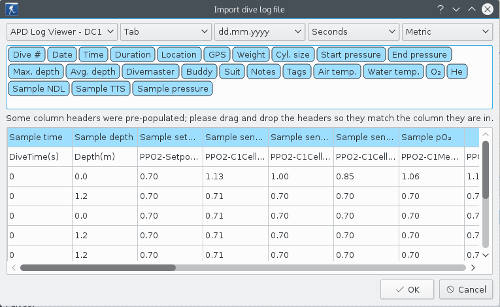
-
The top left hand dropdown box in the import panel lets you select the APD dive computer for which the dive log needs to be imported. The default it is DC1, i.e. the first of the two dive computers the APD uses. It is possible to sequentially import the data for both dive computers by first importing CD1 and then DC2.(Hint: The logs for the two dive computers are viewed by selecting View → Next DC from the Main Menu after the uploading has been completed)
-
Click the Ok button at the bottom of the import panel.
The APD dive log will appear within Subsurface. The dive computer- generated ceiling provided by the Inspiration can be viewed by selecting the appropriate button on the left of the Dive Profile. Cylinder pressure data are not logged by the APD equipment but can be manually entered in the Equipment Tab.
17. APPENDIX C: Exporting Dive log information from external dive log software.
The import of dive log data from external dive log software is mostly performed using the dialogue found by selecting Import from the Main Menu, then clicking on Import Log Files. This is a single-step process, more information about which can be found here. However, in some cases, a two-step process may be required:
-
Export the foreign dive log data to format that is accessible from Subsurface.
-
Import the accessible dive log data into Subsurface.
This appendix provides some information about approaches to export dive log data from foreign dive log software. The procedures below mostly apply to Linux and/or Windows.
17.1. Exporting from Suunto Divemanager (DM3, DM4 or DM5)
|
|
DiveManager is a MS Windows application for Suunto dive computers. Divemanager 3 (DM3) is an older version of the Suunto software. More recent Suunto dive computers use Divemanager version 4 or 5 (DM4 or DM5). The different versions of Divemanager use different methods and different file naming conventions to export dive log data. |
Divemanager 3 (DM3):
-
Start Suunto Divemanager 3 and log in with the name containing the logs
-
Do not start the import wizard to import dives from the dive computer.
-
In the navigation tree on the left side of the program-window, select the appropriate dives.
-
Within the list of dives, select the dives you would like to import later:
-
To select certain dives: hold ctrl and click the dive
-
To select all dives: Select the first dive, hold down shift and select the last dive
-
-
With the dives marked, use the program menu File → Export
-
The export pop-up will show. Within this pop-up, there is one field called Export Path.
-
Click the browse button next to the field Export Path
-
A file-manager like window pops up
-
Navigate to the directory for storing the Divelog.SDE file
-
Optionally change the name of the file for saving
-
Click Save
-
-
Back in the Export pop-up, press the button Export
-
-
The dives are now exported to the file Divelog.SDE.
Divemanager 4 (DM4) and Divemanager 5 (DM5):
DM4 and DM5 use identical mechanisms for exporting dive logs. To export a divelog from Divemanager you need to locate the DM4/DM5 database where the dives are stored. You can either look for the original database or make a backup of the dives. Both methods are described here.
Locating the Suunto DM4 (or DM5) database:
-
Start Suunto DM4/DM5
-
Select Help → About
-
Click Copy after text Copy log folder path to clipboard
-
Ouvrir l’explorateur Windows
-
Paste the address to the path box at the top of the File Explorer
-
The database is called DM4.db or DM5.db
Making a backup copy of the Suunto DM4/DM5 database:
-
Start Suunto DM4/DM5
-
Select File - Create backup
-
From the file menu select the location and name for the backup, we’ll use DM4 (or DM5) in here with the default extension .bak
-
Click Save
-
The dives are now exported to the file DM4.bak (or DM5.bak)
17.2. Exporting from Atomic Logbook
|
|
Atomic Logbook is a Windows software by Atomic Aquatics. It allows downloading of dive information from Cobalt and Cobalt 2 dive computers. The divelog is kept in a SQLite database at C:\ProgramData\AtomicsAquatics\Cobalt-Logbook\Cobalt.db. This file can be directly imported to Subsurface. |
17.3. Exporting from Mares Dive Organiser V2.1
|
|
Mares Dive Organizer is a Windows application. The dive log is kept as a Microsoft SQL Compact Edition database with a .sdf filename extension. The database includes all Dive Organizer-registered divers on the particular computer and all Mares dive computers used. The safest way to get a copy of the dive database is to export the information to another compatible format which can then be imported into Subsurface. |
-
Within Dive Organizer, select Database → Backup from the main menu and back up the database to the desk top. This creates a zipped file DiveOrganizerxxxxx.dbf.
-
Rename the file to DiveOrganizerxxxxx.zip. Inside the zipped directory is a file DiveOrganizer.sdf.
-
Extract the .sdf file from the zipped folder to your Desktop.
-
The password for accessing the .zip file is mares.
17.4. Exporting from DivingLog 5.0 and 6.0
|
|
The best way to bring your logs from DivingLog to Subsurface is to convert the whole database. This is because other export formats do not include all the details, and would lack, for example, gas switches and information of what units are used. With database import, all this information is included and readily available. |
To transfer all files from DivingLog to Subsurface:
-
In DivingLog open the File → Export → SQLite menu
-
Select Settings button
-
Set the RTF2Plaintext to true
-
Close the Settings dialog
-
Click Export button and select the filename
Once this is done, open the saved database file with Subsurface and the dives are automatically converted to Subsurface’s own format. Last step to do is save the log file in Subsurface.
18. ANNEXE D : Exporter un tableur vers le format CSV
De nombreux plongeurs conservent un carnet de plongée sous forme de fichier numérique, souvent un tableur avec différents champs et informations. Ces données peuvent facilement être importées dans Subsurface après que le tableur a été converti en fichier CSV. Cette section explique la procedure pour convertir un carnet de plongée enregistrée sous forme de tableur vers un fichier CSV qui pourra ensuite être importé dans Subsurface. Créer un fichier CSV est simple malgré que la procédure soit différente selon le tableur utilisé.
Organiser les données de plongées dans le tableur pour que la première ligne contienne le nom (ou le titre) de chaque colonne et que les informations de chaque plongée soient contenues sur une seule ligne. Subsurface supporte de nombreux éléments (Dive #, Date, Time, Duration, Location, GPS, Max Depth, Mean Depth, Buddy, Notes, Weight et Tags). Organiser les données de plongées selon quelques règles simples :
-
Date : utiliser un des formats suivants : aaaa-mm-jj, jj.mm.aaaa, mm/jj/aaaa
-
Durée : le format est minutes:secondes.
-
Système d’unité : un seul système d’unité doit être utilisé (pas de mélange entre les unités impériales et métriques)
-
Étiquettes et équipiers : les valeurs doivent être séparées par des virgules.
-
Position GPS : utilisez les degrés décimaux, par exemple : 30.22496 30.821798 === LibreOffice Calc et OpenOffice Calc
These are open source spreadsheet applications forming parts of larger open source office suite applications. The user interaction with LibreOffice and OpenOffice is very similar. In Libreoffice Calc the time format should be set to minutes:seconds - [mm]:ss and dates should be set to one of: yyyy-mm-dd, dd.mm.yyyy, mm/dd/yyyy. A typical dive log may look like this:

To export the data as a .CSV file from within LibreOffice click File → Save As. On the dialogue that comes up, select the Text CSV (.csv) as the file type and select the option Edit filter settings.
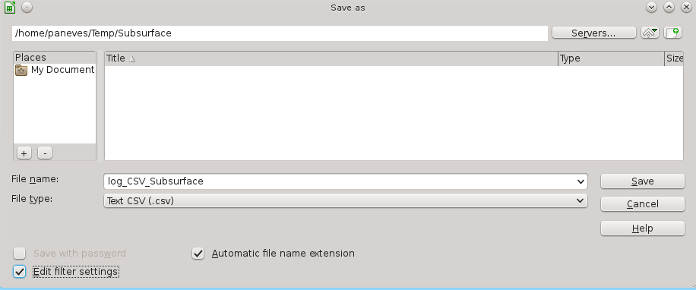
After selecting Save, select the appropriate field delimiter (choose Tab to prevent conflicts with the comma when using this as a decimal point), then select OK.
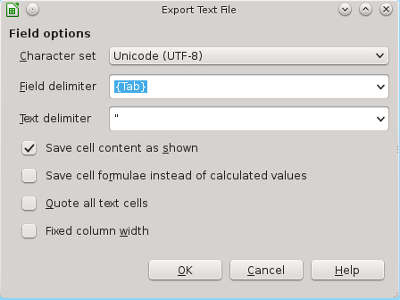
Double check the .CSV file by opening it with a text editor, and then import the dive data as explained on the section Importing CSV dives.
18.1. Microsoft Excel
The field delimiter (called "list separator" in Microsoft manuals) is not accessible from within Excel and needs to be set through the Microsoft Control Panel. After changing the separator character, all software on the Windows machine uses the new character as a separator. You can change the character back to the default character by following the same procedure, outlined below.
-
In Microsoft Windows, click the Start button, then select Control Panel from the list on the right-hand side.
-
Open the Regional and Language Options dialog box.
-
Do one of the following: In Windows 7, click the Formats tab, and then click Customize this format. In Windows XP, click the Regional Options tab, and then click Customize.
-
Type a new separator in the List separator box. To use a TAB-delimited file, type the word TAB in the box.
-
Click OK twice.
Below is an image of the Control Panel:
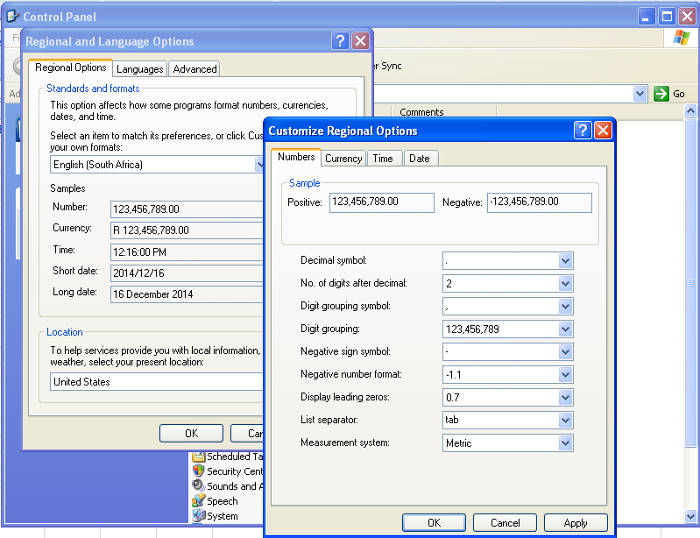
To export the dive log in CSV format:
With the dive log opened in Excel, select the round Windows button at the top left, then Save As.
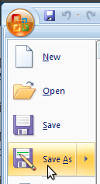
Click on the left-hand part of the Save as option, NOT on the arrow on the right-hand. This brings up a dialogue for saving the spreadsheet in an alternative format. From the dropdown list at the bottom of the dialogue, marked Save as Type:, select CSV(Comma delimited) (*.CSV). Be sure the appropriate folder has been selected to save the CSV file into.
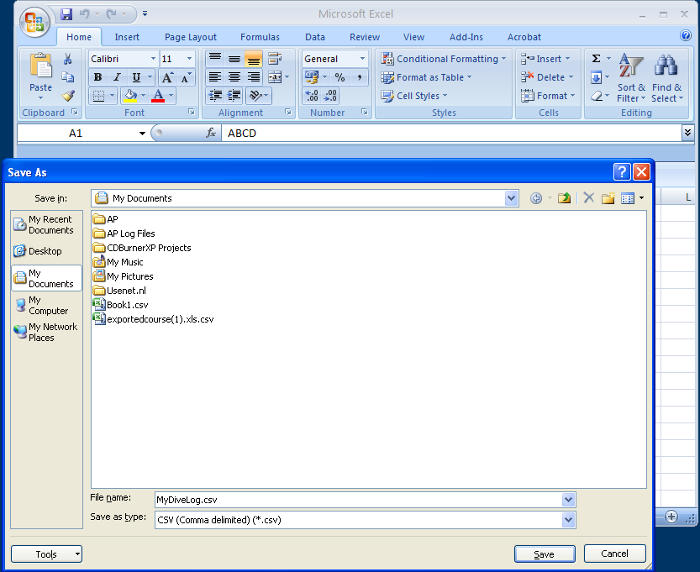
Select the Save button. The CSV-formatted file is saved into the folder that was selected. You can double check the .CSV file by opening it with a text editor, then import the dive data as explained on the section Importing CSV dives.
19. ANNEXE E : Créer un modèle d’impression personnalisé
Subsurface has a way to create or modify templates for printing dive logs to produce customized printouts of them. Templates written in HTML, as well as a simple Grantlee instruction set, are rendered to the print device by Subsurface.
Templates are accessed using the print dialogue (see image B below).

The buttons under the Template dropdown box lets you Edit, Delete, Import and Export templates (see image A above). New or modified templates are stored as HTML files in the same directory as the dive log being processed. In order to create or modify a template, select one of the templates from the template dropdown list in the print dialogue (see image B above). Choose an existing template that resembles the final desired printout. Then select Edit.
The Edit Panel has three tabs:
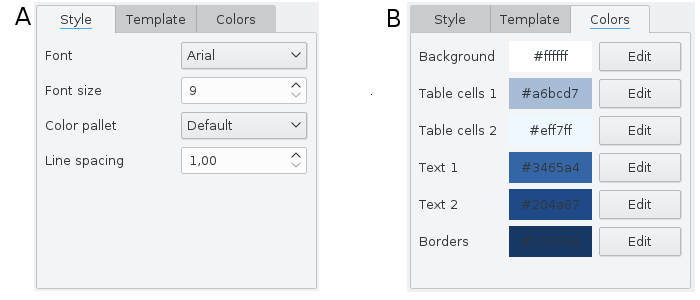
1) The Style tab (image A above) controls the font, line spacing and color template used for printing the dive log. The style attributes are editable. Choose one of the four color palettes used for color printing.
2) The Colors tab (image B above) allows editing the colors used for printing the dive log. The colors are highly customizable: the Edit buttons in the Colors tab allows choosing arbitrary colors for different components of the dive log printout.
3) The Template tab of the Edit Panel (see image below) allows creating a template using HTML as well as a few Grantlee programming primitives. Grantlee can create and format HTML code in a highly simple but efficient way (see below). The HTML of the template can be edited and saved. The saved template is stored in the same directory as the dive being processed. By default, a Custom template is a skeleton with no specific print instructions. The information printed needs to be specified and formatted in the template by replacing the section marked with: "<!-- Template must be filled -→". Writing HTML code with Grantlee instructions allows unlimited freedom in determining what is printed and in which way it should be rendered.
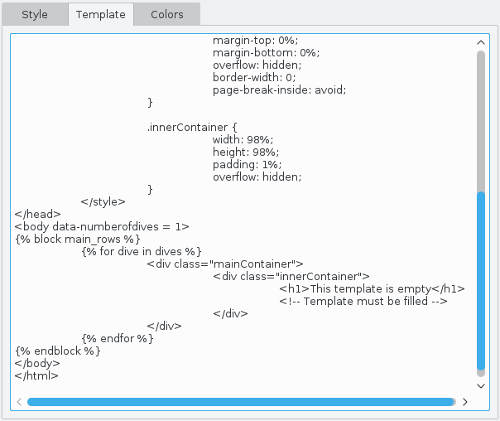
You can adapt any of the existing templates and save it to the dive log directory. The standard templates (e.g. One dive, Six dives, Table) can be modified in this way. After completing the edits, use the Export button in the print dialogue to save the new template using a new template name.
To write a custom template, the following elements must exist so the template will be correctly handled and rendered.
19.1. Main dive loop
Subsurface exports a dive list called (dives) to the Grantlee back end. It is possible to iterate over the list as follows: .template.html
{% for dive in dives %}
<h1> {{ dive.number }} </h1>
{% endfor %} <h1> 1 </h1>
<h1> 2 </h1>
<h1> 3 </h1>Additional information about Grantlee can be found at here
19.2. Grantlee exported variables
Only a subset of the dive data is exported:
Name |
Description |
number |
(int) dive number |
id |
(int) unique dive ID, should be used to fetch the dive profile |
date |
(string) date of the dive |
time |
(string) time of the dive |
location |
(string) location of the dive |
duration |
(string) duration of the dive |
depth |
(string) depth of the dive |
divemaster |
(string) dive master for the dive |
buddy |
(string) buddy for the dive |
airTemp |
(string) air temperature of the dive |
waterTemp |
(string) water temperature of the dive |
notes |
(string) dive notes |
rating |
(int) dive rating which ranges from 0 to 5 |
sac |
(string) SAC value for the dive |
tags |
(string) list of dive tags for the dive |
gas |
(string) list of gases used in the dive |
suit |
(string) the suit used for the dive |
cylinders |
(string) complete information of all used cylinders |
cylinder0-7 |
(string) information about a specific cylinder |
weights |
(string) complete information of all used weight systems |
weight0-5 |
(string) information about a specific weight system |
maxcns |
(string) maxCNS value for the dive |
otu |
(string) OTU value for the dive |
sumWeight |
(string) the summed weight of all used weight systems |
startPressure |
(string) the start pressure |
endPressure |
(string) the end pressure |
firstGas |
(string) first used gas |
Subsurface also exports template_options data. This data must be used as CSS values to provide a dynamically editable template. The exported data is shown in the following table:
Name |
Description |
font |
(string) font family |
borderwidth |
(int) border-width value dynamically calculated as 0.1% of the page width with minimum value of 1px |
font_size |
(double) size of fonts in vw, ranges between 1.0 and 2.0 |
line_spacing |
(double) distance between text lines, ranges between 1.0 and 3.0 |
color1 |
(string) background color |
color2 |
(string) primary table cell color |
color3 |
(string) secondary table cell color |
color4 |
(string) primary text color |
color5 |
(string) secondary text color |
color6 |
(string) border colors |
border-width: {{ template_options.borderwidth }}px; border-width: 3px;Another variable that Subsurface exports is print_options. This variable contains a single member:
Name |
Description |
grayscale |
Use CSS filters to convert the page into grayscale (should be added to body style to enable printing grayscale prints) |
body {
{{ print_options.grayscale }};
} body {
-webkit-filter: grayscale(100%);
}19.3. Defined CSS selectors
As the dive profile is placed after rendering, Subsurface uses special CSS selectors to searche in the HTML output. The CSS selectors in the following table should be added.
Selector |
Type |
Description |
dive_{{ dive.id }} |
id |
is used to fetch the relevant dive profile |
diveProfile |
class |
each dive that will contain a dive profile should have this class selector in addition to the dive_{{ dive.id }} id selector |
dontbreak |
class |
prevents the dive with this class from being divided into two pages. This can be used in flow layout templates only (when data-numberofdives = 0) |
|
|
Rendering dive profiles is not supported for flow layout templates (when data-numberofdives = 0). |
19.4. Special attributes
There are two ways of rendering- either rendering a specific number of dives in each page or make Subsurface try to fit as many dives as possible into one page (flow rendering).
The data-numberofdives data attribute is added to the body tag to set the rendering mode.
-
render 6 dives per page:
<body data-numberofdives = 6>-
render as much dives as possible:
<body data-numberofdives = 0>|
|
All CSS units should be in relative lengths only, to support printing on any page size. |
20. APPENDIX F: FAQs.
20.1. Subsurface appears to miscalculate gas consumption and SAC
Question: I dived with a 12.2 l tank, starting with 220 bar and ending with 100 bar, and I calculate a different SAC compared what Subsurface calculates. Is Subsurface miscalculating?
Answer: Not really. What happens is that Subsurface actually calculates
gas consumption differently - and better - than you expect. In particular,
it takes the incompressibility of the gas into account. Traditionally, gas
consumption and SAC should be: consumption = tank size x (start pressure -
end pressure)
and that’s true for an ideal gas, and it’s what you get taught in dive theory. But an "ideal gas" doesn’t actually exist, and real gases actually don’t compress linearly with pressure. Also, you are missing the fact that one atmosphere of pressure isn’t actually one bar. So the real calculation is:
consumption = (amount_of_air_at_beginning - amount_of_air_at_end)
where the amount of air is not just "tank size times pressure in bar". It’s a combination of: "take compressibility into account" (which is a fairly small issue under 220 bar - you’ll see more differences when you do high-pressure tanks with 300bar) and "convert bar to atm" (which is the majority of your discrepancy). Remember: one ATM is ~1.013 bar, so without the compressibility, your gas use is:
12.2*((220-100)/1.013)
which is about 1445, not 1464. So there was 19 l too much in your simple calculation that ignored the difference between 1 bar and one ATM. The compressibility does show up above 200 bar, and takes that 1445 down about eight litres more, so you really did use only about 1437 l of air at surface pressure.
So be happy: your SAC really is better than your calculations indicated. Or be sad: your cylinder contains less air than you thought it did. And as mentioned, the "contains less air than you thought it did" really starts becoming much more noticeable at high pressure. A 400 bar really does not contain twice as much air as a 200 bar one. At lower pressures, air acts pretty much like an ideal gas.
20.2. Some dive profiles have time discrepancies with the recorded samples from my dive computer…
Subsurface ends up ignoring surface time for many things (average depth, divetime, SAC, etc). Question: Why do dive durations in my dive computer differ from that given by Subsurface?
Answer: For example, if you end up doing a weight check (deep enough to trigger the "dive started") but then come back up and wait five minutes for your buddies, your dive computer may say that your dive is 50 minutes long - because you have fifty minutes worth of samples - but subsurface will say it’s 45 minutes - because you were actually diving for 45 minutes. It’s even more noticeable if you do things like divemastering the initial OW dives, when you may stay in the water for a long time, but spend most of it at the surface. And then you don’t want that to count as some kind of long dive”.
20.3. Some dive profiles are missing from the download
Question: I cannot download all my dives, only the most recent ones, even though my dive computer’s manual states that it records history of e.g. 999 dives? Answer: Dive history is different than the dive profiles on the log. The history only keeps track of the total number of dives and total amount of time spent below surface. The logs, on the other hand, store the dive profile, but they have a limited amount of memory to do so. The exact amount of dive profiles that can be stored on the device depends on sample interval and duration of the dives. Once the memory is full the oldest dives get overwritten with new dives. Thus we are only able to download the last 13, 30 or 199 dives.
If you have downloaded your dives to different dive logging software before they were overwritten, there is a good chance that Subsurface can import these. However, if the logs are only on your dive computer, they cannot be salvaged after being overwritten by new dives.